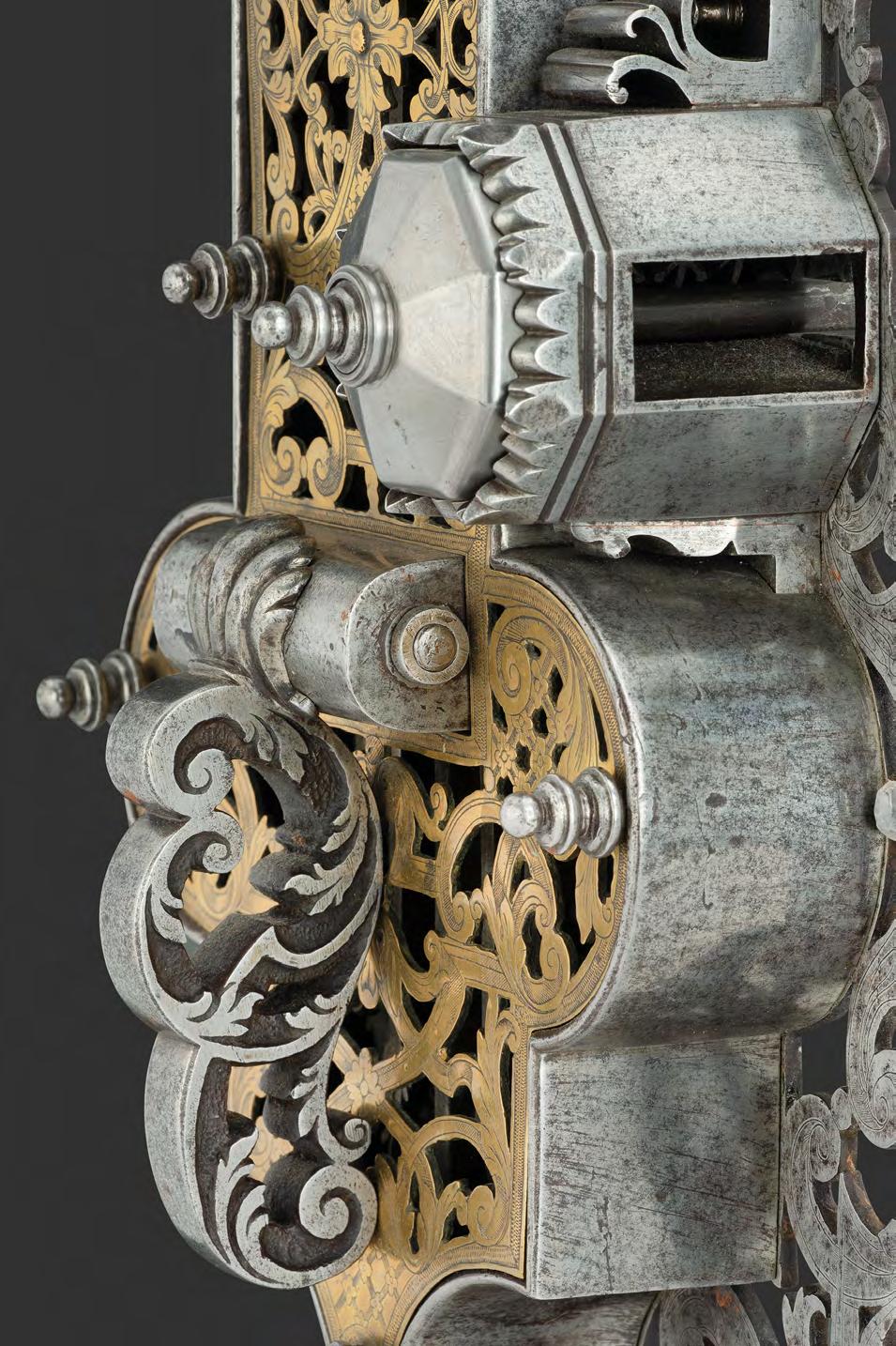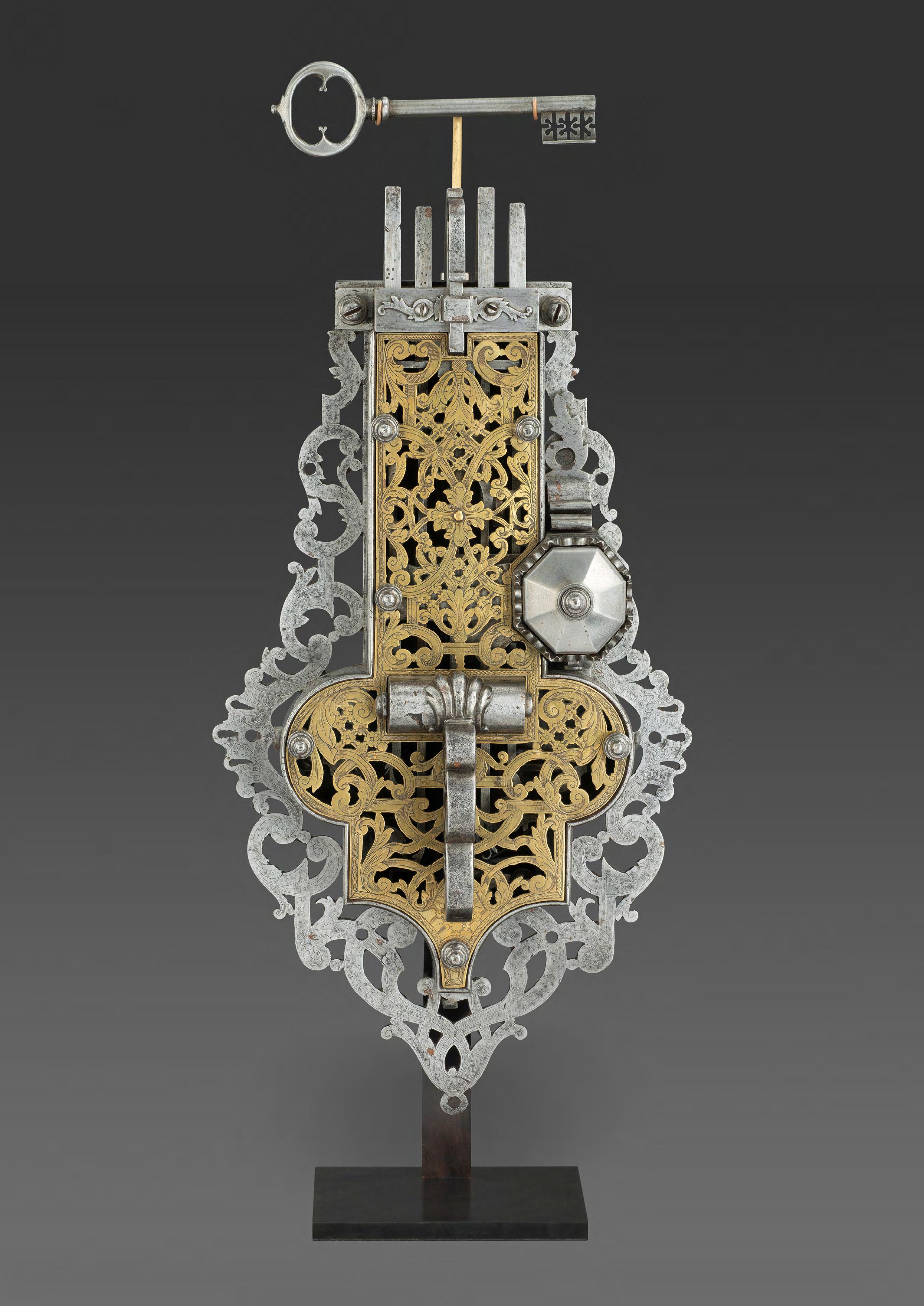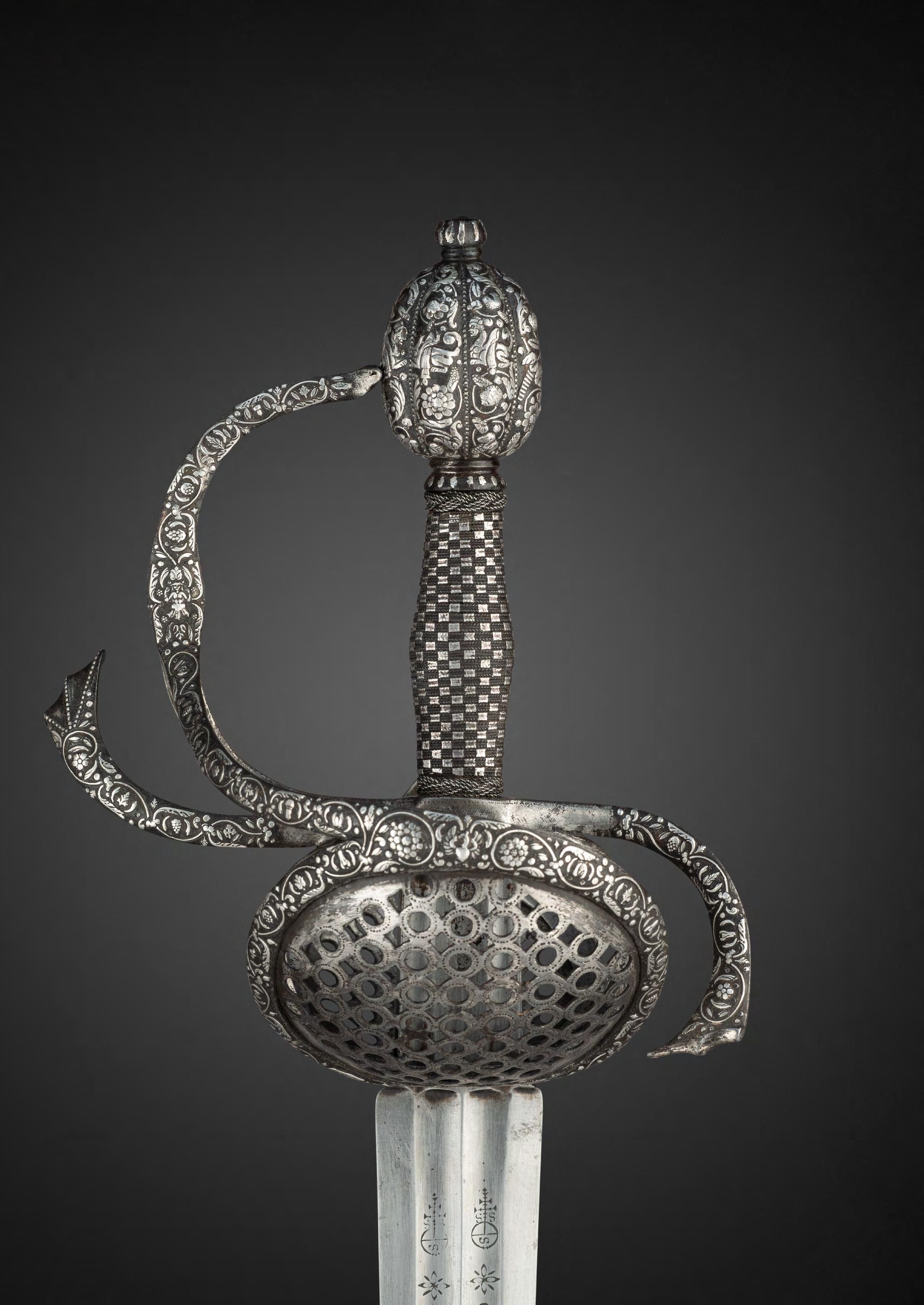

PETER FINER
FINE ANTIQUE ARMS, ARMOUR & RELATED OBJECTS
ARMOUR


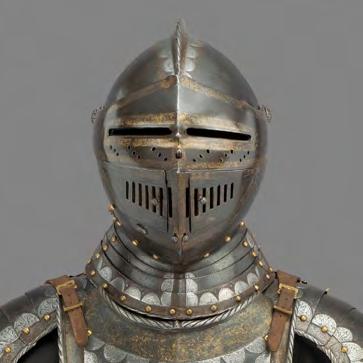

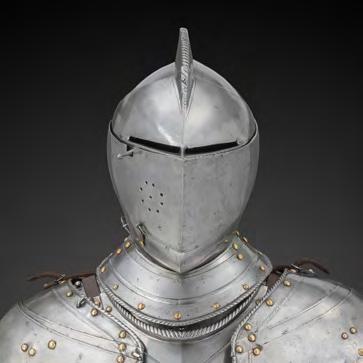
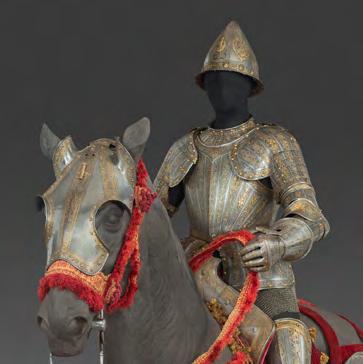
1 An Extremely Rare Pair of Saddle Swipe-Guards (Dilgen ) for use in the ‘Joust of War’ (Rennen )
c. 1500 – 1510
2 A Flemish Shaffron
c. 1520 – 30
3 An Important Armour attributed to the Habsburg Court Armourer Desiderius Helmschmid and the etcher Jörg Sorg dated 1545
4 A Rare Breastplate for Foot or Light Calvary Armour
c. 1550 – 60
5 A Cavalry Half-Armour
c. 1560 – 70
6 A Suite of Magnificent Armour for Man and Horse, Etched and Gilt in the Lombard Fashion Late 16th Century


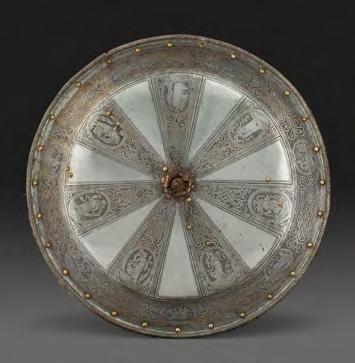


7 A Very Rare Milanese Etched Breastplate charged with an Armorial Cross, for a Light Cavalry or Foot Service Armour, Inspired by the Etched Motifs of Pompeo della Cesa
c. 1580-1600
8 A Half-Armour of Blued Steel
c. 1580 – 1600
9 A North Italian Etched Circular Shield for Foot Service in the Manner of Pompeo della Cesa
c. 1580 – 90
10 A Fine Cuirassier Three-quarter Armour in the Manner of the ‘Master MP’
c. 1600 – 1620
11 A Model of an Armour for a Man and Horse in the 16th Century Style
c. 1850
An Extremely Rare Pair of Saddle
Swipe-Guards (Dilgen ) for use in the ‘Joust of War’ (Rennen )
c. 1500 – 1510
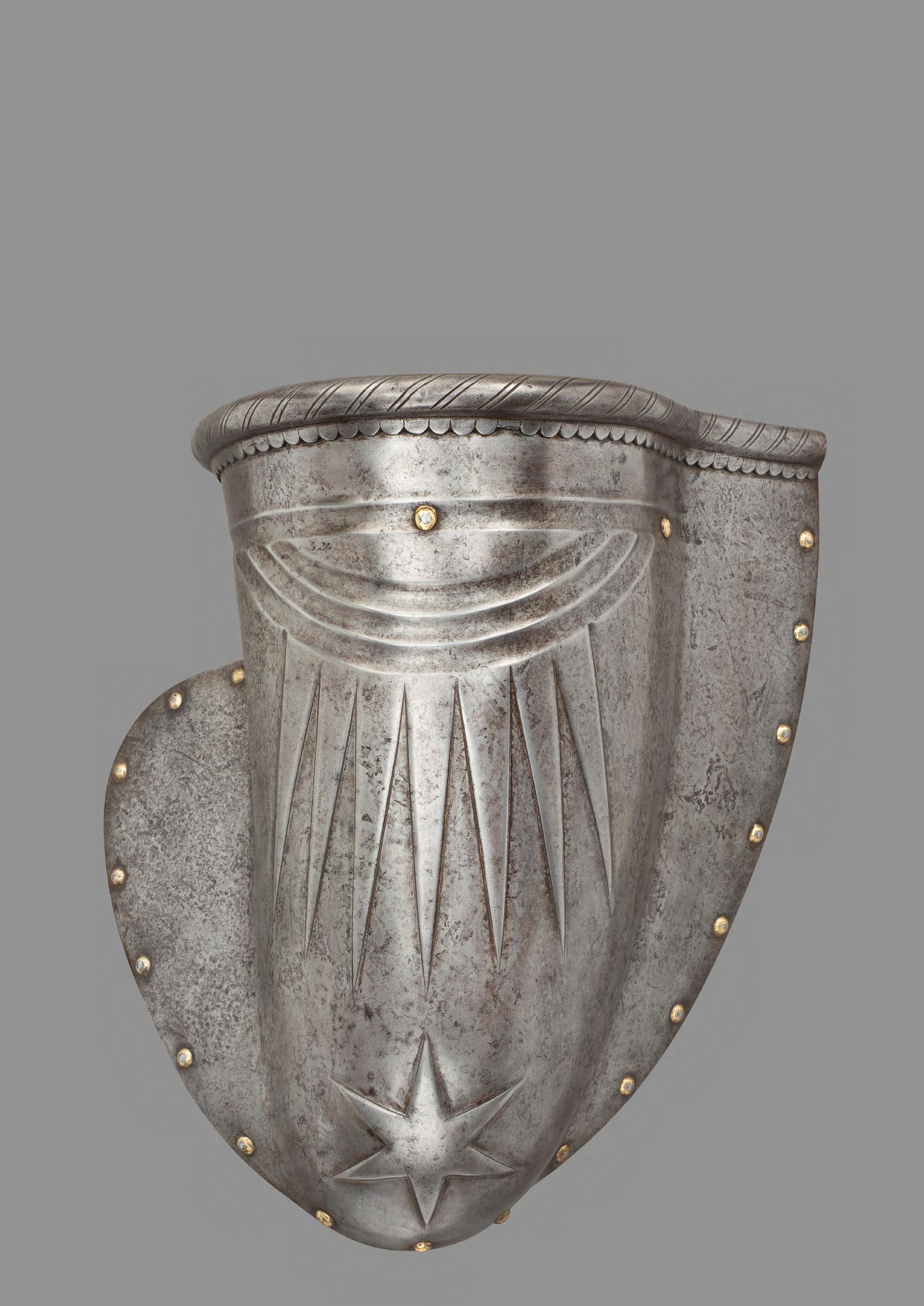
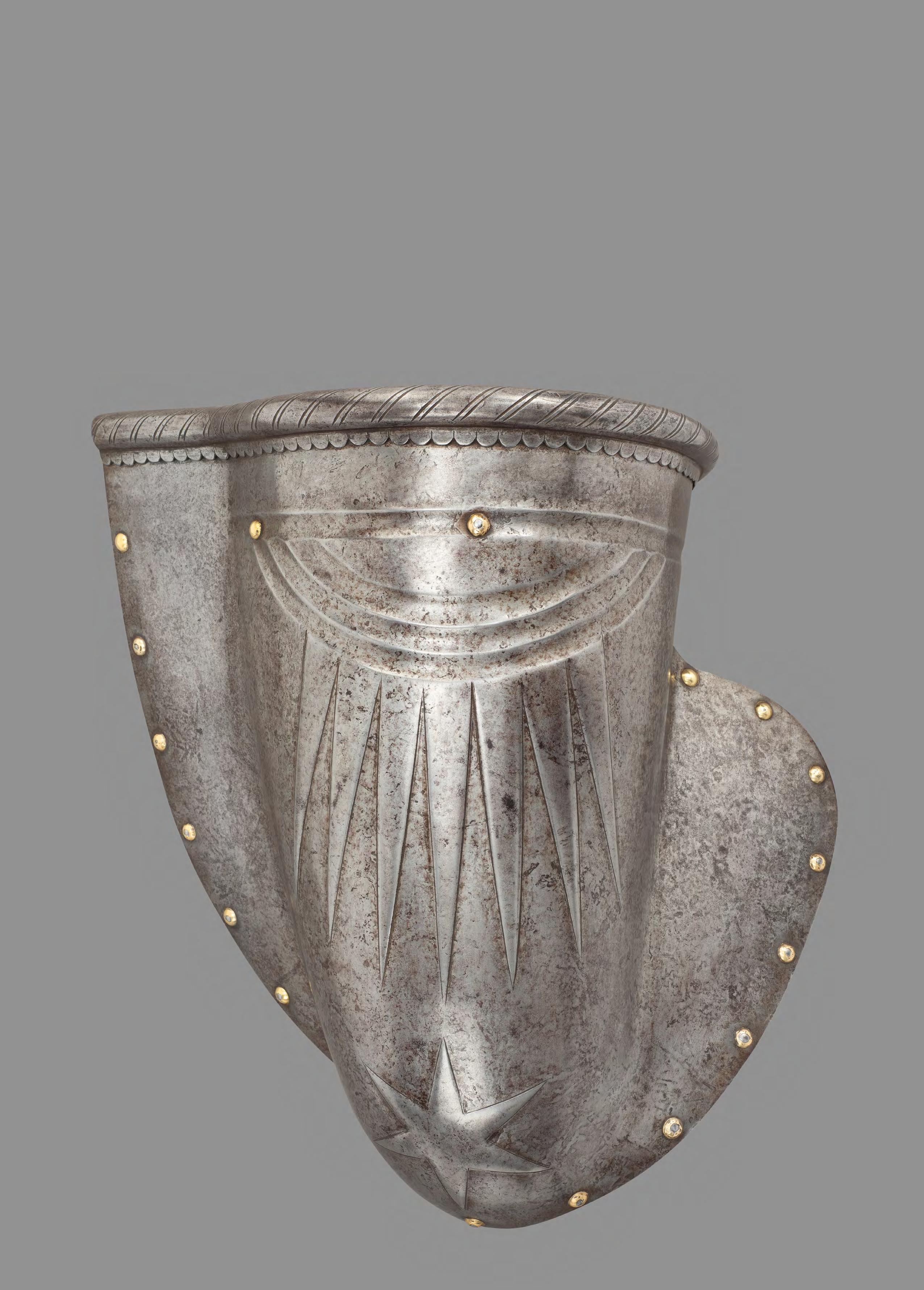
Southern Germany, Augsburg or Innsbruck. Steel, copper alloy, leather.
42 cm × 40 cm / 16.5 in × 15.7 in (each)
PROVENANCE
Possibly the Armoury of the Court of the Emperor Maximilian I
Private collection, Austria
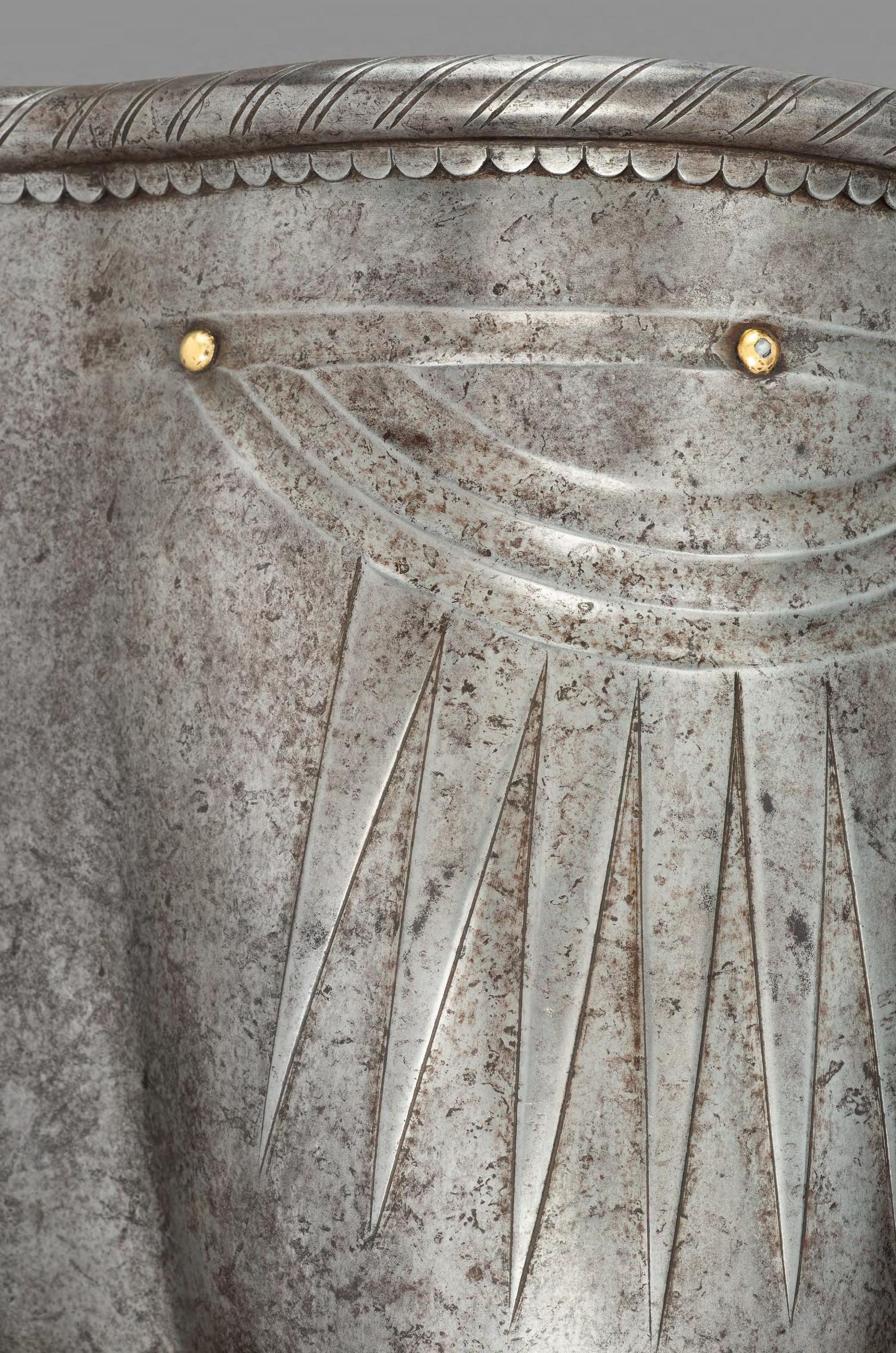
The German tourney course with sharp lances, known as the Rennen (the mock ‘joust of war’), had evolved in the mid-15th century (from its first mention in 1436) and over successive decades existed in ever more numerous versions, as dictated by their differing objectives and rules, but all of these were run in the Lists without a tilt or barrier separating the riders. The contests were fast-moving (Rennen translates as ‘run’ or ‘race’), warlike in character and unfailingly spectacular. Among the more frequently practiced Rennen courses as many as seven eventual types were in fact fought without leg armour, other than tassets defending the thighs, and in some configurations a Rennzeug (Rennen armour) comprised the torso, head and arm portions only. Only a few exceptions such as the Feldrennen or Kampfrennen existed, in which reinforced field armour with full leg defences was worn.
The danger of jousting without a dividing tilt was to some degree of course the increased exposure to the opposing lance (the specialist armour provided good protection for the upper body, and the lance-points were often purposefully biased in order to deflect). The far greater danger in fact lay in the possibility
of the opponent’s horse passing too narrowly and seriously injuring the legs and perhaps the horse of the on-coming rider. This danger was not confined to the on-coming rider’s left side (the side intended to receive the lance impact) since a horse may startle and mistakenly bolt down the right side also.
To address this in the Rennen fought without leg armour, after about 1460 pairs of graze shields were suspended from the saddle, hung at a level covering the thighs and knees. Initially probably made of either hardened leather or wood, by about 148085 these had developed as steel ovoid or rounded shields referred to as ‘Streiftartschen’ (derived from the German ‘streifen’, to graze, known in English only by the misnomer ‘tilting sockets’). Several examples dating from circa 1485 survive in the Kunsthistorisches museum, Vienna, including one commissioned by the emperor in 1485 from the court armourer Lorenz Helmschmid of Augsburg (B 11).
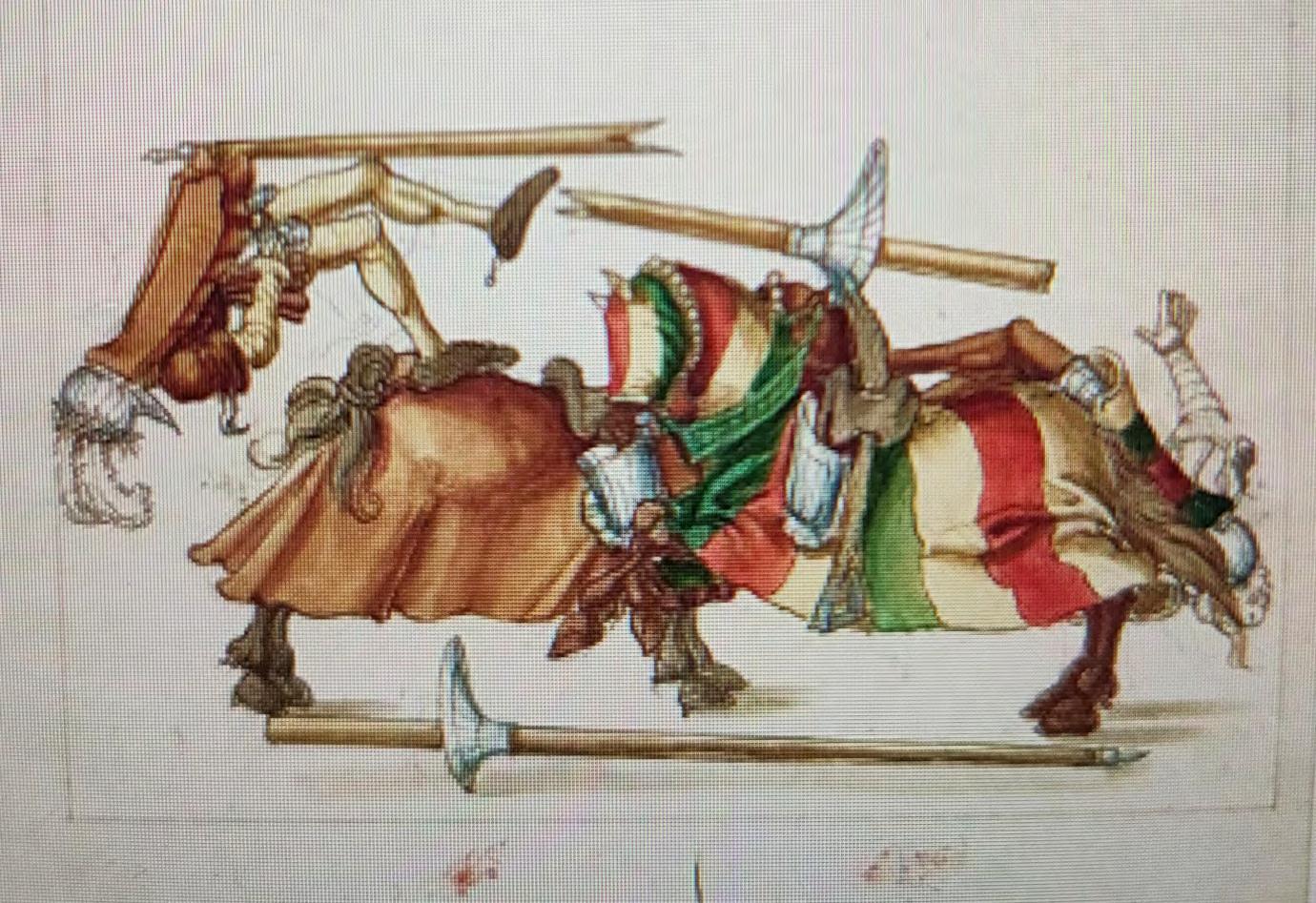
Joust of War between Christoph Lamberger and Freydal (Maximilian himself), from a plate in ‘Freydal’, circa 1512-15. Note the separately worn Dilgen remaining suspended in place.
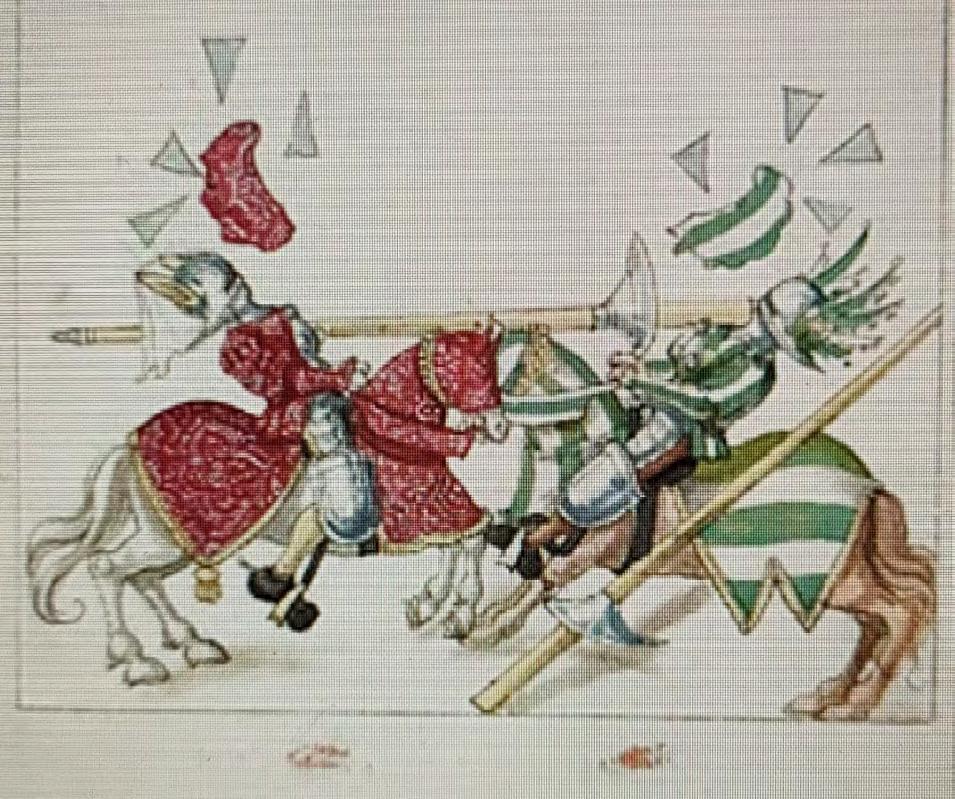
Another example from the same work of 1512-15.
By about 1490-1500 the relatively flat Streiftartsche had evolved to a shape better fitting the thigh and the knee, and in this ergonomic form were referred to as ‘Dilgen’ (sing. Dilge) within the early 16th century.
As previously, Dilgen such as the present pair were constructed to be suspended on either side of the saddle, but now to sit broadly over the thighs and knees. As such, the more compact size and shape of the present examples represent the optimum point of development. They were not elements of body armour attached to the rider; as if verification of this were needed, illustrations in contemporary ‘tournament books’ (the superb miniatures of Maximilian’s ‘Freydal’ for example) include multiple dramatic records of competitors in one or other form of the Rennen hurled rearward out of the saddle by the impact of an opponent’s lance, while the Dilgen remain in their correctly suspended position at the saddle.
It would appear that surviving examples of Dilgen are limited to those with historic connection to the Habsburg imperial court, seat of the foremost exponent and patron of the tournament, the Emperor Maximilian I (1459-1519, King of the Romans from 1486, Holy Roman Emperor from 1508).
Several pairs of Dilgen compare closely with the pair under present discussion, sharing not only their unique ergonomic form but their embossed and fluted decoration also.
A fine example is the pair forming a part of the Rennzeug made in about 1494, displayed in the Royal Armouries Leeds (II. 167 n-m). This pair belong to one of several such armours with Dilgen known to have been commissioned by the Emperor Maximilian I for his own use and that of his guests. Originally in the former imperial collection, this armour and its Dilgen were deaccessioned by the Kunsthistorisches Museum in Vienna in about 1935. The complete set was subsequently included in an auction held by Galerie Fischer in Zurich and acquired by William Randolf Hearst; the armour was in turn purchased by the Royal Armouries in 1952.
Both this and the present pair are decorated immediately beneath the upper border with an embossed inverted arc of three flutes, from below which radiates a so-called ‘wolf’s teeth’ pattern, popular among the court armourers of Augsburg and Innsbruck in the late 15th and early 16th century.
The present examples are additionally embossed with a six-pointed star over the knee. This may be either a decorative feature, or plausibly the heraldic emblem central to the coat-of-arms of the original owner.
The borders surrounding the present Dilgen are studded with brass-capped lining rivets and retain fragments of the original lining-straps on the insides.
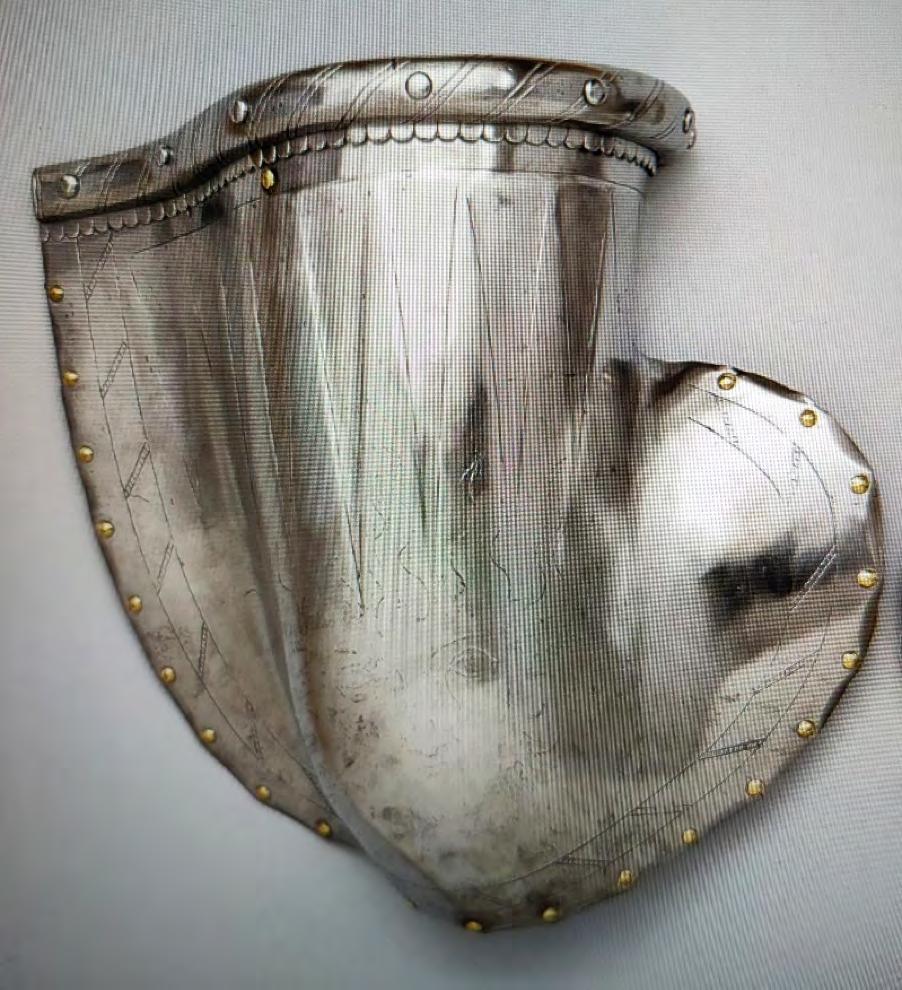
Another pair, ascribed to Southern Germany, circa 1500, is in the Hofjagd- und Rüstkammer, of the Kunsthistorisches Museum, Vienna (B 174c). Closely related to the present pair and to the pair in the Royal Armouries, these are again characterised by their pronounced ergonomic shape, sharing again the broad band of ‘wolf’s teeth’ ornament embossed across the central area. A particular feature of these, seen also in the present Dilgen, is the strong protective raised, incised cabled flange which is rivetted about the upper edge of the thigh. This would presumably have been intended to prevent a stray lance point from deflecting up the thigh.
Another pair, also in Vienna (B 16a) and also comparable to the present examples are ascribed to circa 1515, made by Konrad Seusenhofer, founder of the imperial armour workshops in Innsbruck in 1504.
Among a range of other armour of this brief period which includes this distinctive ‘wolf’s teeth’ style of embossed ornament is the visor of a close helmet for a boy, possibly Innsbruck, circa 1505, in The Philadelphia Museum of Art (1977- 167-81); the horse armour of Georg von Stubenberg-Wurmberg, attributed to the Hapsburg court armourer Konrad Seusenhofer of Innsbruck, circa 1505-10, removed to the Landeszueghaus collection in Graz (57.1); and the Innsbruck globose cuirass, circa 1510, again in the Royal Armouries, Leeds (III. 1246).
As far as can reasonably be determined, the present pair are possibly unique in private ownership, surviving pieces being understandably depleted by successive fashionable developments in the joust, ultimately leading to the redundancy of this type of armour and it being discarded from noble armouries throughout the territories of The Holy Roman Empire. One known exception exists within the historic von Matsch / von Trapp armoury at Schloss Churburg in the Tyrol, in the form of a pair of Streiftartschen, mentioned previously as the forerunners of Dilgen, made by the Habsburg court armourer Adrian Treitz (Treytz) of Mülau, near Innsbruck.
One of the pair of dilgen in Vienna (B 174c) referenced above.
A Flemish Shaffron
c. 1520 – 30
Belgium, Flanders. Steel, brass
67 cm × 30 cm / 26.4 in × 11.8 in
PROVENANCE
Private collection, Europe
This shaffron is of a distinctively Flemish fashion of about 1520-30. It relates to, and may possibly derive from, a large quantity of Flemish horse armour imported into England in the time of King Henry VIII and stored in the Tower of London Armouries in readiness for its use by his cavalry.
In the late 15th and early 16th centuries Flanders rivalled Northern Italy and Southern Germany as a major centre for European armour-production. Although the armourers of Flanders like those of much of Europe looked to Northern Italy and Milan in particular, to provide the models for their own styles, they tended to adapt those models to Northern European tastes by introducing forms and decorative details that imbued them with a recognisable character of their own.
The earliest surviving shaffron to which a Flemish origin can confidently be assigned is one in the Real Armeria, Madrid (cat. no. A. 11), associated with an armour of the Flemish-born Philip I, “the Handsome”, King of Castile (1478-1504-1506), which bears the mark of an unidentified armourer known to have worked for him in Flanders. The shaffron, moreover, bears engraved decoration from the hand of Paul van Vrelant of Brussels, which was perhaps applied in 1505 when he was paid for the decoration of various items of equestrian equipment for the King. Very close to it in style, and therefore presumably in date as well, is an undecorated shaffron in the same collection (cat. no. F, 110).
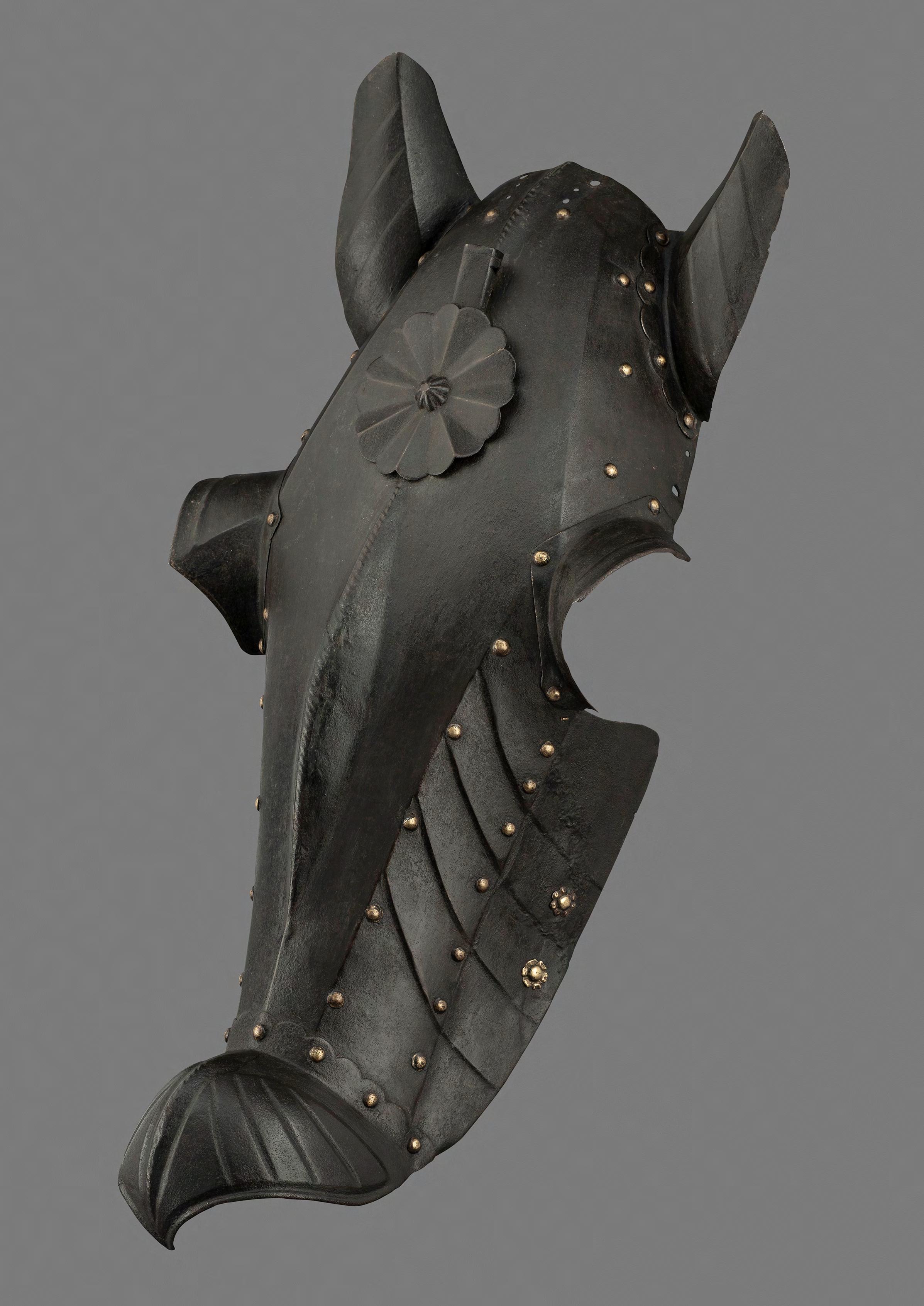
Of a somewhat later date than the latter but once again decorated by van Vrelant of Brussels are further two shaffrons in the Real Armeria, Madrid (cat. nos F. 111-12), which were almost certainly among six that van Vrelant was paid for decorating in 1520 for the Emperor Charles V, son of Philip the Handsome, and like the latter, born in Flanders.
Very similar in style to them are two undecorated shaffrons in the Real Armeria, Madrid, each forming part of a complete horse armour bearing the mark of the Flemish armourer Guillem Margot, who is recorded a having worked between 1494 and 1530 for Philip the Handsome, Charles V and the latter’s younger brother Archduke Ferdinand, who for a time served as governor of the Burgundian Low Countries. Records show that horse armours formed a significant part of Guillem Margot’s output.
Two further horse armours bearing Margot’s mark are among the remains of the personal armoury of King Henry VIII of England, preserved in the Royal Armouries at the Tower of London. Both are decorated by Paul van Vreland. One of them may have formed part of a gift of armour made to the King by the Emperor Maximilian I in 1514, while the other appears to have been decorated by van Vreland in England between 1514, when he took up employment with the King, and 1519.
Flemish armour was evidently much appreciated in England around that time, as is shown by the fact that in 1511 King Henry brought over to the country to work for him in a royal workshop that he set up in his Palace of Greenwich, two armourers from Brussels: Copyn de Watt and Peter Fevers.
However, much munition armour of Flemish make was also imported into England in Henry’s time, including substantial quantities of horse armour that are still seen in part among the remains of the former national arsenal of the Tower of London, and are now distributed between there, the Royal Armouries Museum, Leeds, Windsor Castle and Hampton Court. Shaffrons form a significant part of those remains.
Viewed collectively, they show a clear relationship in both form and detail to the Flemish examples in Madrid discussed above. Persistent among their features are the boxing of their sides, and the decoration of those sides and the ear-defences with cascaded fluting of the kind seen on the shaffron under discussion. Although some of the Henrician shaffrons are likely from their close resemblance to the Philip the Handsome example of c. 1505 discussed above to date from the earliest years of the King’s reign (1509-47), others of a bolder form and with boldly roped edges clearly date from a later part of it.
What appears to be the latest of them, inv. no. VI. 35 in the Royal Armouries Museum, Leeds, is also that which most closely resembles the example under discussion. It, like the latter is boxed at each side, decorated over the nose with a roped medial ridge, fitted with separate defences for the ears, the nose, and formerly the eyes, and is ornamented at the brow with a small, radially fluted roundel. Even more similar to the example under discussion is one formerly in the collections of the Baron C. A. de Cosson at Pyrcroft, Chertsey, Surrey, and Sir Edward Barry at Ockwells Manor, Bray, Berkshire. It shows not only the same cascaded fluting on its sides and ear-defences, but also the same very distinctive fluted decoration on its prominent nose-defence. Exhibiting many of these same features is a shaffron formerly in the collection of Alfred W. Cox of Glendoick, Perthshire. The fact that both the Barry and Cox shaffrons had an English provenance raises the very real possibility that they may have been sold from the Tower of London’s overcrowded storerooms - often simply as old iron – in the 18th and 19th centuries. It is not impossible that the markedly similar shaffrons in the Cleveland Museum of Art, Ohio, and the Museo Civico Medievale di Bologna might have shared that origin. Aside from having fixed rather than separately applied eye-defences, the Bologna example is almost the twin of the example under discussion.
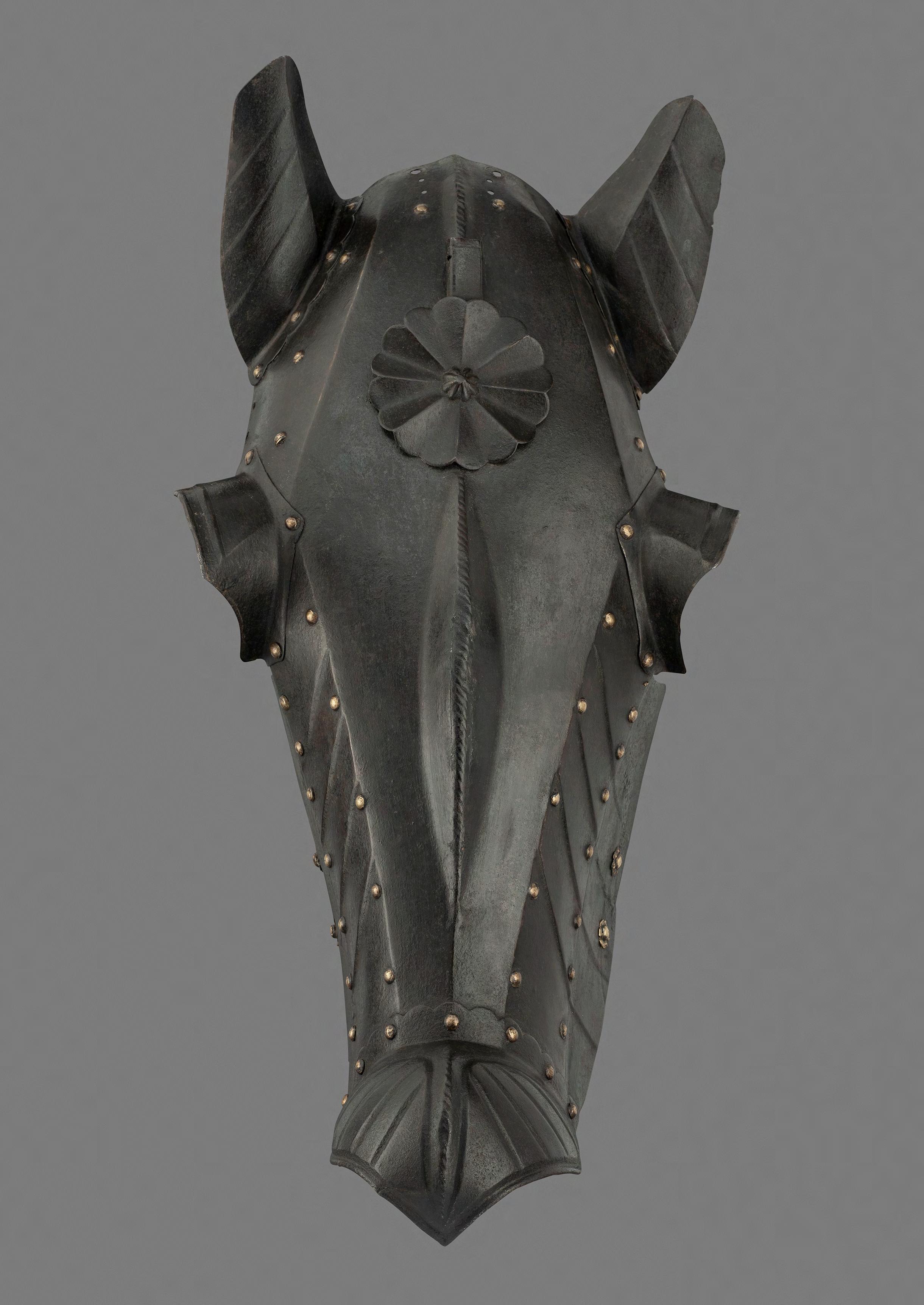
An Important Armour attributed to the Habsburg Court
Armourer Desiderius Helmschmid and the etcher Jörg Sorg
dated 1545
Germany, Augsburg. Steel, gold, copper alloy, leather. The gorget, shoulder plates and lance-rest later. Minor restorations, including refreshing to the etching and gilding.
PROVENANCE
Private Collection, Florence, Italy
The Charles Hummel collection, Genoa
Included in the subsequent auction sale of the collection in Gênes (Genoa), lot 6, pl. XIV, May 1908
Sold Gallerie Fischer, Lucerne, August 18-20th 1931
Purchased by Hans von Schulthess (1885-1951), Schloss Au, n. Zurich, likely acquired at the 1931 Gallerie Fischer sale
Included in the private sale of the von Schulthess Collection by his heirs, 2008
Included in the private sale of the von Schulthess Collection by his heirs, 2008. This armour is likely the earliest known collaboration between Desiderius Helmschmid, court armourer to the Emperor Charles V, and the etcher Jörg (II) Sorg, acclaimed masters of their respective disciplines working in Augsburg in the 16th century. The armour is etched on the helmet visor with the date 1545, the year of its completion, which pre-dates by three years the previously held start of their collaboration.
Desiderius Helmschmid (1513-79) was a member of a dynastic family of armourers working with distinction in Augsburg and Vienna, in the service of the Habsburg emperors and the nobility of their courts. His great-grandfather, Jörg the elder, was armourer to the Emperors Friedrichs III and Maximilian I. His grandfather, Lorenz, inherited the latter appointment and his father, Koloman, was in turn armourer to the Emperor Charles V. Katharina (1508-53), the sister of Desiderius, married the etcher Jörg Sorg the elder in 1520, and it was his son of the same name who later worked in association with Desiderius.
LITERATURE
Mario Scalini, ‘Autography problems and study of Renaissance armours: additions to the Helmschmid family and Mattäus Frauenpreiss catalogues’, p.66, fig.9, in A farewell to Arms, studies on the history of Arms and Armour, Legermuseum, Delft, 2004
The Sorg family of etchers and painters (maler ) formed a similar artisanal dynasty, beginning in 1457. Jörg the elder (1481-1565) and his wife Katharina, were the parents of Jörg the younger (1522-1603), who is recorded as a Master etcher in 1548.
Another and equally valid route has been study of the armours known to have been decorated by Jörg Sorg, and more specifically those for which Sorg was engaged by Helmschmid to etch. In examining Sorg’s decorative treatment of these we have made comparisons with the etching of the present armour, particularly those armours etched with the ‘luntte’ or ‘schuppen und ranken’ pattern which dominates both the present armour and a small number of others acknowledged to be Sorg’s work.

In looking at Sorg’s etching we are assisted by his own ‘Harnisch-Musterbuch’, his personal finely illustrated record of the armours he worked on, detailing in his hand also who they were made for and importantly to us, providing the names of the master armourers who made them. Sorg’s records clearly reveal the measure of his ability, in that parallel with Desiderius Helmschmid he was also employed by many of the foremost armourers of the day.
The original Musterbuch codex is lodged in the Württembergischen Landesbibliothek in Stuttgart, but fortunately the full series of superb watercolour drawings and Sorg’s accompanying notes have been reproduced in a volume published in 1980, together with modern scholarly commentary. Less convenient, given that the present armour was completed in 1545, is that Sorg’s record begins only in 1548, the year in which he is recorded as becoming a Master etcher.
This chronological gap is first bridged by looking at Sorg’s record of an armour made by Hans Luzenberger in 1550, for a member of the Spanish Habsburg court (see MS. fol. 11 v, plate 40). This gives a clear image of the lunette pattern, complete with the small scrollwork designs which individually fill the nodules in the design, and which form part of the lunette pattern on the present armour.
Further comparison is offered by Sorg of a garniture comprising four armour designs, successively for the foot tournament, the tilt at the barrier and two field armours. This elaborate garniture was made by Helmschmid in 1552, for Ludwig Ungnad von Weissenwolf auf Sunegg, Freiherr zu Sanegck, a senior officer of the Habsburg court, active 154266 (see MS. fol. 22 v 23 and 24, number 80). With the exception of the tilt armour, the three remaining manuscript illustrations display the lunette pattern as being closely related to the overall corresponding
design on the present armour, albeit lacking the augmentation of the small scrollwork designs and projecting sprigs which are an additional etched detail of the present armour. Given the minute scale of this last feature its omission may perhaps have been an oversight on the part of the manuscript draughtsman.
A survey of surviving armour constructed and etched in the manner of Helmschmid and Sorg includes several detached elements in institutional collections. The first of these is a detached couter (elbow defence) in the von Kienbusch Collection of The Philadelphia Museum of Art (cat.no. 190). This belongs to the same armour as the cuff of a right gauntlet and the front and rear lame of a gorget in The Metropolitan Museum of Art, New York (29.158. 329 and 389).
A strong example is a light field armour in The John Woodman Higgins Armory, Worcester, Massachusetts (JWHA 2582). This is compared in the catalogue to the work of Desiderius Helmschmid and Jörg Sorg, and once again conforms quite closely to the embossed and etched decoration of the present armour; the catalogue draws attention also to a matching left cuisse (thigh defence) in the Victoria and Albert Museum, London. The Higgins catalogue entry further invites comparison with the ‘Mühlberg’ armour of Charles V, the exchange close helmet included in its garniture has particular relevance to present armour.
The attribution of the present armour to Helmschmid is made based on close similarities between its construction style and constructional characteristics in Helmschmid’s acknowledged works. Two elements of the present armour offer the most compelling evidence: these are the close helmet, and the specific construction of its visor and upper-bevor, and the concealed lance-rest mounted on the breastplate.
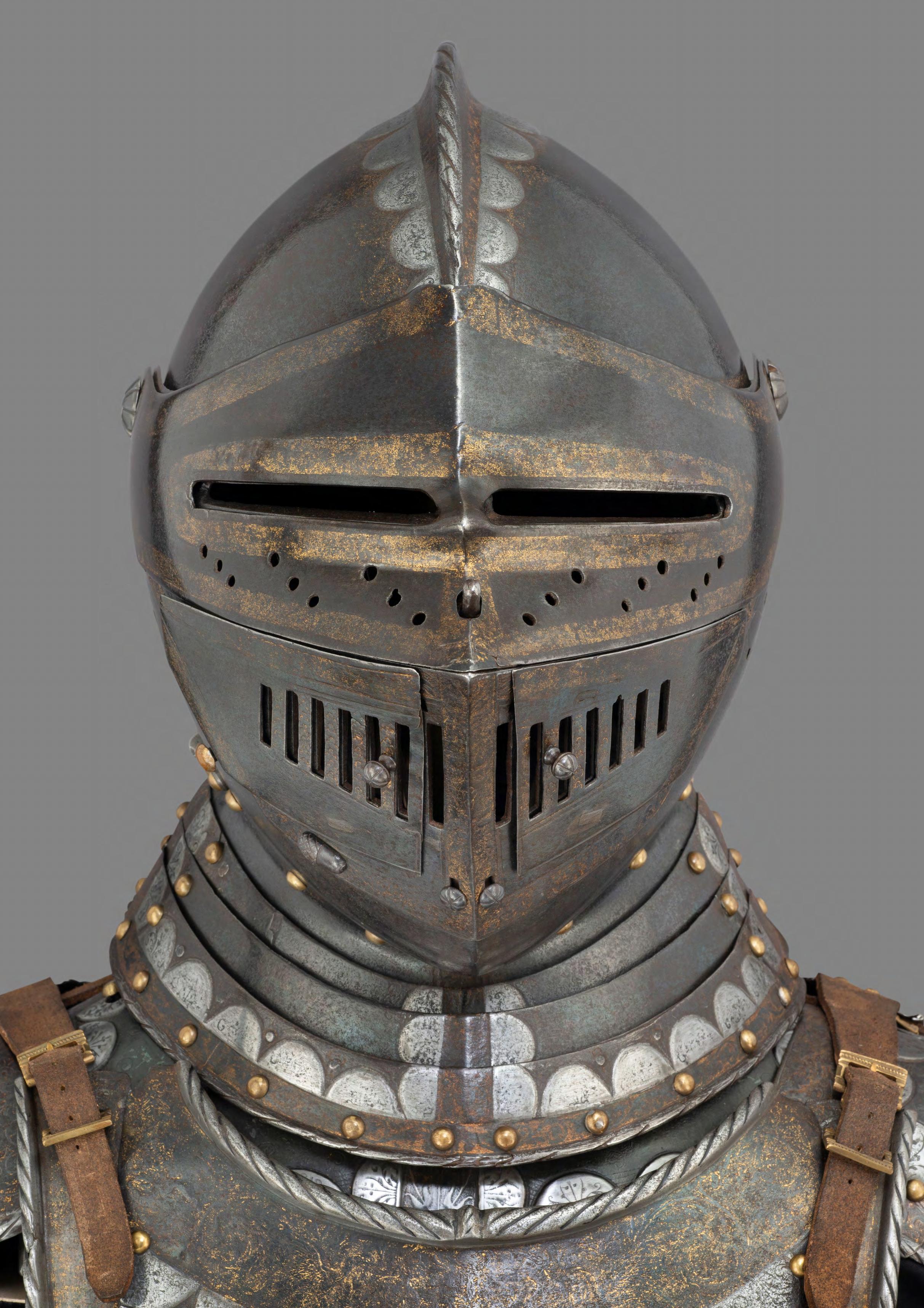
In terms of its construction, the present helmet compares particularly closely with the helmet made by Desiderius Helmschmid as a part of the Mühlberg garniture of Charles V. Below the sophisticated double visor, a spring-loaded system of pierced slotted plates shoots rearward to reveal corresponding ventilation slots now open on the left- and right-hand sides of the upper-bevor. Moving on internal spring-catches left and right, the plates are released from their forward closed position by the touch of a projecting button on either side. This ingenious device is extremely rare, and quite possibly exists on no other helmets save the examples of the present armour and the Mühlberg, each a very close constructional, near-twinned match throughout.
The lance-rest on the breastplate of the present armour is again a very rarely seen device of great ingenuity. The arm of the rest is straight in plan and may be pushed back into the breast-plate to form a concealed fit entirely flush with the now streamlined armour surface. The release spring-catch is formed as a rectangular button beneath, neatly flush-fitting.
This device exists on the ‘von Cleve’ half-armour of Charles V, made by Desiderius Helmschmid in 1543; the armour is preserved in the Leibrüstkammer of the Kunsthisorisches Museum, Vienna, the former imperial collection (A 546). The concealed lance-rest was an invention of Koloman Helmschmid and is not known on armour outside of a minority of those produced by Koloman and Desiderius.
On 24th April 1547 the Habsburg Holy Roman Emperor led his army to a decisive victory over the Princes of the Lutheran Schmalkaldic League near the town of Mühlberg, in the Electorate of Saxony. In his victory Charles V crushed the Protestant opposition and the German lands were his. Such was the significance
of this his most prized victory, that the artist Titian was commissioned to paint an iconic equestrian portrait of the emperor wearing the light cavalry armour of embossed, etched and gilt plate which he had worn during the campaign. This armour, now widely recognised through Titian’s painting, belongs to a magnificent field garniture made by Desiderius Helmschmid, completed in 1544 and so dated. Titian’s portrait of 1548 provides a faithful detailed record of this Helmschmid armour, its embossed and etched decoration provides a clear reflection of the Habsburg court taste of this period (Museo Nacional del Prado, inv. no. P-410).
Known today as the ‘Mühlberg’ garniture, the halflength light armour which formed the core of the garniture, together with most of the constituent exchange pieces, are preserved in the Royal Armoury, Madrid (Patrimonio Nacional, Real Armería, A. 165, A. 184 and A. 182). Included within the surviving garniture is its close helmet, a sophisticated construction in all respects, the current relevance of which has been the subject of our brief commentary above. Faithful records of this helmet exist in two further portraits of Charles V, painted in 1599 and 1608 (though repeatedly giving the armour wrongly as black and gilt), each by Juan Pantoja de la Cruz, after Titian (Patrimonio Nacional. El Escorial, Real Monasterio de San Lorenzo).
The Mühlberg close helmet also appears among a limited number of pieces from the garniture which were recorded in a page of the Inventario Illuminado of the Royal Armoury, the pictorial inventory of the arms and armour of Charles V. The Mühlberg close helmet was also included in the important exhibition of royal armour and portraits from Imperial Spain, ‘The Art of Power’, 2009, cat. no. 42, pp.165-167, 222, figs. 28, 29, 31.
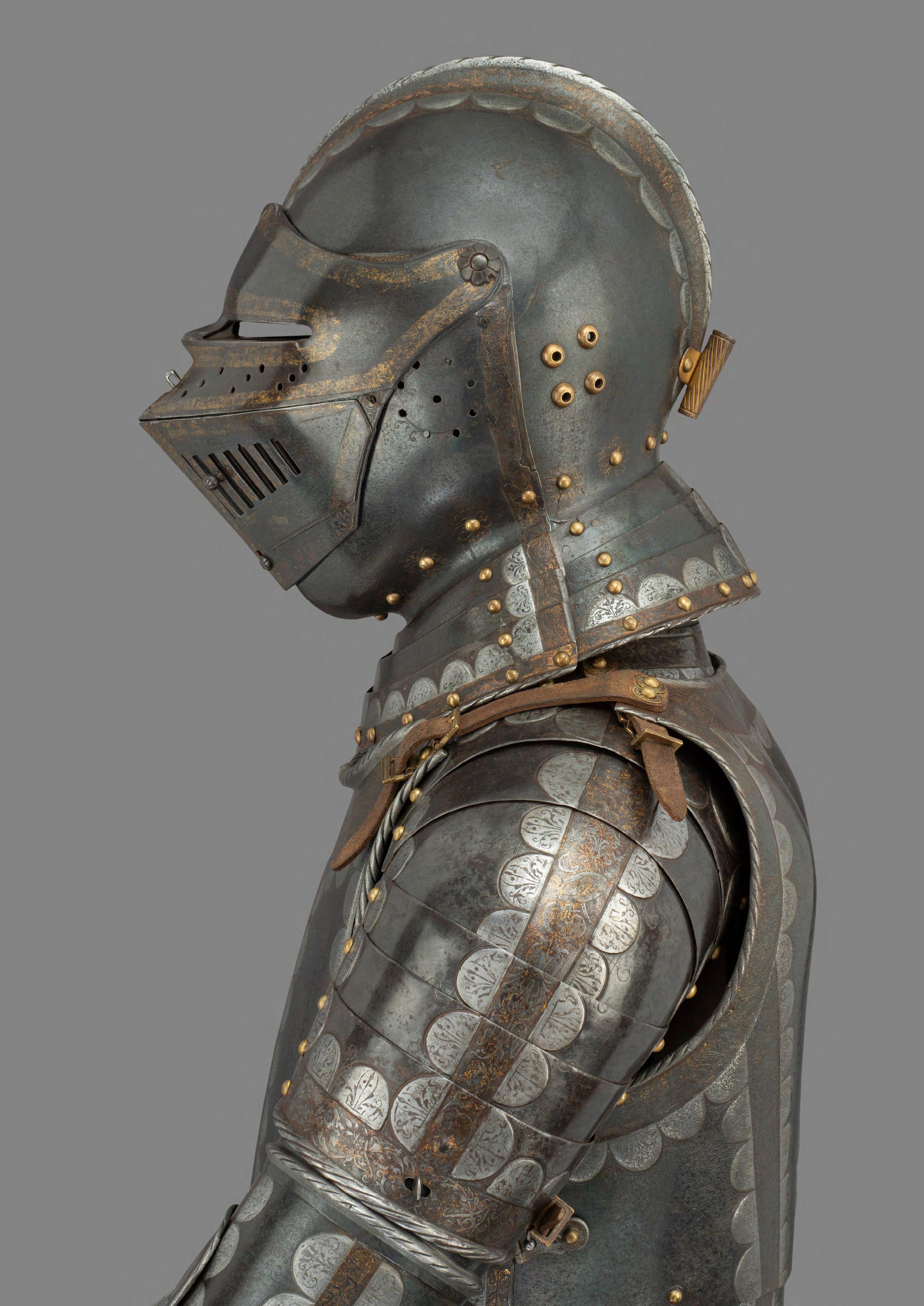
A Rare Breastplate for Foot or Light
Calvary Armour
c. 1550 – 60
Northern Italy, probably Brescia. Steel, copper alloy, gold
41.5 cm × 35 cm / 16.3 in × 13.7 in
PROVENANCE
Possibly included in the removal of arms and armour from the armoury of The Order of the Knights of St. John, Valetta, Malta, during either the French occupation of 1798-1800, or when under British governance within the first half of the 19 th century.
This breastplate was certainly made for wear by an officer of an elite body of troops, possibly those of The Order of the Knights of St. John, or alternatively the armed retinue of a high-ranking nobleman, or perhaps those forming a city guard.
The elegant elongated construction typifies the long-waisted form which was fashionable during the mid-16th century period of armour production in Milan, Brescia and Mantua. With the obvious exception of the gilded relief decoration, the outer surface is entirely blued, the finish now naturally lightly oxidised by age; it is not difficult, however, to picture the splendour of this armour within its period of use. Characteristic of the type, the construction comprises a main plate formed with a ridge running over the full height of the median and continuing over an over-lapping broad waist plate. The edges at the neck-opening and arm-gussets are finished with boldly cabled turns and the outward flange of the waist plate carries its original skirt of two lames.
Decorative embossed scrollwork sweeps downward in a symmetrical pattern from the upper corners to below the neck, and in the Italian style of the period this is balanced by its repetition over the waist plate.
The linear scrolls of the embossed ornament are conspicuous in their broad plain surfaces and bold graceful curves, in these respects the embossed work is comparable, for example, with the ornament embossed over the sides of an Italian burgonet skull of the same period, in the Stibbert Museum, Florence. The stylised fleur-de-lys motif incorporated in the embossed design is most likely the badge of a body of troops also (see Lionello Boccia, Il Museo Stibbert, Florence, 1975, cat. no. 64, fig. 65A).
Placed on the present breastplate as if suspended from the embossed scrolls is an heraldic Cross Moline, serving both to identify the allegiance of the wearer and to act as a Christian talisman. Similarly medieval in their origin were the crosses worn by the early Knights Templar and by the Knights Hospitaller, the latter properly titled ‘The Order of the Knights Hospitaller of St. John of Jerusalem’.

With its straight parallel-sided arms and small outwardly turned pairs of points, the Cross Moline is the design from which the better-known Maltese Cross developed and which was subsequently adopted as the badge of the Order of the Knights of St. John.
Within the immediate decades following their move to Malta in 1530, related tomb effigies, frescoes and portraiture of the period reveal that the Knights of St. John were initially identified by their medieval Cross in Ordinary rather than by the Maltese Cross, which only latterly became synonymous with this knightly order. This appears to have remained the case until circa 1550, beginning with the gradual introduction of the Moline type, but used in parallel with the Cross in Ordinary. It is only within the period 1570-1600 that the fully developed Maltese cross becomes frequently observed on the breastplates, red fabric tabards, shields and ceremonial cloaks of the knights.
Two late 16th century examples of munition breastplates bearing the Cross Moline (each considerably less elaborate than this present example), are preserved in the Royal Armouries Collections, Leeds (III.905, III.1327). A further two examples, of the same period, ascribed to possible Brescian origin and each embossed with a pendant Maltese Cross are in the Odescalchi Collection in the Museo Nazionale del Palazzo di Venezia, Rome (inv. 1105 and 1113).
Notable also in this discussion is a portrait in the Palace of Hampton Court, London, by Jacopo Robusti, called ‘Tinteretto’ (1518-94). The subject is a Knight of St. John; suspended from his neck is a Cross Moline, while the cross on his cloak is a Maltese Cross approaching its fully developed form.
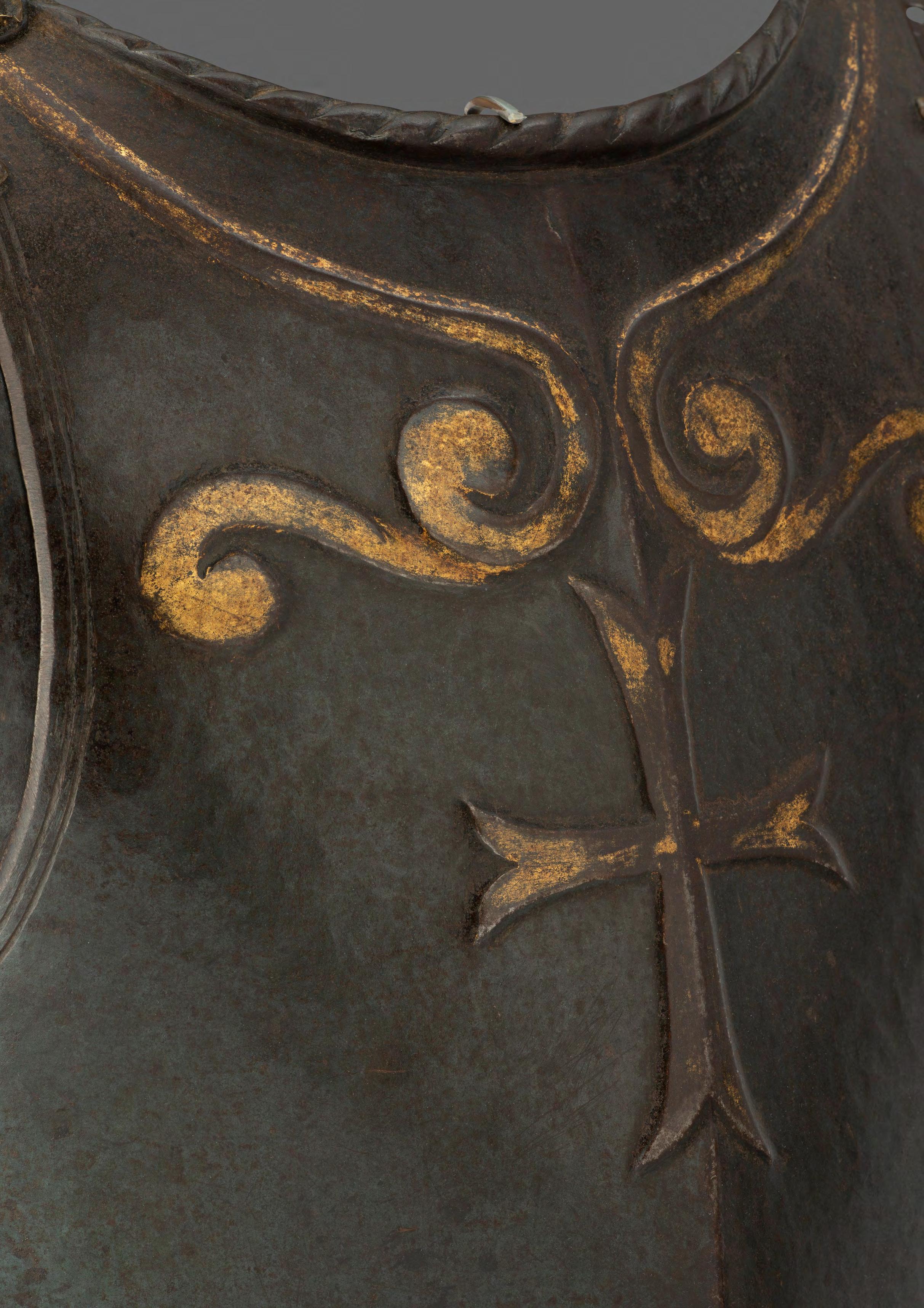
A Cavalry Half-Armour
c. 1560 – 70
Northern Italy, probably Brescia; North European lesser additions. Iron alloy (steel), copper alloy (brass), leather 171 cm × 76 cm × 35 cm / 67.3 in × 30 in × 13.7 in
This armour is a good representation of the type produced in the city of Brescia within the third quarter of the 16th century for the use of Italian heavy cavalry armed with lances. The close helmet in particular compares closely with the helmets of the two cavalry armours of this period among the hoard of Lombardic armour in the church of Santa Maria delle Grazie di Curtatone, now removed to the Francesco Gonzaga Museum, Mantua (cat. nos. B 12 and B 13).
The skulls of these generously proportioned helmets are further characterised by a highly pronounced but slender comb, rearward-swept over the crown. Characteristic also is the visor, formed with horizontal narrow sights with a narrow medial divide and extending centrally to form a pointed prow. The lower edge of the visor fits flush into the substantial upperbevor, aligning the sights exactly with its upper edge. The upper-bevor naturally forms the body of the prow and is invariably pierced with a single circular group of small circular breathing holes on the right side only, away from the point of an opponent’s lance.
The breastplate is again characteristic of cavalry armours produced in Brescia within the period. The V-shape became accentuated by 1570, as evidenced here. This style being referred to in English as ‘Peascod’; the elegance of the shape belies its important function, although its influence will be recognised in the extremes of male fashion portrayed in art over the remainder of the century.
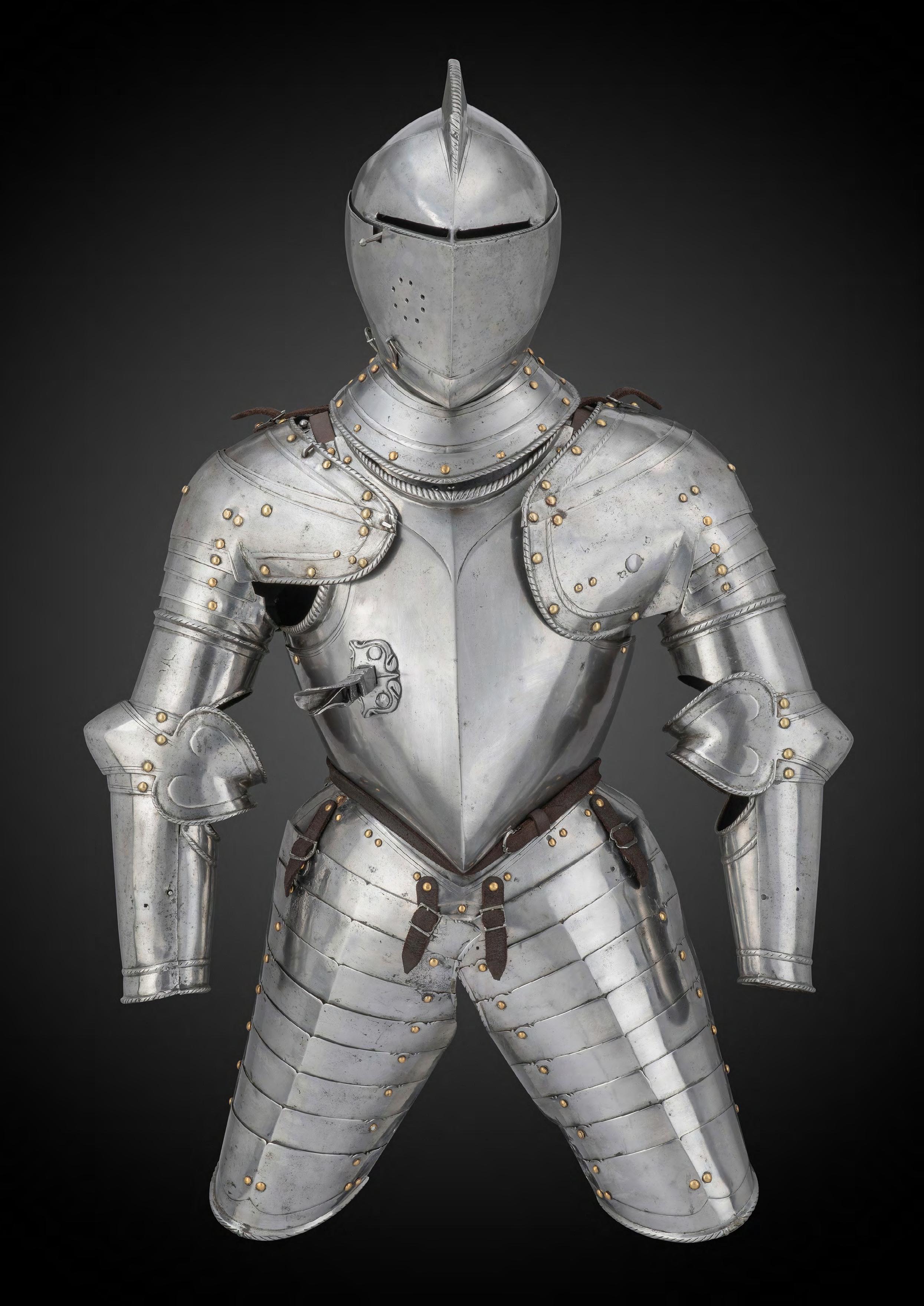
In terms of functionality, the shape was conceived in the defence of the wearer’s left torso, it being essential to prevent the catastrophic injury resulting from an opponent’s lance slipping into the wearer’s left armpit. The effective defence was to snap the opposing lance on impact, a possibility only if the lance impacted the breastplate at the exact angle of 90 degrees. To enable this, the rider had to lean forward at 30 degrees, in this way presenting a vertical surface to the offensive lance tip. The lower part of the breastplate had to be slanted forward, creating what we refer to as the ‘Peascod’ shape.
The shoulder defences (pauldrons) are correctly asymmetric, the configuration necessary to accommodate the lance when couched beneath the right shoulder. The larger plate of the opposing left pauldron provides evidence that this pair of pauldrons had likely seen service in the joust, it shows a plugged aperture originally intended for a bolt attaching a large reinforcing piece specifically for wear in the joust (buffa da torneo). This alternative sporting role for a field armour was typical among Italian heavy cavalry armours of this period.
A further notable feature within the arm defences is bifurcated design embossed on the bracelet couters (elbow defences), briefly a fashion in Brescian armour of the period.
A Suite of Magnificent Armour for Man and Horse,
Etched and Gilt in the Lombard Fashion
Late 16th Century
The Armour dating circa 1580-85 and possibly made for Don Carlos d’Aragona y Tagliavia, Duke of Terranova, Prince of Castelbeltrán, Count of Castelvetrano and Spanish Royal Governor of Milan (the helmet and cuisses both of a contemporary late 16 th century armour.)
The Horse Armour and the Shield dating circa 1560 from a garniture made for Emanuel Filibert, The Duke of Savoy.
PROVENANCE OF THE ARMOR:
The Rt. Hon. Lt. Col. Charles Seale Hayne, M.P. (d.1903), of Fuge House and Kingwear Castle, Devon. To F. Robert, Paris, 1904.
Acquired by William Waldorf Astor, later 1st Viscount Astor; thence by descent through the family.
Sold Sotheby’s London, The Hever Castle Collection, 5th May 1983, lot 54 (including associated elements now not present).
Northern Italy, Milanese workshops. Steel, gold, copper alloy, period textile forming the bridle, leather.
Height of the suite: 244 cm / 96 in Overall installation length of the suite (nose to tail): 272 cm / 107 in Maximum width of the suite (outside of stirrup to outside of stirrup): 107 cm / 42 in
PROVENANCE OF THE HORSE ARMOUR AND SHIELD:
By descent through the Ducal House of Savoy to the Royal Sardinia-Piedmont line.
These pieces of armour were dispersed, together with other constituent pieces, from the extensive garniture made for Duke Emanuel Filibert, the dispersal almost certainly occurring prior to 1840 and most likely prior to the establishment of the new royal armoury in Turin in 1837.
Acquired by Count Hector de Economos, Paris.
Included in the purchase of the Economos collection in its entirety by William Randolph Hearst, 1924.
William Randolph Hearst, as Anonymous sale, Galerie Fischer, Luzern, 29 November 1972, lot 71.
Acquired by a private collection, USA.
Anonymous sale, Christie’s, London, 12 December, 1997.

Almost certainly prior to this armour being acquired by William Astor, circa 1904/5, the cuisses and poleyns defending, respectively, the thighs and knees, were added. These are again contemporaneous with the arm defences and main body of the armour. These pieces have in common with the greater part a similar close-set arrangement of etched bands with black linear borders, but the contained ornament differs in being largely formed of vertical designs of welldrawn trophies-of-war.
The attribution to Don Carlos has only recently been determined by Italian scholarship, and we thank Mario Scalini for his work on this, through the interpretation of an etched palm branch and crown motif, a predominant feature recurring throughout the etched bands of ornament over the core elements of the armour. This palm motif has been identified as the impresa (personal emblem) of Don Carlos, which is carved in relief on the tomb of Don Carlos, in the church of San Domenico in Castelvetrano, Sicily.
Essential in the consideration of the provenance of this armour is that imprese were the informal emblems chosen by individual members of the Italianate nobility. Unlike a family coat-of-arms, they were not hereditary. In the case of Don Carlos, the palm is derived from the Tagliavia palm tree device found within his family arms, which had been quartered with those of Aragona in 1522 (upon the union by marriage with the niece of Frederico II, King of Sicily).
An additional motif recurring in conjunction with the palm on the armour discussed, appears to be a representation of the bulb-like Mandrake fruit. It has been suggested that this may have been included for its talismanic qualities.
The repeated incorporation of the Tagliavia impresa etched on the present armour is strikingly paralleled in one of the finest surviving armours made by Pompeo della Cesa. In a similar recurring manner to the armour of Don Carlos, this example carries both the motto and the ‘three rings’ impresa of the Borromeo family dispersed throughout the decorative scheme.
The helmet from the Borromeo armour is separately preserved in the Poldi Pezzoli museum, Milan, while the body of the armour is in the Stibbert Collection in Florence.
The armoured figure is superbly mounted for display, complemented by the shield and its matching elements of horse armour from an important etched garniture made, circa 1560, for Emanuel Filibert, Duke of Savoy, 1528-80.This situation came to an abrupt end, however, on 10th August in that year, with the decisive route of the French by Emanuel Filibert’s Habsburg army at the battle of San Quintino. Following both this defeat and yet further military failures the majority of French troops left Piedmont, to pursue another ill-fated campaign in the Hautede-France. Subsequently, a succession of French defeats in Piedmont, again at the hands of Emanuel Filibert, heralded the end of the twelve-year war with Habsburg Spain.
The consequential Peace of Cateau Cambrésis in 1559 saw not only the return to Savoy of almost all of its hereditary lands but it additionally gave Emanuel Filibert a bride, Margherita of Valois, sister of Henry II, King of France (together with substantial dowry). Anecdotally, the elaborate festivities that accompanied the marriage in July included a week of knightly tournaments, and it was while jousting on 30th June that Henry II was mortally wounded, dying within a few hours of the marriage.
With the restitution of Savoy completed under the terms of the marriage, Emanuel Filibert then handed the government of the Spanish Netherlands to a daughter of Charles V, to take up residence in Nice and commence the reconstruction of the Savoyard Duchy. In the course of his pursuit of the Swiss Savoyard lands a religious war now erupted in Piedmont, the complex political outcome of which was settled in 1561 by Emanuel Filibert’s skills as a statesman rather than as a soldier. He next gave his attention to agrarian reform in the duchy, together with the reconstruction of mining and commerce, to be followed by an extensive re-building and reorganisation of the Savoyard army and the birth of a naval force also.
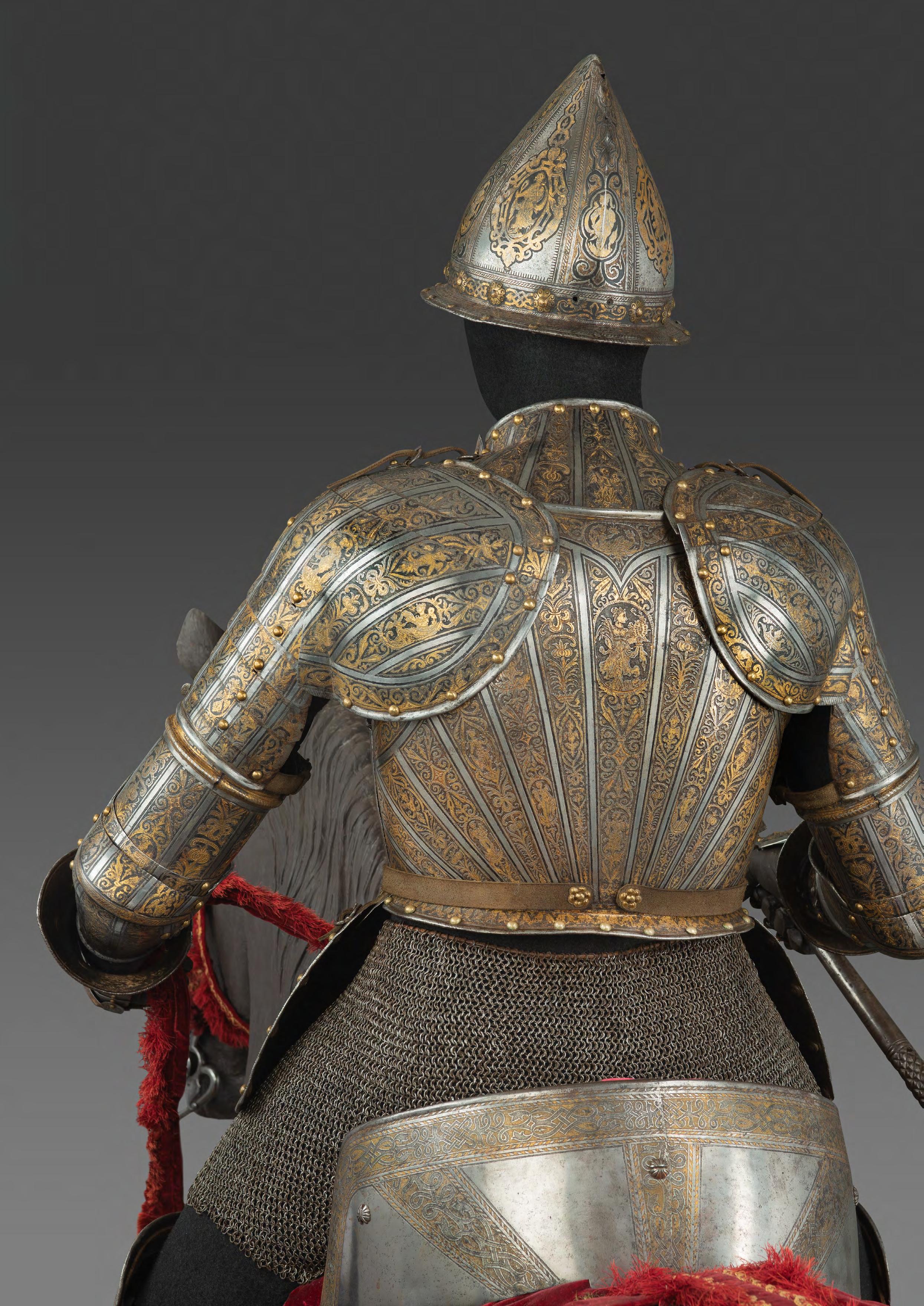
Thus re-equipped, the Savoyard Duchy under Emanuel Filibert became a new force in the alliance of the Holy Roman Empire, rendering valued onward assistance in the eternal fight against a Turkish conquest of the Mediterranean.
bronze equestrian statue
A
of Emanuel Filibert, Duke of Savoy, is in the Piazza San Carlo, Turin.
THE HORSE ARMOUR,
SHIELD and EMANUEL FILIBERT, THE DUKE OF SAVOY
In the context of the history of 16th century Northern Italy, Emanuel Filibert the duke was a singularly influential and pivotal figure. He provided both the blunt militaristic force and the diplomatic finesse necessary for the restitution of the Savoyard Duchy, the essential strategic buffer between longstanding French ambition and access to the Spanish Habsburg lands within the Italian peninsula. Through his prowess and courage as a general in the army of The Holy Roman Empire, but in particular for the wresting of his paternal duchy back from the invasive French, Emanuel Filibert became known in his lifetime as ‘Testa di Ferro’ (‘Iron Head’).
Armour belonging to this garniture is shown worn by Emanuel Filibert in a portrait of circa 1565, by Giacomo Vighi, called l’Argenta (d.1573), at the Galleria Sabauda, Turin. The majority of the surviving parts of this garniture remain in the Royal Armoury in Turin (inv. nos. B4- C86- C151- C227/228- E12), other pieces having been dispersed prior to 1840, in which year it is recorded that a helmet and a breastplate were in the possession, respectively, of the Conte S. Martino La Motta and the Marchese Claudio d’Aix. The latter, a distinguished general, was aide-de-camp to King Carlo Alberto of Sardinia and related to the first director of the newly established royal armoury, Vittorio Seyssel d’Aix. It is reasonable therefore to suggest that these two pieces were royal gifts. By extension, the present shield and horse armour from this garniture may have been dispersed from the royal collection under similar circumstances.
The present elements of horse armour from the historic garniture comprise a half-shaffron complete with its poll-plate, and the original leather-covered saddle-tree mounted with four plates over the bow and its rear cantle defended by a pair of large plates. The original matching circular shield from the garniture provides a complementary bridge with the armoured figure.
These pieces are preserved in superb condition throughout, with little evidence of wear. The matching etched and gilt pattern is clearly identical to the etched and gilt armour detailed in Emanuel Filibert’s portrait. The etched pattern takes the form of a series of broad bands both radiating across and bordering the bright steel surfaces. The bands are filled with a repeating design of partly-foliated interlaced strapwork, alternating with quadruple loops at intervals, and all on a gilt ground within subsidiary herringbone border ornament.
The shaffron extends down to the upper part of the muzzle, with flanged cut-outs for the eyes, separate riveted ear-guards, tubular brass plume-holder, and bolt for fitting an escutcheon. The poll-plate moves on a hinge at the apex.
The original saddle leather is authentically dressed in rich textile, after the fashion of the period. Its applied plates are retained by screws with prominent rosettelike heads. Both the saddle and the shaffron are painted with the inventory number ‘16’ on the inside.
The shield is of slightly concave form on its inner side, the outer face fitted with an iron acanthus calyx. It retains its original brown velvet lining edged in decorated braid, and additionally its original leather braces, which are partly velvet-covered.
To this historic ensemble are added a pair of late 16th century stirrups damascened with fine gold ornament in the North Italian taste, together with a pair of rowel-spurs also dating from the 16th century and similarly damascened in gold.
Elements of a contemporary equestrian garniture (including a half-shaffron, armoured saddle and shield) are etched in an almost identical pattern to the corresponding pieces under discussion; made for capitano Valerio Corvino Zacchei of Spoleto, this smaller garniture remains in the Royal Armoury, Turin (nos. B7- E38- F23).
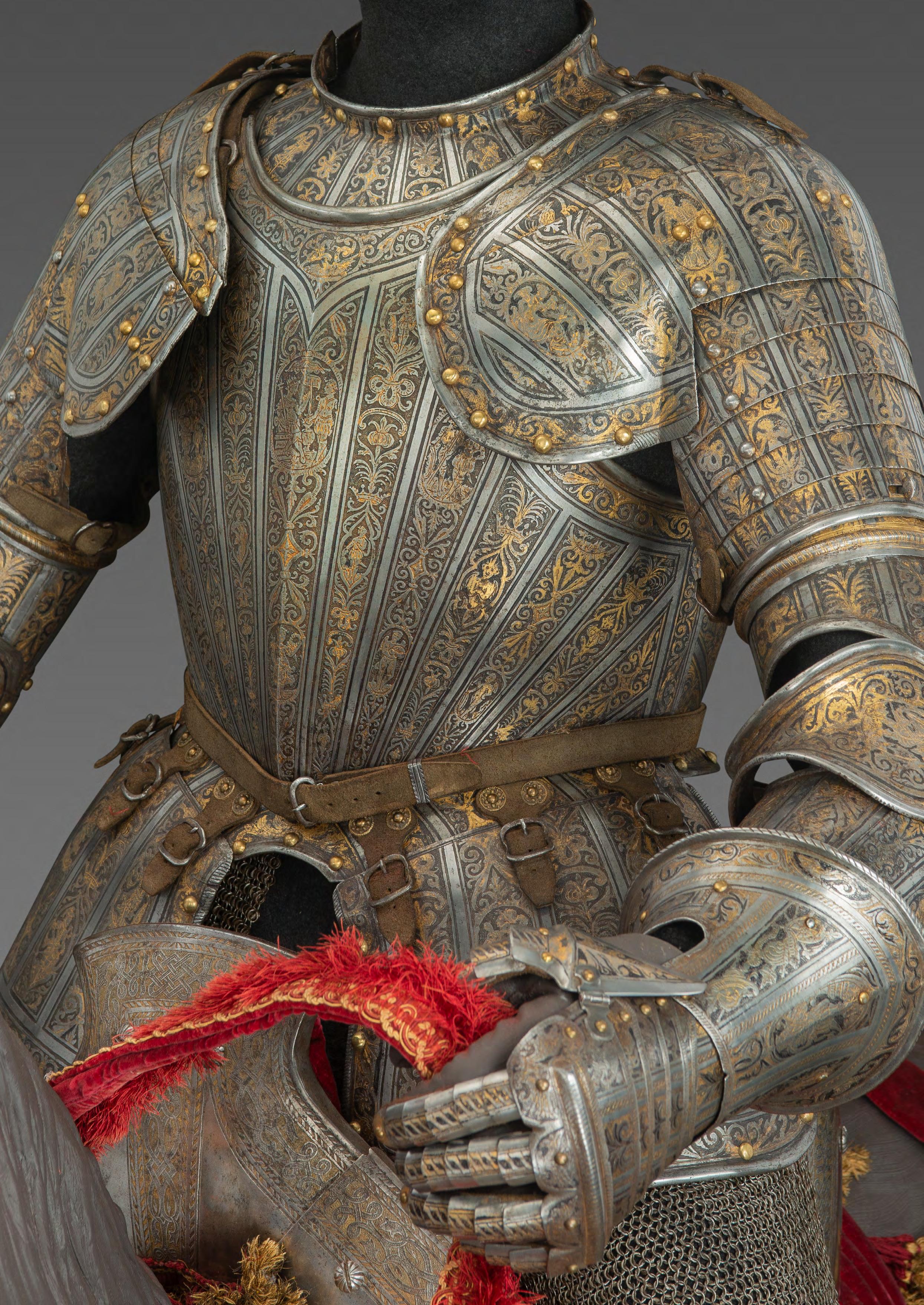

As Prince of Piedmont, Emanuel Filibert acceded to the title Duke of Savoy upon the death of his father, Duke Carlo III, in 1553. Under the weak tenure of Carlo III, Turin and the majority of the Savoyard lands in Piedmont had since 1536 been annexed by France. Thus, with no option other than the church, in 1545 at the age of seventeen Emanuel Filibert had embarked on a military career, in the service of his great-uncle, the Emperor Charles V. From this beginning he would rise quickly to become both a highly accomplished field commander and statesman, and ultimately the much-acclaimed redeemer of the Savoyard lands from French occupation.
As a soldier Emanuel Filibert engaged with distinction first in the Schmalkaldic War of 1546-7, thereafter continuing in the service of Charles V in support of his son, the Habsburg Infante Filippo (later Philip II of Spain), fighting the French in the Habsburg-Valois (or Italian) War which had erupted in 1551. In 1553 Emanuel Filibert was appointed lieutenant-general and Governor of Flanders, in supreme command of the imperial army there. In Savoy meanwhile, France further extended its territorial grasp over the succeeding two years, and subsequent efforts by the new Spanish Governor of Lombardy to reverse the position achieved little.
A brief truce was followed by the re-commencement of the ever-worsening attrition in Piedmont in 1557. This situation came to an abrupt end, however, on 10th August in that year, with the decisive route of the French by Emanuel Filibert’s Habsburg army at the battle of San Quintino. Following both this defeat and yet further military failures the majority of French troops left Piedmont, to pursue another ill-fated campaign in the Haute-de-France. Subsequently, a succession of French defeats in Piedmont, again at the hands of Emanuel Filibert, heralded the end of the twelve-year war with Habsburg Spain.
The consequential Peace of Cateau Cambrésis in 1559 saw not only the return to Savoy of almost all of its hereditary lands but it additionally gave Emanuel Filibert a bride, Margherita of Valois, sister of Henry II, King of France (together with substantial dowry).
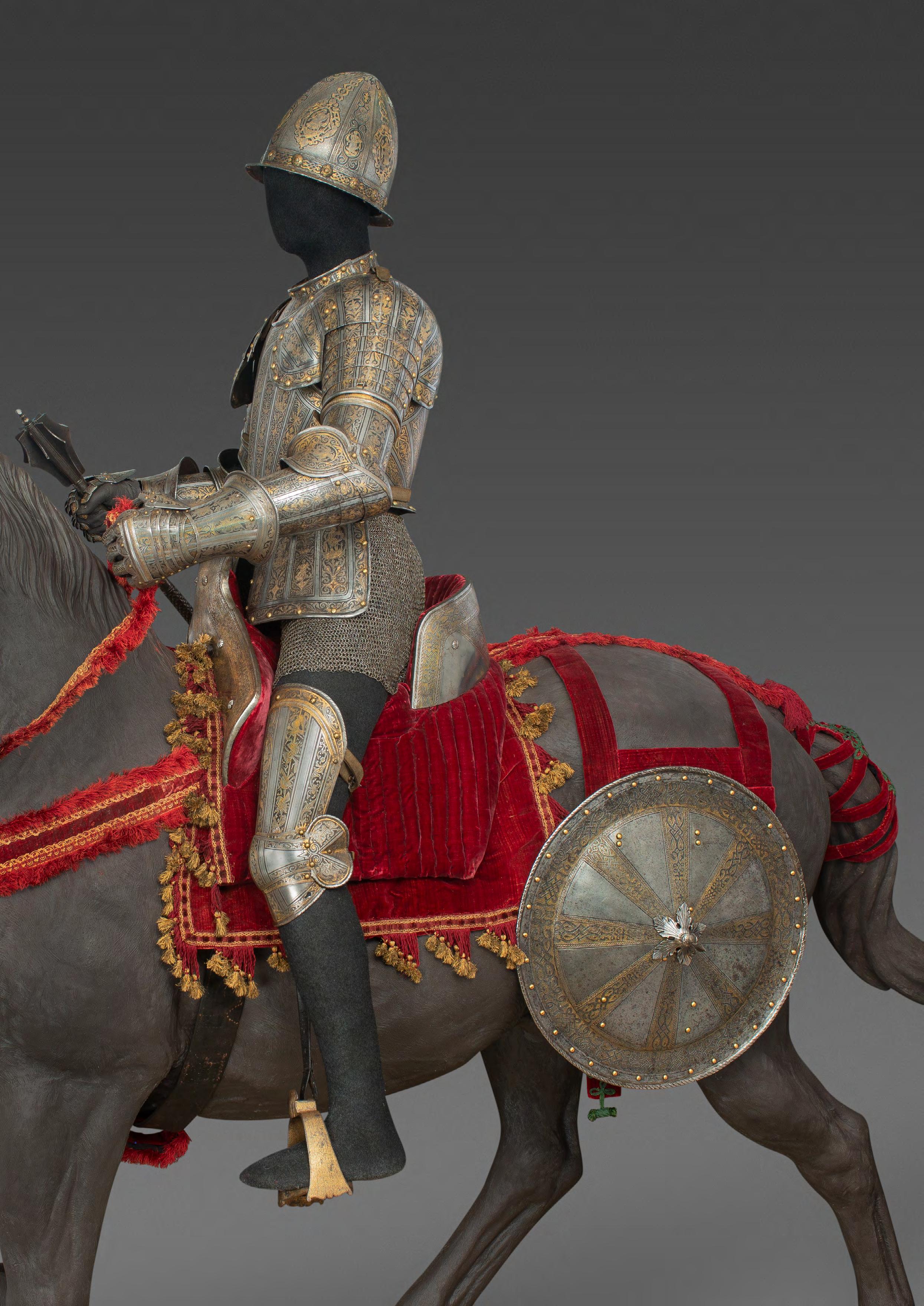
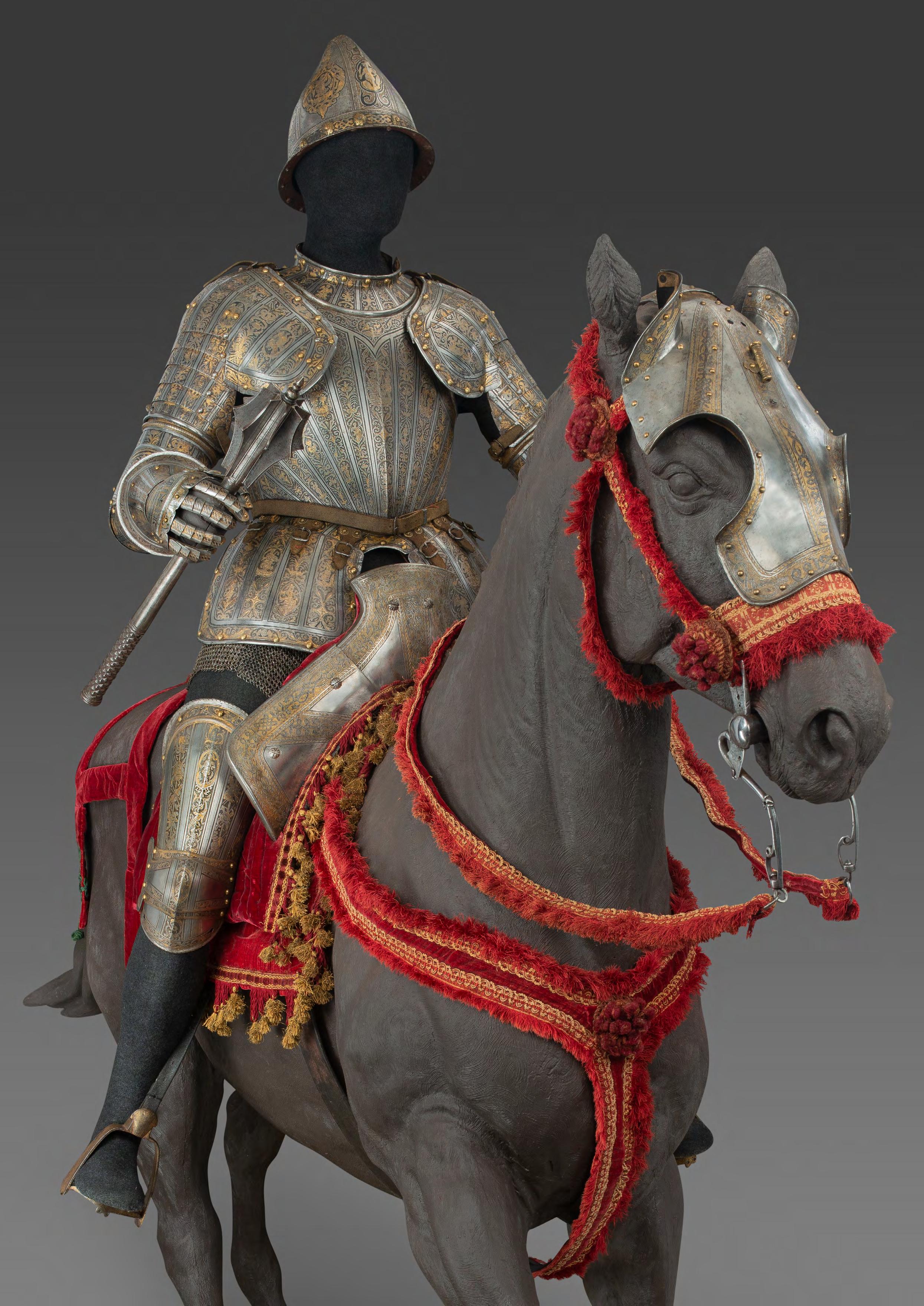

Anecdotally, the elaborate festivities that accompanied the marriage in July included a week of knightly tournaments, and it was while jousting on 30 th June that Henry II was mortally wounded, dying within a few hours of the marriage.
With the restitution of Savoy completed under the terms of the marriage, Emanuel Filibert then handed the government of the Spanish Netherlands to a daughter of Charles V, to take up residence in Nice and commence the reconstruction of the Savoyard Duchy. In the course of his pursuit of the Swiss Savoyard lands a religious war now erupted in Piedmont, the complex political outcome of which was settled in 1561 by Emanuel Filibert’s skills as a statesman rather than as a soldier. He next gave his attention to agrarian reform in the duchy, together with the reconstruction of mining and commerce, to be followed by an extensive re-building and reorganisation of the Savoyard army and the birth of a naval force also. Thus re-equipped, the Savoyard Duchy under Emanuel Filibert became a new force in the alliance of the Holy Roman Empire, rendering valued onward assistance in the eternal fight against a Turkish conquest of the Mediterranean.
A bronze equestrian statue in the Piazza San Carlo, Turin, commemorates the life of Emanuel Filibert, Duke of Savoy.
A Very Rare Milanese Etched Breastplate charged with an Armorial Cross, for a Light Cavalry or Foot Service Armour, Inspired by the Etched Motifs of Pompeo della Cesa c. 1580-1600
Italy, Milan. Steel, gold, copper alloy, leather
46 cm × 35 cm / 18 in × 13.7 in
PROVENANCE
Private collection, France
The large cross dominating the face of this breastplate is almost certainly a badge of senior authority associated with a specific body of troops, most likely within the north Italian orbit of power and probably an emblem of the Duchy of Savoy.
The prominence of the cross naturally indicates the level of its significance to the nobleman for whom the armour was made. As such, the cross is an original element of the etcher’s plan, rather than a subsequent addition. The cross is purposefully off-set from centre in order to retain the aesthetic qualities of the etched banded design, a theme conventional to the foremost armourers of Milan, circa 1565-1600. In addition, the arms of the cross are of slightly unequal lengths in order to maintain perspective over the curvature of the plate.
The large scale of this cross (typologically referred to as Greek) differentiates it from the family coats-ofarms and personal devices (imprese) which, on a far smaller scale, are seated generally more discretely within the etched ornament on the finest Milanese armour.
In the absence of a full representation of the tinctures or colours which are fundamental to specific identification in heraldry, it is only possible in the present instance to make informed suppositions in this respect.
Fortunately, the etcher has finished the cross in the white (rather than reproducing any of the patterns used to denote other heraldic colours or materials), the intended representation undoubtedly being a white cross (argent).
While a firm attribution cannot be ascribed, it is most likely that this breastplate belonged to an armour made for a senior commander in the standing army established by Duke Emanuele Filiberto of Savoy (r. 1553-80), famed for his successful armed retrieval of the Savoyard Principality of Piedmont (Piemonte) from the French. The Savoyard army was maintained under his successor, the militaristic Duke Carlo Emanuele di Savoia (r. 1580-1630), repelling in 1589 an offensive by Geneva and other Swiss cantons as members of a French coalition. In the following year Carlo Emanuele sent an army to Provenace in the interests of the Catholic League, the French conflict being temporarily settled by the peace of 1593.
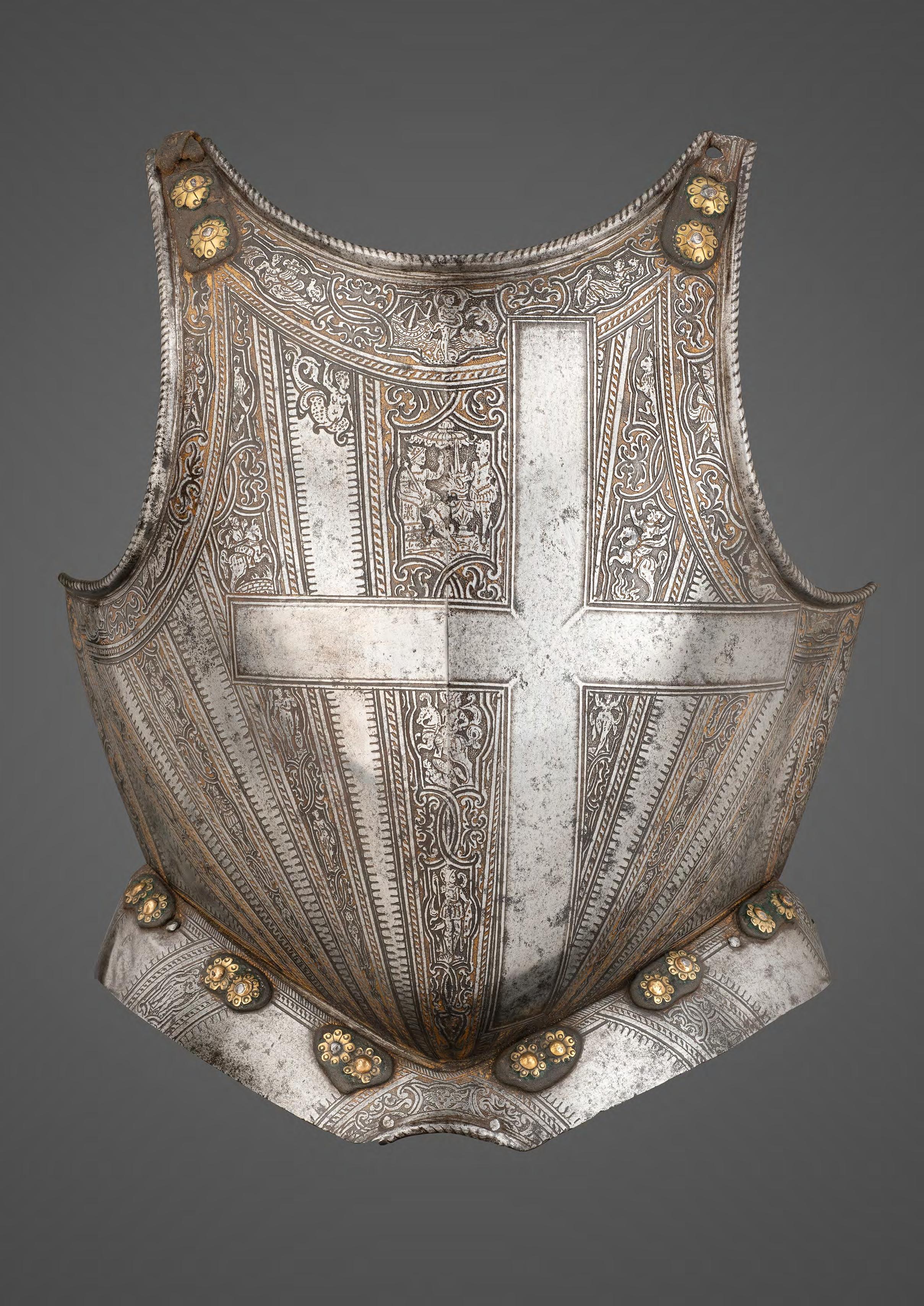
The sole viable alternative attribution for the present breastplate is that it may have been made for a senior officer of the Knights of the Order of St. John, perhaps the commander of an Italian Priory of the Order.
Parallel to the use of the better-known eight-pointed or Maltese cross, which is found on a relatively numerous series of munition breastplates of circa 1560-1600, both the Standard and the Coat-of-arms of the Sovereign Military Hospitaller Order of St. John take the form of a white Greek cross; in common with the white cross of Piedmont-Savoy, this is set against a red ( gules) ground.
Within this period, however, the use of a Greek cross on surviving armour associated with the Knights of St. John appears to be unknown; exceptions to this are limited to art of the period, showing the Greek cross emblazoning the painted shields and tabards of men-at-arms during the era of the Great Siege of 1565. Notable works exemplifying the period use of the Greek cross include the carved tabard on the important tomb effigy of the then Grand Master of the Order, Jean Parisot de Valette (d. 1568), in St. John’s Co-Cathedral, Valletta; this is repeated in d’Aleccio’s fresco battle-scene, in the cathedral also, therein worn by Jean Parisot de Valette and the troops of the Order alike.
Returning to the breastplate under discussion, the etched decoration draws on the conventions and motifs established by the leading armourers active in Milan within the final quarter of the 16th century. This includes the technique of ‘raised etching’, in which the ground alone is etched with acid around the drawn pattern, rather than the standard reverse process in which a pattern is created by the direct application of acid.
The result is the visual strengthening of the pattern, which by this means is projected in low relief. As with much fine Milanese armour of the period, this particular process is well-used in the present instance, giving emphasised structure to the ribbandlike scrolls and cartouches within the banded pattern. These features are made the more striking by being picked-out in black and set against a stippled gilt ground (the present example retains some of this original gilding, the balance now white).
Foremost among the surviving elements of magnificent etched and gilt Milanese armour are those made for the ruling Ducal House of Savoy, and for the nobles of its court and armies. These historic examples are for the greater part preserved in the Royal Armoury, Turin, with other dispersed pieces from these garnitures now mostly in museums across Europe, Britain and the United States. Further important examples are represented in the historic collections of the Royal Armoury, Madrid and in the former Imperial Armouries in Vienna.
The present breastplate is of the form fashionable in the latter decades of the century, drawn-down to an elegant V-shaped point, with turned cabled edges, a single waist lame, and pairs of rivets on brass rosette washers for the shoulder-straps and tasset leathers (expertly replaced).
The absence of a lance-rest is indicative of this breastplate belonging to an armour intended either for light cavalry use, or for foot service in the field or even perhaps the tourney fought at the barrier.
The basis of the fine etched decoration is a characteristic arrangement of bands radiating from the base, with secondary bands across the neck, bordering the sides and continuing over the skirt lame.

The bands are in turn framed throughout by guilloche strips edged by a vacant strip inside and out, and with a blackened single outside line fringed by a spikey neo-dentil pattern. This distinctive border in fact originates in the earlier etching (probably by Ambrosius Gemlich) of armour made for the Habsburg courts in Madrid and Vienna, by Wolfgang Großschedel of Landshut, seen for example in an armet and matching gauntlets of circa 1535-40 (see The Wallace Collection, London, A 164, A 264-5).
In its subsequent Milanese incarnation this border is further developed and found on a number of armours attributed to the workshops of the celebrated armourer Pompeo della Cesa (recorded 1572-93), together with armours ascribed to others of his circle, including the ‘Master of the Castle’, the ‘Master IFP’ and the ‘Master LB of the Globe’.
In the present instance, the ornament within the etched bands comprises a series of cartouches separated by conjoined pairs of opposing C-scrolls, and enhanced by adjacent matching scrollwork flourishes. Typically, the cartouches contain a series of figural vignettes from classical Roman mythology and history. At the centre below the neck, the Goddess Fortuna occupies a cartouche together with a ship and marine monsters, a symbol of her
acts of guidance. At the top of the medial band, the hero Gaius Mucius Scaevola holds his hand into the fire before the Clusium King Lars Porsenna, with a warrior beneath, possibly Mars the God of War. Uppermost within the respective flanking bands are the figures of Marcus Curtius riding into the fiery chasm and Horatius at the bridge. Further male and female classical figures are dispersed among lesser cartouches throughout the design, together with other grotesque emblems of the period.
From the quality of the etched decoration and the likely high status of the man for whom the breastplate was made, it would be reasonable to suggest that this breastplate was possibly the product of one of these workshops referred to above.
Pompeo della Cesa, for example, would have led a large workforce and employed a number of etchers, evidently working in parallel on the many elements of a single garniture of armour. He is also known to have held contracts in cooperation with other Milanese workshops, in order to fulfil large commissions. By these means etched motifs and characteristics favoured by his workshop would be disseminated among the wider Milanese school of decorated armour production.
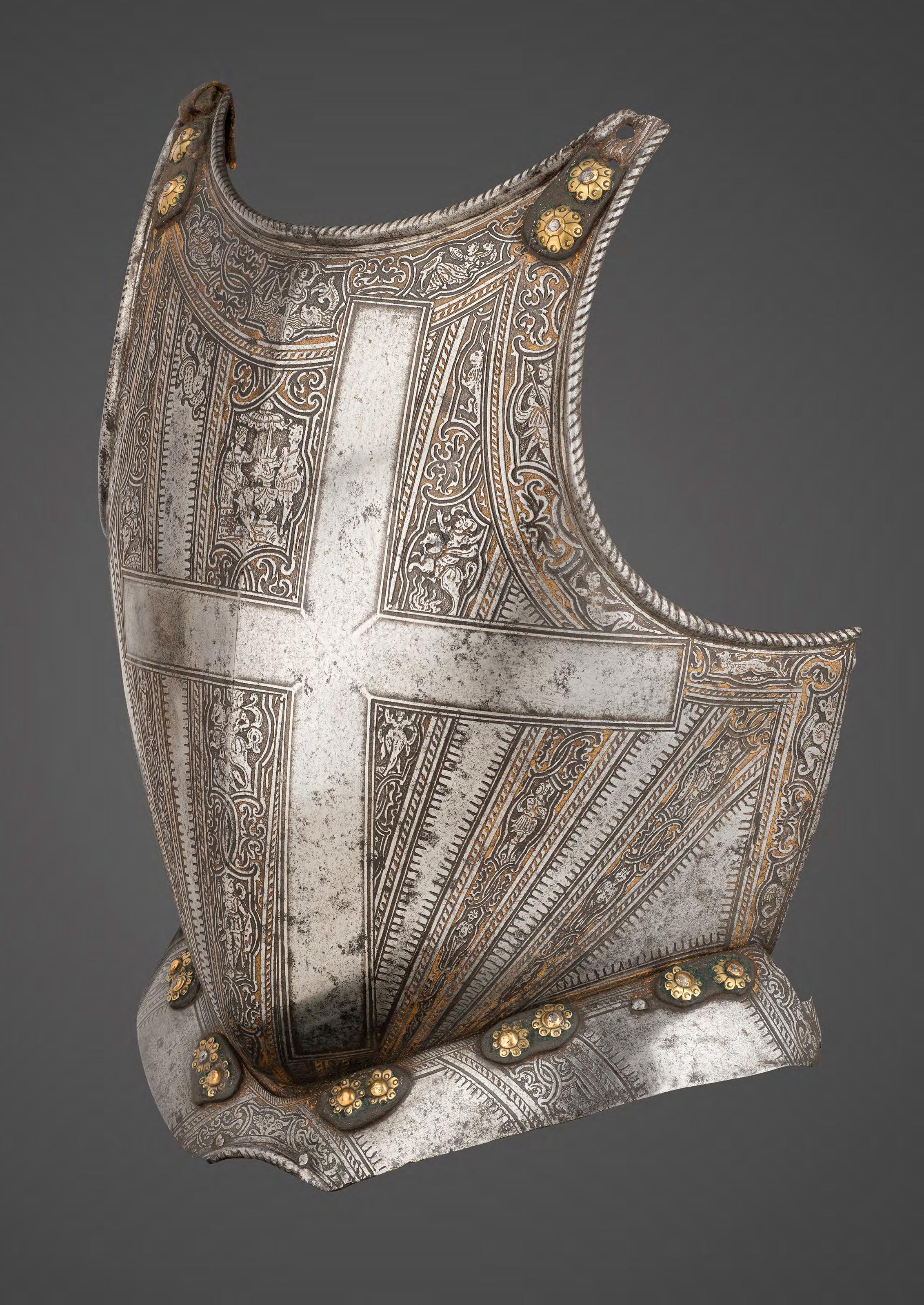
A Half-Armour of Blued Steel
c. 1580 – 1600
8 Northern Italy, Brescia or Milan. Steel, gold, leather, textile Restoration to the blueing. The leathers and piccadills are modern.
87.5 cm × 72 cm × 39 cm / 34.3 in × 28.3 in × 15.3 in (on mount)
PROVENANCE
Private collection, USA
The half-length configuration of this armour was best suited to foot combat in late 16th century warfare. The new widespread use of military firearms now made agility in the field a defensive requirement, rendering cumbersome leg defences redundant. Italian decorated armours such as this one are frequently identified with the elite small bodies of troops which formed the bodyguard of politically significant noblemen and senior clergy.
The open-faced helmet, properly described in this instance a ‘morione aguzzo’ or pointed morion, was the preferred head defence for field combat by the close of the 16th century. The present example is notably elegant, and richly ornamented with etched and gilt linear bands of warrior figures and trophiesof-war against a ground of scrollwork and mythical grotesques.

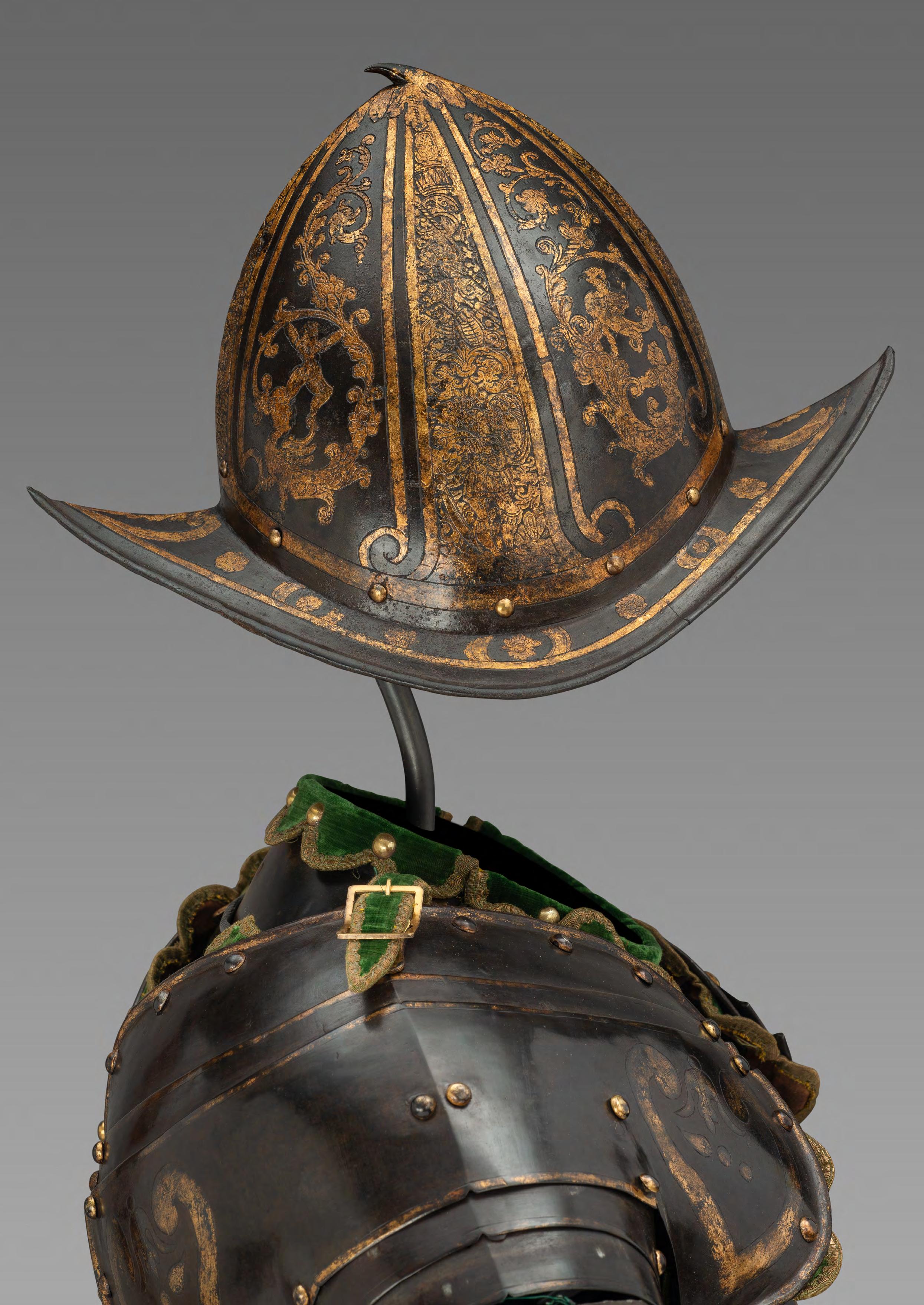
The body of the armour is decorated in the more open incised designs which emerged in north Italian armour after about 1560, in parallel with armour decorated with the more often observed bands of etching. Armour decorated with incised flowing symmetrical patterns of foliage and plain broad gilt bands, such as we see here, was also the style worn by the Vatican Papal Guard in the latter decades of the 16th century.
A particularly distinctive feature of the present armour is the Christian iconography incised and gilt over each of the lower-cannons of the arm defences. This would suggest probable wear by a member of a guard, or armed retainer, in the service of a monastic or otherwise religious body.
The design is contained by a gilt framework and centres on a medieval Christian Tau cross (so called because of its resemblance to the Greek letter tau). About the cross are the celestial motifs sometimes present in the renaissance iconography of the Crucifixion. The letters ‘I O H’ are incised above, which may be interpreted as the abbreviated Latin name ‘JOHANNES’ (John), very likely a reference to St. John The Evangelist. A plumed helmet is placed over the top, in the manner of a crest.
A North Italian Etched Circular Shield for Foot Service in the Manner of Pompeo della Cesa
c. 1580 – 90
Italy, Milan
Steel, gold, copper alloy, textile, gilt brocade, leather 58 cm / 22.8 in (diameter)
PROVENANCE
Private collection, United States
The etched decoration on this shield draws compelling parallels among a range of examples of decorated armour attributed to the much-celebrated Milanese armourer Pompeo della Cesa (Chiesa). He was the last of the great Italian armourers to sign with his name the central pieces of his work.
One prominent parallel example is a shield of identical type, attributed to della Cesa circa 158090, preserved in the Museo Poldi Pezzoli, Milan (inv. 1740). The most striking similarity between their respective etched patterns is found in the shared radial arrangements of oval figural cartouches, pendant from ribbon-like decorative knotwork, and which develop to form partly foliated scrollwork at either end. The whole design is highlighted in black against a stippled gilt ground and set within guilloche and blackened linear borders. The Poldi Pezzoli shield differs primarily only with the alternative placing of the Virtues in cartouches within the otherwise vacant spaces between the bands, and by the substitution of warrior figures within the radial pattern.
This scroll-ended knotwork (in the later years of della Cesa’s repertoire to also involve addorsed C-scrolls) is a frequently recurring and conspicuous element of his work. Foremost among della Cesa’s armours to include this etched pattern are the magnificent large garnitures which he made for the Dukes of the Royal House of Savoy and other closely related armours for the nobility in their service, much of which are preserved in the Royal Armoury, Turin. A garniture etched in this fashion and made by della Cesa in about 1560-65 for the Duke Emanuele Filiberto (d. 1580) was in part included in a private collection sold in London in 1997; the majority of that garniture remains in Turin (Nos. B4 etc.).
Other than the overall close similarity in the decoration of the two shields discussed here, the detail of their shared examples of scroll- and knotwork possess, in particular, a sufficiently strong resemblance as to suggest a workshop in common. The museum catalogue entry gives further comparative reference to a number of della Cesa’s works of salient significance, including those in the Royal Armoury in Turin and the Royal Armoury in Madrid, all of which have this style of etched design as a common thread (see Lionello G. Boccia and José A. Godoy, Museo Poldi Pezzoli, Armeria. I, Milan 1985, cat. no. 341, pl. 370).
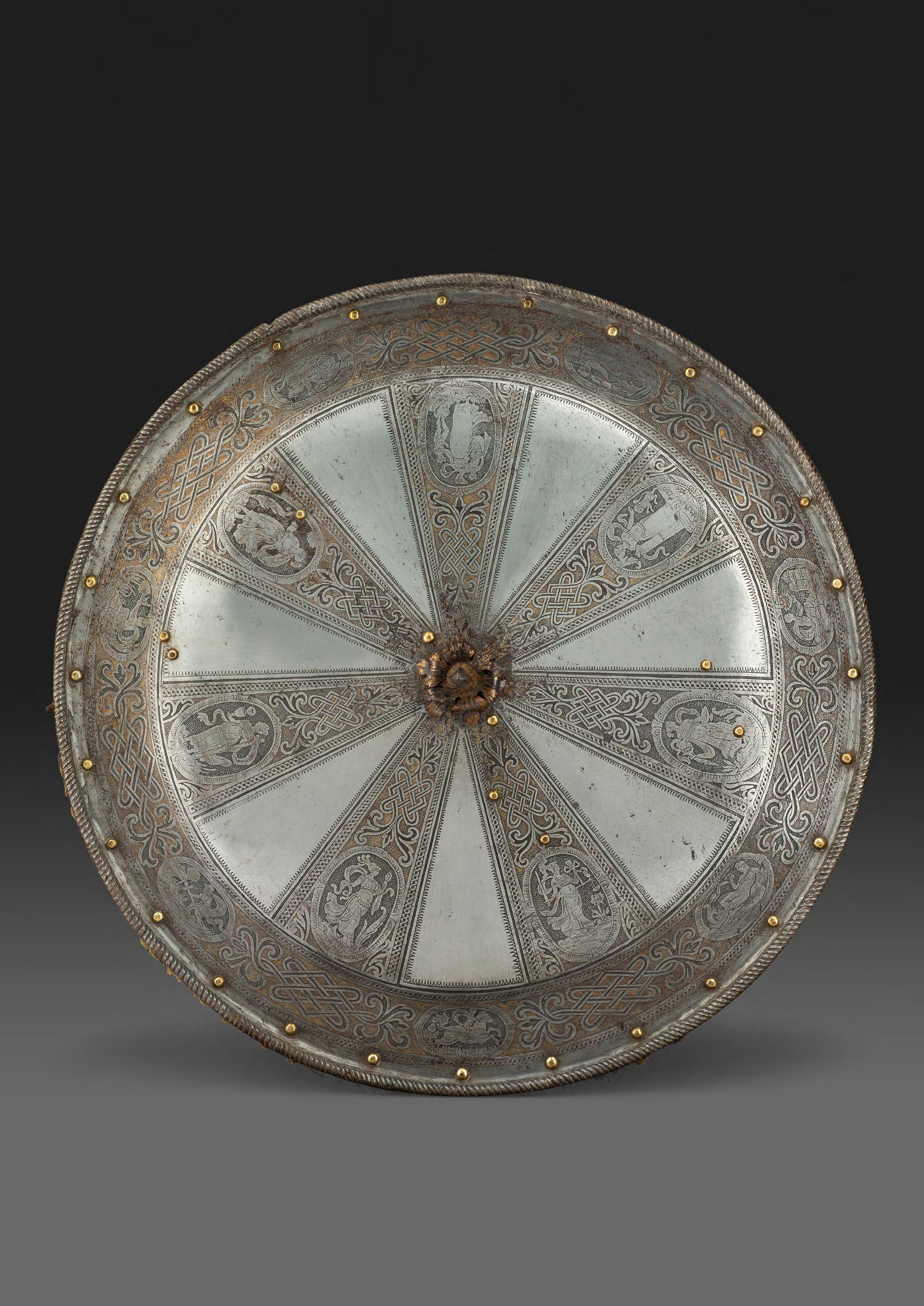
Returning to the present shield, the guilloche and linear ornament which borders the radial bands and the band encircling the rim is another distinctive feature of armour attributed to della Cesa and his Milanese followers. One such example, which also includes the ‘toothed’ or dentil pattern of the present shield, exists on the surviving parts of a garniture in the Royal Armoury, Turin (C 14- C73), etched in the manner of Pompeo della Cesa, by the Master L B and an Orb (or Globe), circa 1580-90.
Another very closely comparable example of this type of border pattern is seen on a Milanese morion in the Wallace Collection, London (A 146).
In consideration of the etched oval cartouches on the present shield and of the figures within them, a very close comparison exists in the corresponding features on a part-armour in The Metropolitan Museum of Art, New York (acc. 2001.72a-d). Signed by Pompeo della Cesa, this armour, for either light cavalry or foot service, was made for Vincenzo Luigi di Capua, Prince of Riccia and Count of Altavilla, circa 1595.
In the instances of both the shield and this armour, the oval cartouches and the figures have a naïve character very likely inspired by the same set of pattern engravings. Again, in each example particular note is drawn to the relatively cursory treatment of some of the subject faces, giving an unfinished appearance. The natural conclusion would be that both examples were etched in della Cesa’s workshop, although apparently not by the same hand.
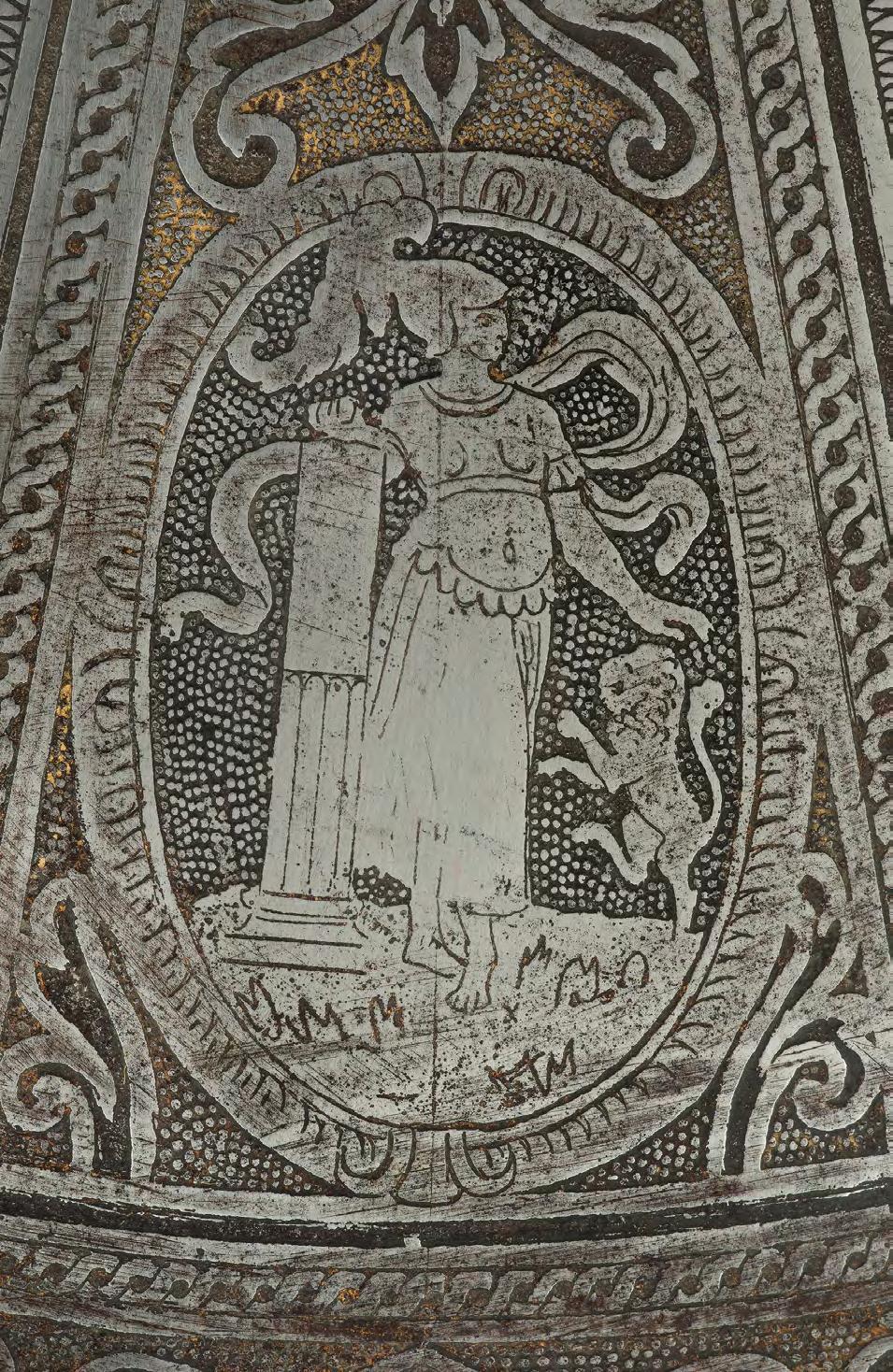
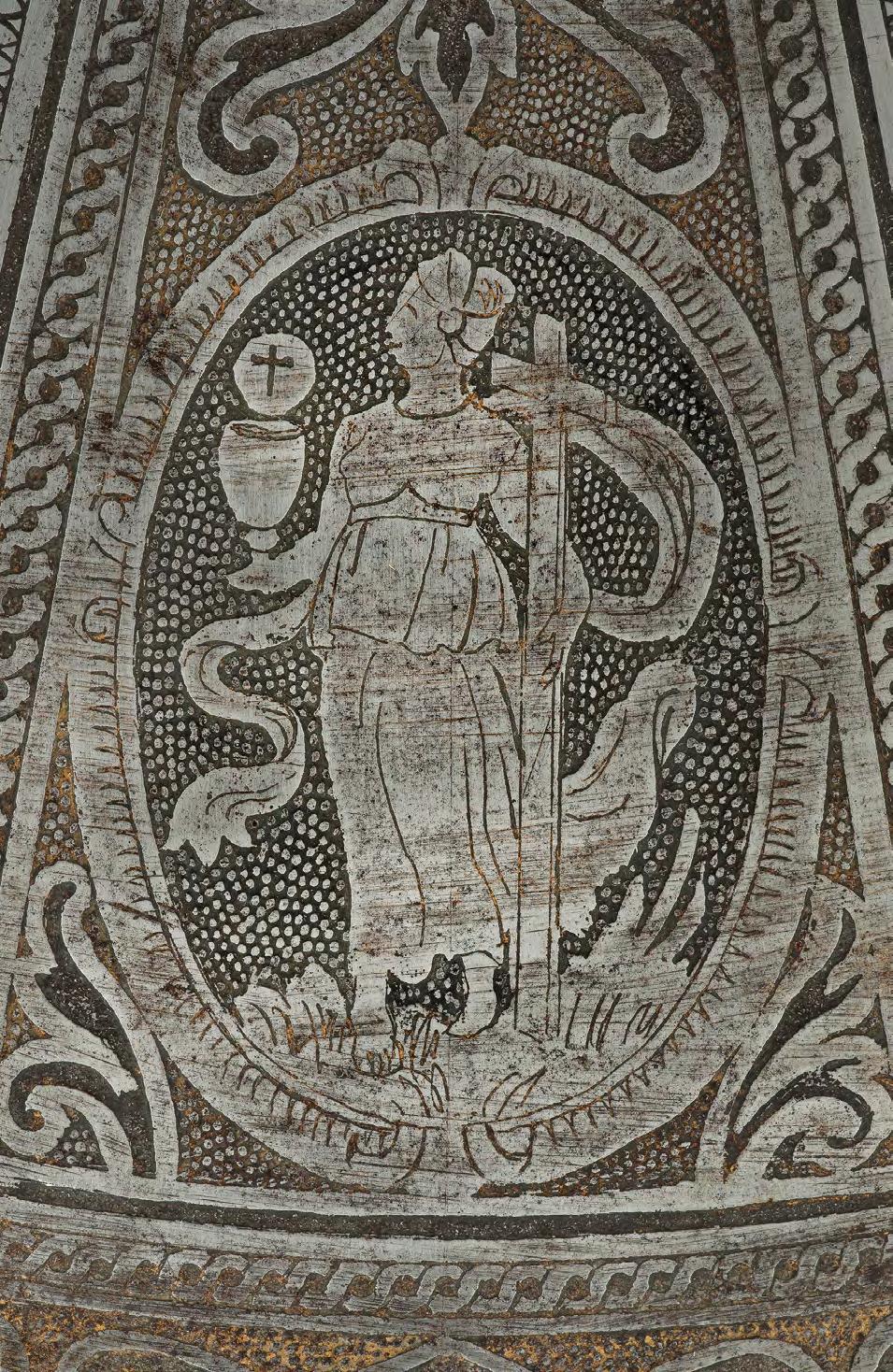
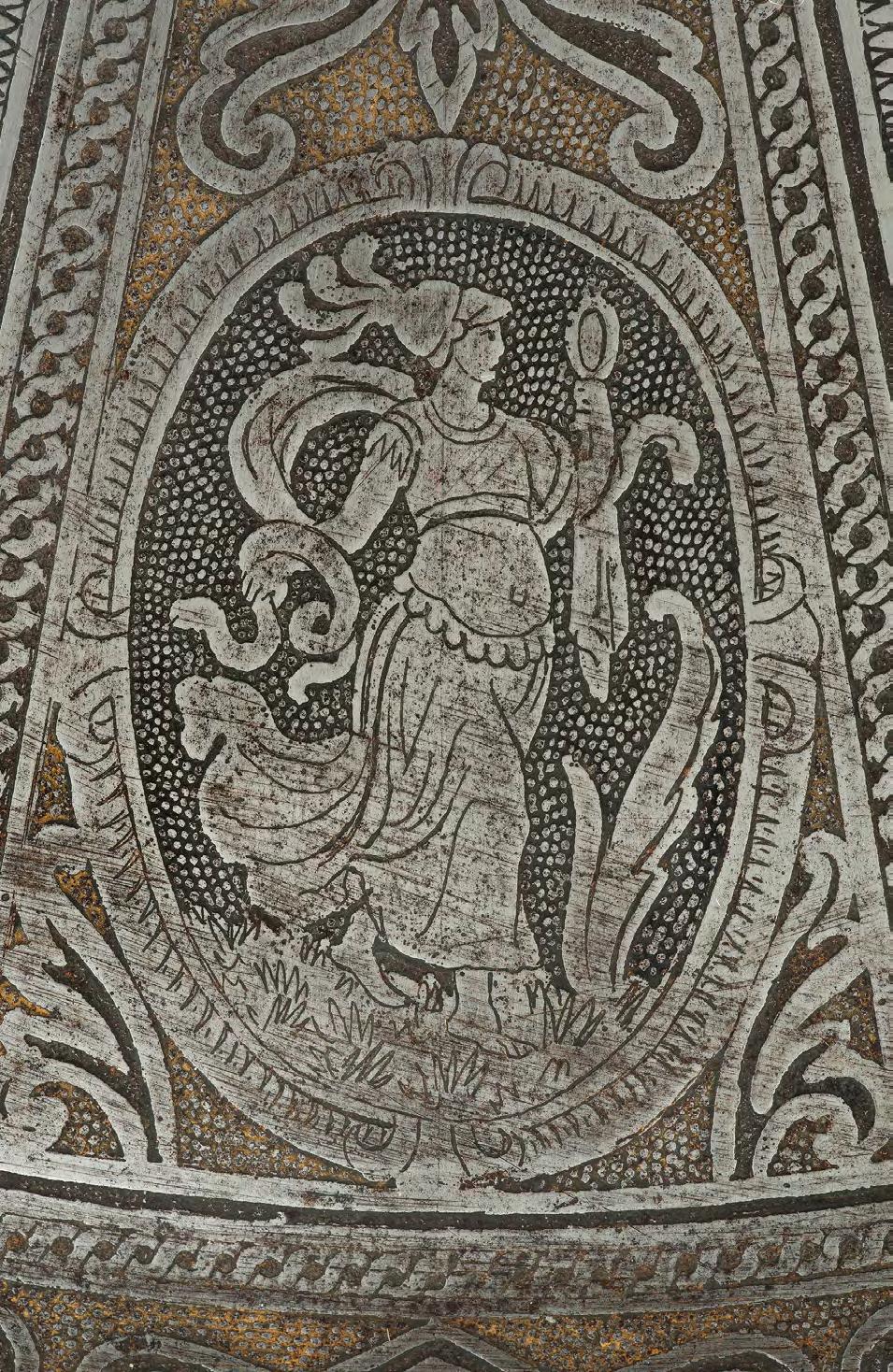
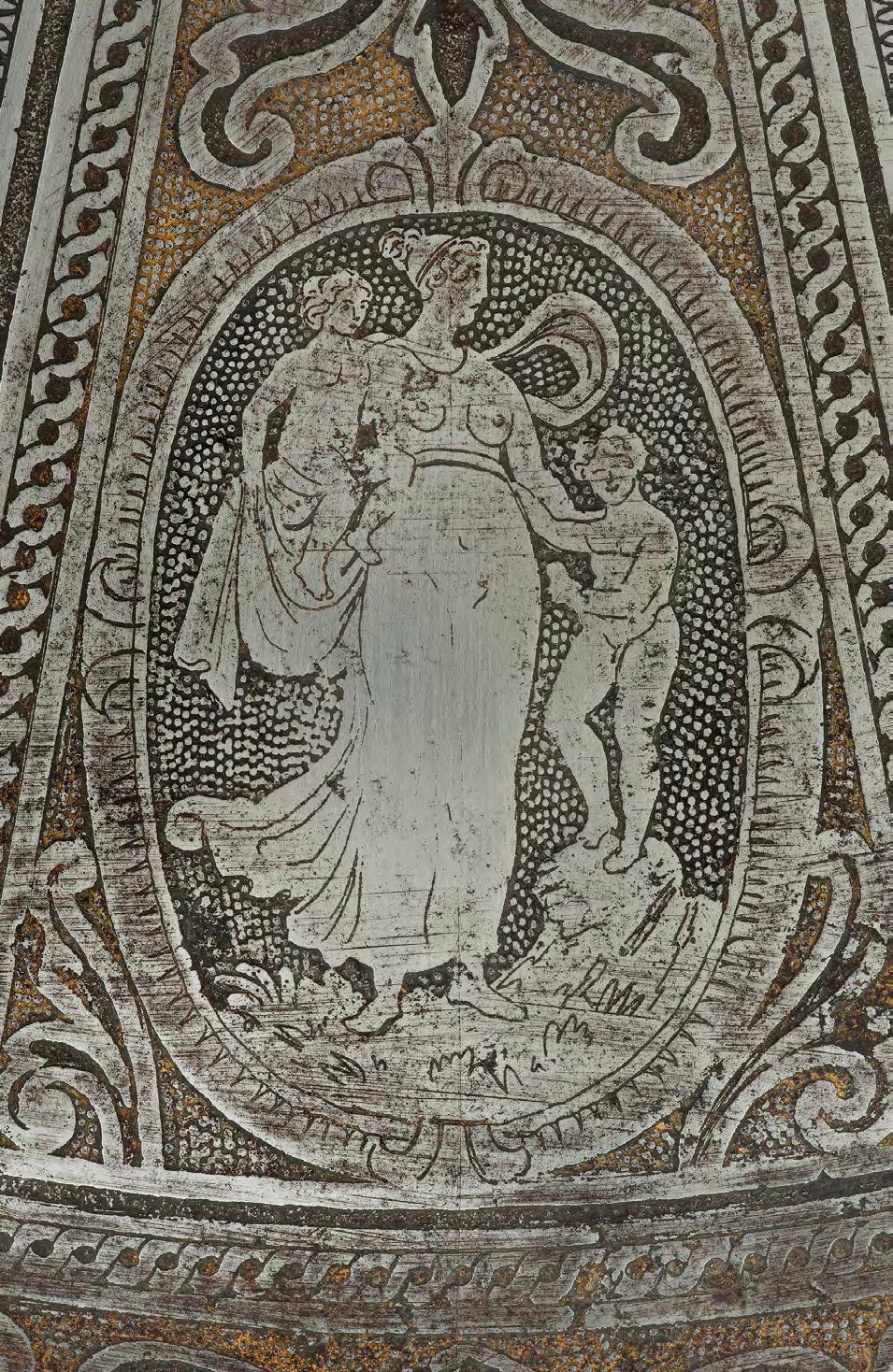
A Fine Cuirassier Three-quarter Armour
in the Manner of the ‘Master MP’ c. 1600 – 1620
Flanders (now Belgium), possibly Brussels. Steel, copper alloy, leather 173 cm × 45 cm / 68 × 17.7 in
PROVENANCE
Sir Guy Francis Laking, Bt. (1875-1919), sold privately within his lifetime. Subsequently included in the sale of Important Specimens of Arms and Armor … from XII to XVII Century, American Art Association, New York, 24th November 1923, lot 254 ($400). Acquired by The Metropolitan Museum of Art, New York. Sold Christie’s London, 22nd November 1960, lot 171 (£280) To Basil Robinson, later Keeper of the Department of Metalwork, The Victoria and Albert Museum, London, 1966-72, d. 2005. The Norman Fargo Collection, Sandpoint, Idaho; included in the sale of the collection in 2024
Armours of this three-quarters type were the product of the widespread use of hand firearms on the battlefield, fully established since about 1580. With this shift in the balance of tactical power, the heavy cavalry charge head-on with lances was no longer a force impregnable to infantry. The heavy cavalry were instead required to engage with greater speed and mobility, primarily against opposing horsemen, but even to fight on foot should the need arise. Full-length leg defences were abandoned as both unnecessary and impractical, the emphasis being placed on a bullet-proof breastplate, fully flexible leg defence to the knee only, and a lightergauge helmet no longer needed to defend against the momentum of an on-coming lance.
Now referred to as ‘cuirassiers’ (with their shot-proof cuirasses and remaining the most comprehensively armoured among the cavalry), the heavy cavalry was now armed with a sword, a pair of pistols and over time a short carbine also. When used effectively to sweep down upon an enemy from the flanks, the cuirassiers could sway the course of a battle against superior numbers.
The present armour accords exactly with the Flemish style of cuirassier armour developed within the later phases of the Dutch Eighty Years War, fought throughout Flanders and Brabant, the concluding decades of which merged to become the western element of the pan-European Thirty Years War (161848).
Typically, the breastplate bears the dent of a proving ball. Characteristic also of the higher-quality Flemish cuirassier armours are the scalloped inner edges of the component plates, most visible among the present arm and leg defences, together with the lavish use of brass decorative rivets also displayed here.
Comparable Flemish helmets with two-piece skulls fluted in this angular corrugated manner are in the Musée de l’armée, Paris (H. 150), the Hermitage Museum, St. Petersburg (Z.O. 3288), the Livrustkammaren, Stockholm (2645), The Art Institute of Chicago (2661) and The Smith Art Museum, Springfield, Mass. (17.23.9).


Similar to France but unlike London and the German centres of armour-making, almost all armour produced in Flanders in the late 16th and early 17th century, regardless of superior quality, was completed without having been struck with the maker’s mark, or a city armourers’ guild mark either. This practice has to some extent become a feature in the identification of Flemish work, aside of course from a number of subtle characteristics, together with those more obvious characteristics outlined above.
The present armour certainly ranks among the upper tier of Flemish armour produced within the opening decades of the 17th century. It also provides a rare instance in which it is possible, by stylistic and constructional comparison, to attach a degree of identity to a Flemish armour of this period. On this basis the present armour is judged to be closely related to a distinctive group of high-quality Flemish armours, which in some cases can be identified as the work of the ‘Master M P’. For the most part these armours are now preserved in the Royal Armoury, Madrid (A 380-401, A 414-21), having been purchased in Brussels in 1624 and 1625 for King Philip IV of Spain.
Further details concerning this maker are regrettably negligible, though it is thought very likely that he was a Brussels armourer, with these Madrid armours most probably acquired from his workshop there. It follows also, that the present armour will be the work of an armourer not only working in that city, but also within the close circle of influence of the ‘Master M P’. For exploration of the works of this enigmatic armourer we recommend: Walter J. Karcheski, Jr., ‘Notes on a Newly-Identified Armour by the Flemish Master ‘MP’, in The Smith Art Museum, Springfield, Mass.’, Journal of the Arms and Armour Society, XI, December 1985, pp. 307-14.
In the great period of gothic armour the city of Bruges had been the centre of armour production in Flanders, its leading armourers such as Jean and Martin Rondel being patronised by some of the most eminent ruling
figures across Europe, including Maximilian I both as king and Holy Roman Emperor. Within the same period, the city of Tournai housed 232 armourers, and Brussels also, as the preferred seat of the Dukes of Burgundy, attracted the production of high-quality armour. By the end of the 15th century there were 73 known armourers active in Brussels, with clients within the Burgundy/Habsburg court.
Over time the port of Bruges became silted; as the direct consequence of this the Brabantine city of Antwerp on the river Scheldt, came to prominence as the main Flemish port, as an important centre of international trade, wealth and culture. With this transfer of fortune Antwerp also became renowned for the high-quality of its armour-making. Armour produced in Antwerp reached the zenith of achievement within the third quarter of the 16th century, with the embossed and gilt Mannerist masterpieces of parade armour from the workshop of Elisius Libaerts, and similarly with the etched and gilt luxurious works of the Collaert family.
Antwerp’s fortune died with the regional spread of the Dutch Eighty Years War. In 1576 the city was sacked by Spanish Habsburg troops, during which at least 7,000 of the civilian population were killed.
The production of luxury armour all but ceased throughout Flanders, its armour-making now realigned with the demands of contemporary warfare. The existing mass export of Flemish plain munition armour had been fuelled over much of the second half of the 16th century by the continuous need to equip newly raised forces and mercenaries during the French Wars of Religion. By the outset of the 17th century, the making of superior-quality armour was almost certainly limited to the armourers of Brussels, the city as a whole being little-touched by the Eighty Years War. Brussels remained secure as a governing capital for the Spanish Habsburg administration and as a permanent hub for the Spanish standing Army of Flanders, which together provided a ready clientele among its officers of the nobility.

DESCRIPTION
The present armour comprises a close helmet with two-piece skull embossed with V-shaped flutes radiating downward from a ring finial on a stellate washer, the nape fitted with plume-holder, with pivoted peak drawn-out to a blunt point, visor embossed with a pronounced transverse rib pierced with a series of diagonal slots and a panel beneath them at each side pierced with numerous small ventilation holes, closed at the right by a hook-andeye, bevor closed by a strap, and fitted with neckguard of three lames front and rear; gorget of one plate front and rear; heavy shot-proof breastplate of late ‘peascod’ type and flanged outward at the base to receive a pair of tassets each of seventeen lames and divisible at the eleventh for service on foot, and with poleyns of six lames defending the joints of the knees, the third in each case embossed with a central rosette and formed with a pointed spadeshaped wing;
matching backplate extended at the sides within its working life, this corresponding with similar early alterations to the breastplate, fitted with armoured shoulder-straps for attaching the breastplate, and with a hinged bracket to attach a rear skirt of five lames; a pair of symmetrical pauldrons of eleven
lames connected by turners to articulated vambraces formed of tubular upper-and lower-cannons linked by a winged bracelet couter of five lames embossed with a central rosette;
a pair of fingered gauntlets each with strongly flared pointed cuff, metacarpus of five lames, knuckleplate, hinged thumb-piece and finger scales;
the main edges of the armour scalloped and bordered by pairs of incised lines, studded throughout with numerous brass rivets and retaining some original blued finish, the balance of the outer surfaces naturally oxidised to form a desirable finish.
Regarding the modern provenance of the present armour, Sir Guy Francis Laking, 2nd Bt., was in his time the leading published authority on the subject. In 1902 King Edward VII created for Laking the post of ‘Keeper of the King’s Armoury at Windsor’. He was also Inspector of the Armoury at The Wallace Collection, and in 1911 became first Keeper of the London Museum. Laking’s ‘A Record of European Armour through seven centuries’, together with his catalogues of the armouries of the Knights of St. John and the Winsor Castle armoury remain valued reference today.
A Model of an Armour for a Man and Horse in the 16th Century Style c. 1850
Probably
by E. Granger
Probably France, Paris. Steel, bronze, polished marble
54.5 cm × 19 cm × 41.5 cm / 21.4 in × 7.4 in × 16.3 in
PROVENANCE
Private collection, France
The man’s armour comprising a close helmet with a bellows visor, mounted on a single-lamed gorget with raised collar; the cuirass comprising a breast and backplate, the breastplate of peascod form fitted with a lance rest and with a fauld plate to which are attached tassets of five simulated lames; the fourlamed pauldrons large and symmetrical, attached by turners to articulated vambraces complete with winged couters; the gauntlets with shaped cuffs, five metacarpal plates and a knuckle plate; the legs formed of cuisses integral with five-lamed, winged poleyns, greaves and broad-toed, ten-lamed sabatons; the main plates with roped edges and etched throughout with bands and cartouches of gilt floral decoration.
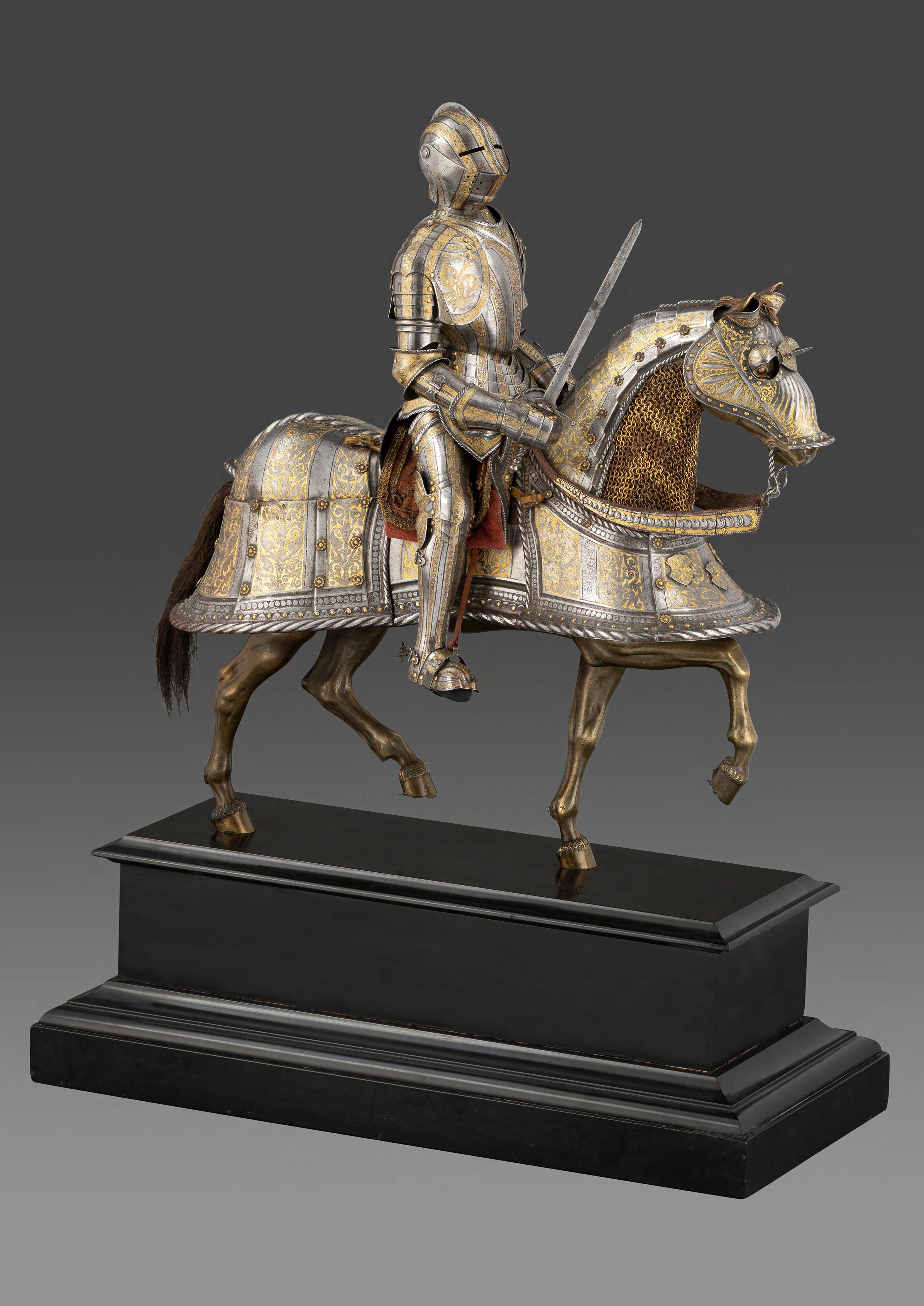
The armour for the horse comprising full fluted shaffron with broad hinged poll-plate , gutter-shaped ear-defences, side -plates, cupped eye-defences and an heraldic escutcheon with central spike at the brow; laminated crinet with mail throat-defence; peytral of three plates applied with three heraldic escutcheons; flanchards of one piece; and a deep crupper of five riveted plates; all decorated at all main edges with bold, roped, inward turns bordered by raised ribs and brass rivets, accompanied by a curbbit with reinforced reins, and a saddle with high bow, cantle-plates and stirrups all decorated with panels of floral pattern on a gilt ground. Mounted on an articulated mannequin astride a bronze horse, with a heavy polished marble base.
Edward Granger arrived in Paris by 1820 where he established a business at 70 Rue de Bondy, today Rue René Boulanger, registered as a maker of giltbronze jewellery and of occult items. As early as 1844 Granger exhibited the meticulously detailed miniature armours for which he became renowned at the Exposition des Produits de l’Industerie Française, after which the artist met with tremendous commercial success. Granger also created fullscale armours for the Paris Opéra and the Duchess d’Orléans. She requested a perfectly scaled etched three-quarter armour to fit a five year old boy – LouisPhilippe-Albert, Comte de Paris, later King Louis VII, pretender to the French throne and eldest son of the Duc d’Orléans. We had the privilege of handling this armour, which featured in our 2009 catalogue, no. 41. Granger’s armour for the young Louis was published as an engraving by the Musée Challamel in 1844; Granger was credited as ‘the distinguished Parisian Armourer’.

BLADED WEAPONS
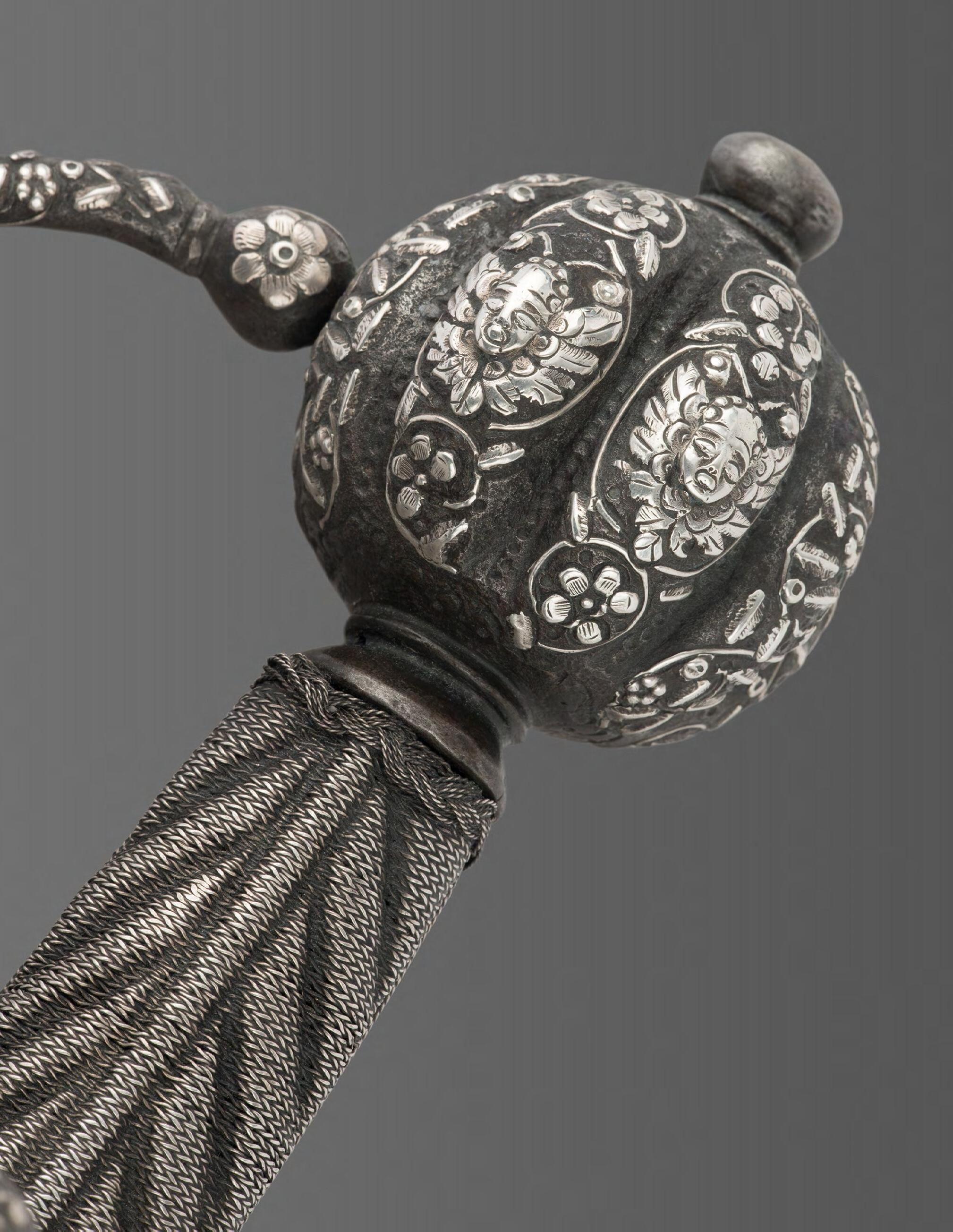

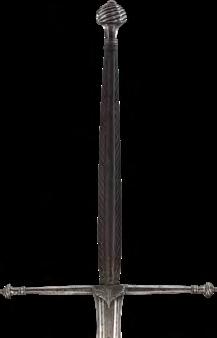

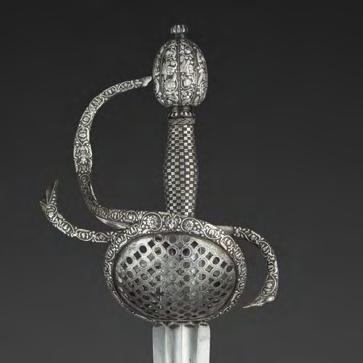
12
An Exceptional Italian Renaissance Hand-and-a-Half Sword
c. 1490 – 1500
13 A Two Hand Sword of Knightly Quality or Montante c. 1500 – 1530
14 A Swept-Hilt Rapier with Silver-Encrusted Hilt c. 1610
15 A Riding Sword with Silver-Encrusted Hilt of Distinguished Quality
c. 1625 – 35
An Exceptional Italian Renaissance
Hand-and-a-Half Sword
c. 1490 – 1500
Italy. Steel, copper-alloy, silver, gold, ebony and bone
The grip a later restoration 114.3 cm / 45 in (overall length)
PROVENANCE
G. P. Jenkinson Collection
Private collection, Germany
Private collection, USA
‘As in all other fields of applied art,’ observed the late Dr John Hayward when writing some years ago, ‘the high point of hilt design, either as ceremonial or fighting weapon, was reached during the Italian Renaissance in the fifteenth century.’ ‘The excellence of the weapons of this period’, he went on to note, ‘is reflected in their superb proportions and exquisite decoration.’ He felt this sword ‘worthy of the greatness’ of any of the Renaissance princes. Few could deny that this sword, with is elegant lines and rich ornament arranged in counter-changed panels of contrasting gold, silver and gilt copper-alloy, satisfies this criteria of proportion and decoration.
The gilt hilt of the sword comprises a flattened pearshaped pommel, and long horizontally re-curved flat quillons. Each part is cast and finely chased with running vine leaves, scrolling acanthus foliage, fleursde-lis and plaited ornament, and is inlaid at points with similarly decorated gold and silver panels and, in silver, a female bust whose breasts are bitten by serpents. Beneath is a gaping Medusa’s head from which further serpents rise. The later grip is decorated with a chequer pattern of freshwater mother-of-pearl and ebony panels. The double-edged blade, each side with a pronounced medial ridge, tapers to a point; inlaid in copper is a Lombardic M beneath a cross and the blade is etched at the forte with a pattern of imbricated scales.
LITERATURE
Dr J.F. Hayward, An Italian Renaissance Sword, in Arms and Armour at the Dorchester Ltd, London, 1982, p. 15-17
Dott. Mario Scalini, Reconsidering some Cerimonial Italian Swords of the Renaissance, Hieb- Und Stichfest: Waffenkunde und Living History, Imhof Verlag, Coburg, 2020, p. 75, illustrated p. 74
The quillons of the sword, like its pommel, are divided into panels of various metals: seven on one face and five on the other. The plaques are either chiselled in relief or engraved intaglio with conventional floral ornament. Each side of the cross is chiselled with the same plaited design as the edge of the pommel, while the tongue or langet, which was intended to cover the mouth of the scabbard, is chiselled with acanthus foliage issuing from a scallop shell and fleur-de-lis at its base. The purpose of this socket was practical: to prevent water from seeping into the scabbard and so rusting the blade, should the sword be exposed to rain or humidity.

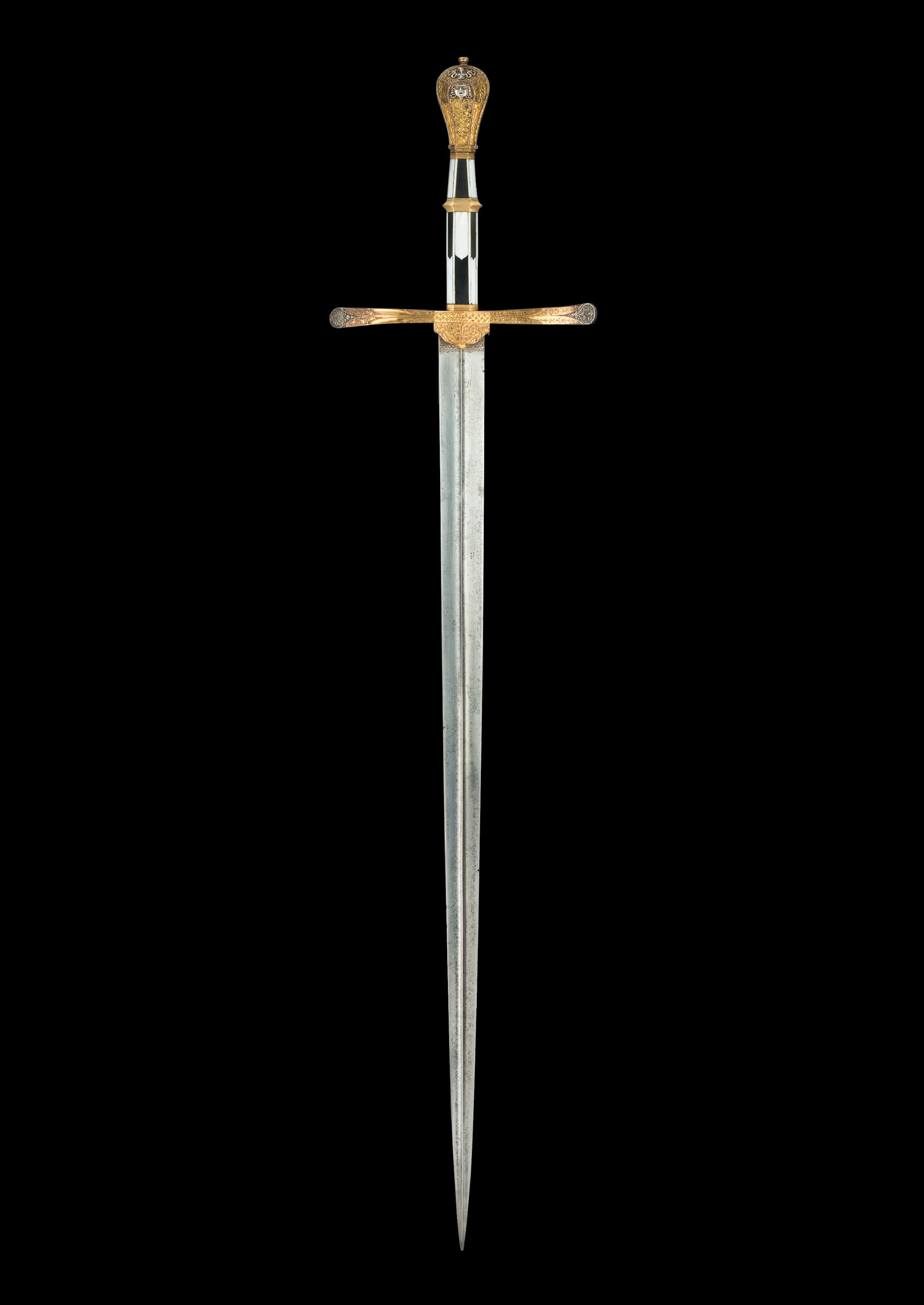
Although its superlative quality suggests that the sword was intended primarily for ceremonial use, its design nevertheless accords in all essential respects with that of a practical fighting weapon. Its long handand-a-half grip enable it to be wielded with either one or two hands as needed in combat, and its long, acutely pointed blade, would have been suited to both cutting and thrusting. The pronounced medial ridge that runs down each side of the blade serves to stiffen it, and would have made the sword better able to penetrate any gaps in the full plate armour favoured in Renaissance Italy.
Contemporary representations such the illuminations of Tallhofer’s Fechtbuch of 1459 (Schloss Ambras), and the painting The Coronation of the Virgin (1474, Museo Civico, Pesaro), by Giovanni Bellini, show that blades of this medially ridged pattern were fit to the hand-and-a-half sword type, and interestingly both images represent swords with hilts similar to the present example.
Surviving early Renaissance swords of a quality comparable to the present are few in number and invariably associated with persons of great wealth and rank of the period. Among the most celebrated of these is a sword in the Rüstkammer, Staatliche Kunstsammlung Dresden (no. hm.a36), identified in early inventories of the Saxon Electoral Armoury as that of Graf Leonhard von Görz (1440–1500). Though its pommel is of plummet-shaped rather than pear-shaped form, the two swords show a strong resemblance. The Rüstkammer blade is inscribed JESUS MARIA and IN ETERNVM, which has led to the idea that it was given to von Görz at the time of his marriage to the Mantuan princess, Paola Gonzaga, daughter of Luigi III Gonzaga in 1478.
A splendid sword today in the Hofjagd- und Rüstkammer, Vienna (no. a.170) made for Maximilian I, King of Rome and later Holy Roman Emperor (1459–1519) provides another comparison. Though it has a key-shaped pommel and straight rather
than re-curved quillons, it also bears a striking resemblance to the present sword. Its hilt, also of gilt copper-alloy, bears the inscription IN DIO AMOR which together with the representations of Amor and putti in the decoration of its blade has led to the suggestion that the sword was given to Maximilian at the time of his marriage to Bianca Maria, daughter of Duke Galeazzo Maria Sforza of Milan in 1493/4. This would also suggest the sword was created in Milan, then the greatest of all European arms-producing centres. Affording support for that view is the fact that a sword in the Museo Civico L. Marzoli, Brescia, again bearing similarities, was stated to be struck on its tang with the Sforza mark of a viper. Equally worth examination is the decoration of the so called ‘Martelli Mirror’ in the Victoria and Albert Museum, London (no. 8717–1867), which like the present sword involves gilt copper-alloy inlaid with silver and gold, and is thought to have been produced by the Milanese artist Caradosso Foppa (1452–1527) around 1495–1500.
Through a combination of skill and inventiveness, goldsmiths of Renaissance Italy brought to the decoration of arms a richness and vigour clearly in accord with the spirit of the age. More than in any other period, the nobleman of the Renaissance, with his passion for pageantry and display, looked to contemporary craftsmen to provide him with arms that could compete with or even exceed in splendour those of political rivals.
Hayward, in his assessment, observed that despite affinities with the sword in Dresden, the present sword excelled it in richness. Hayward believed the present sword to be the equal of Holy Roman Emperor Maximilian I’s wedding sword, and it thus remains tantalising, given the present sword’s opulence, to speculate upon the identity of its powerful original owner. The sword’s elegant ornament and harmonious proportions make it a true masterpiece of the Renaissance: bella e graziosa – beautiful and gracious.
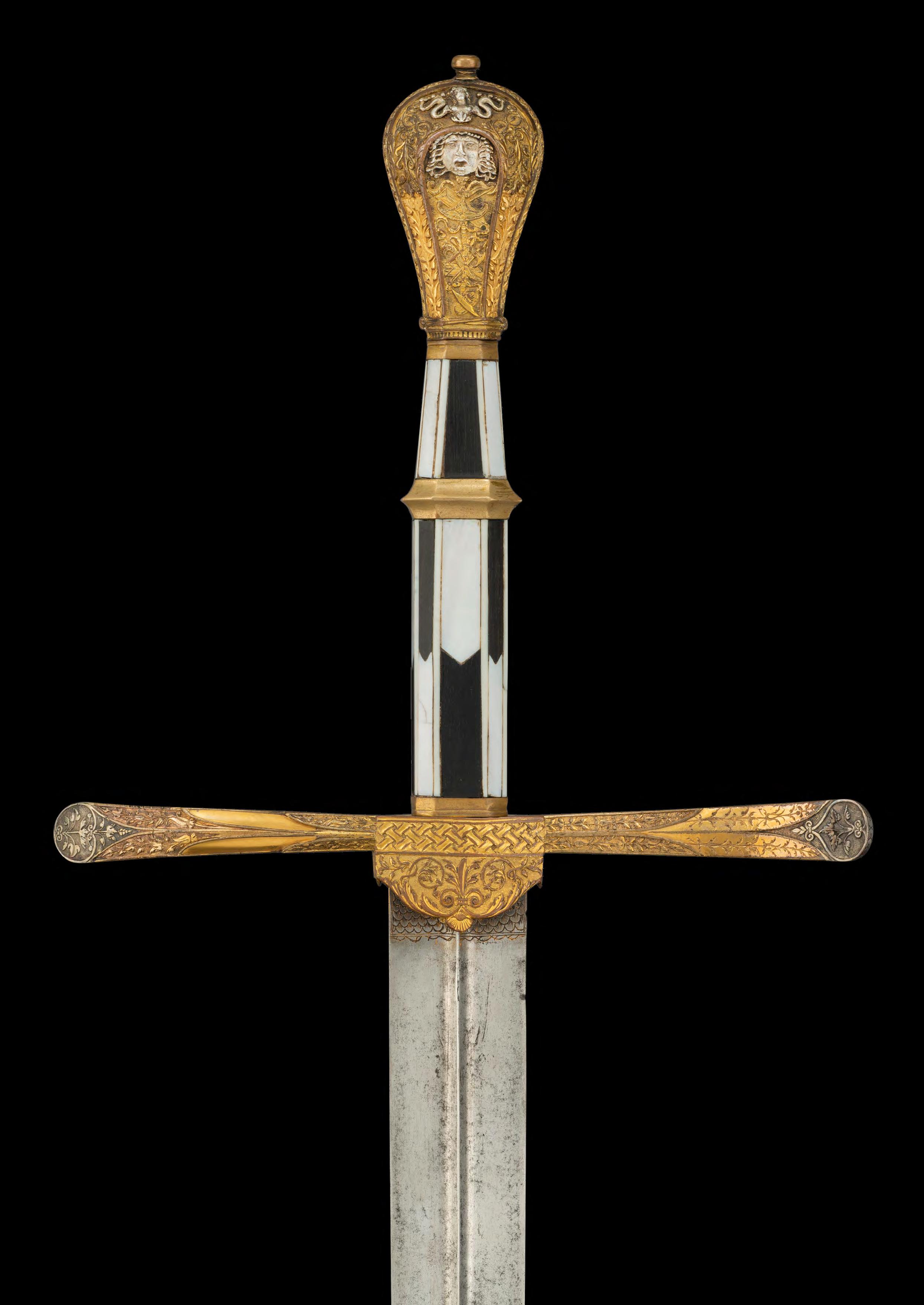

A Two Hand Sword of Knightly Quality or Montante
c. 1500 – 1530
Spain, Toledo. Steel, wood 158 cm / 62.2 in (overall length)
Provenance
The Gozena Collection, Seville, until 1895. Acquired by the pre-eminent collector Charles Alexander, Baron de Cosson (1846-1929)
Sold Sotheby & Co., The Very Choice Collection of Armour and Weapons of the late Baron C.A. de Cosson, 14th May 1929, lot 89.
William Randolph Hearst for £ 78 Private collection, United States
Finely balanced and proportioned for two-hand combat in the field or in the tournament lists, this sword is among the finest and best-preserved fighting swords from the early 16th century to come to the market in very many years. Spanish swords of this period are rare, exceptionally so in private ownership.
The hilt comprises a faceted crosspiece tapering slightly towards the ends, with a medial block faced by a pair of écusson cut with symmetrical leaf ornament front and rear and with spirally fluted button terminals each rising from a swelling faceted neck rooted on a moulded collar. With a strongly formed pommel cut to match the crosspiece terminals, and moulded grip formed on each side with a single full-length vertical flute flanked by a fluted herringbone pattern, the grip professionally re-bound with cabled wire between wire ‘Turk’s head’ knots, the binding probably 19th century.
The blade of very slender construction with an elongated ricasso, its lower portion cinched in the 15th century Spanish fashion, drawn-out to form a pair of short pointed lugs with concave inner edges and bordered on each face by a pair of narrow grooves, each within an incised linear frame minutely punched at intervals. The remaining length of the blade changing to flattened hexagonal section
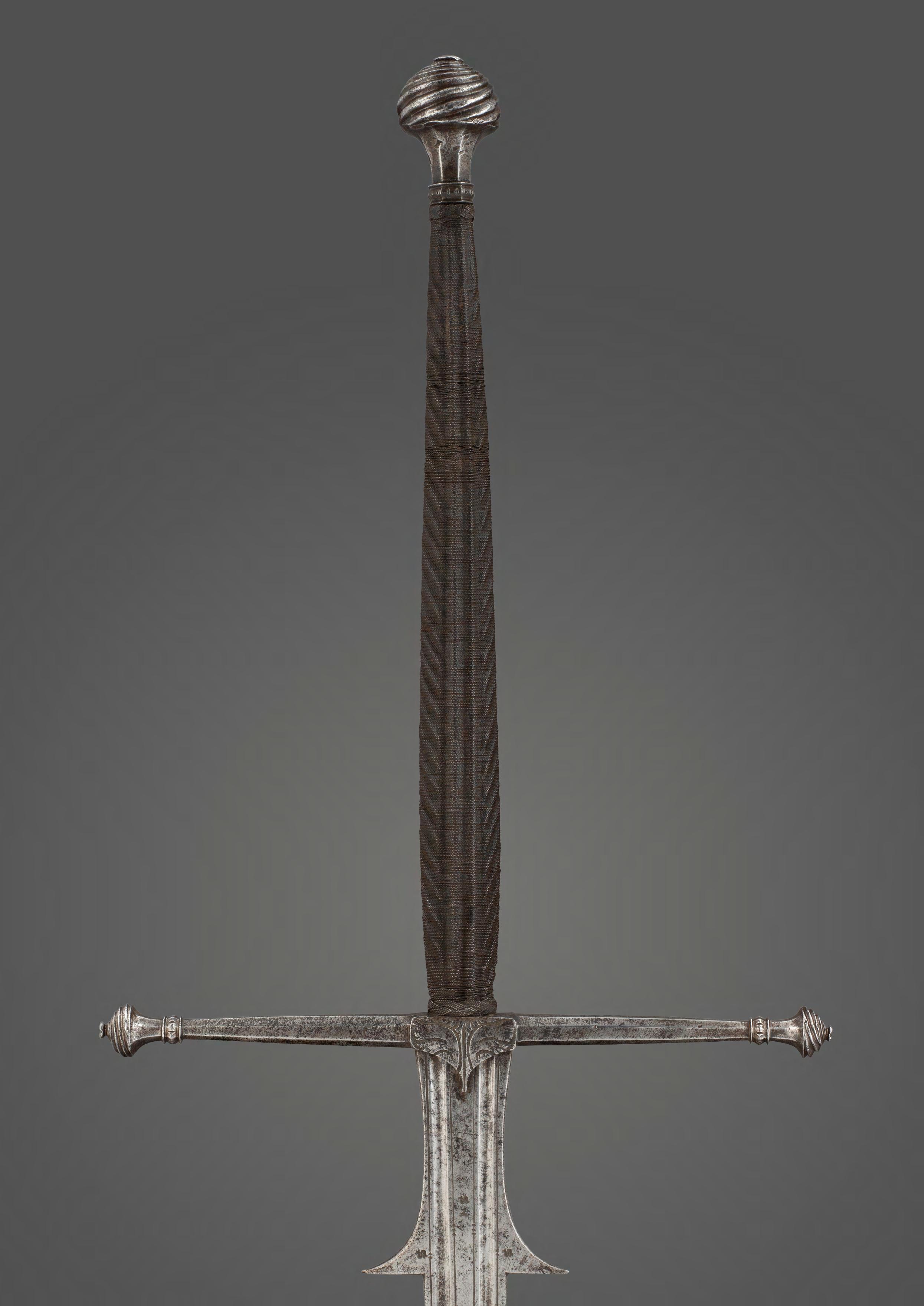

and double-edged, tapering evenly to a point. The ricasso struck with a series of Spanish bladesmith’s small marks matching front and rear, a triangular arrangement of the monogrammed letters I S set on their side, together with a letter T beneath the point of the triangle, presumably for ‘Toledo’.
A cinched but somewhat shorter ricasso forming part of a blade of comparable proportions is found on a two-hand sword in the Royal Armoury, Madrid (RA G 15). This sword is ascribed by Boccia and Coelho to circa 1450-60, together with the tentative suggestion that it was made in Rome (see Armi Bianchi Italiane, 1975, cat. no. 122).
Another related detached blade, with the ricasso again of this distinctive type (and struck with a mark similar to that on the preceding example) is in the royal collection in Madrid also (RA G 5). This blade is recorded in the inventory of the Aragonese Pope Calisto (Callixtus) III, having been presented to him in 1458, the year of his death, by Henry IV, King of Castile and León.
The pope had been a driven advocate of a crusade to be launched against the Ottoman Turks following their conquest of Byzantium in 1453, a sentiment reflected in the presentation inscription. Born into a wealthy Aragonese family, Pope Callixtus III had previously served as Bishop of Valencia and as a diplomat for the Spanish Kings of Aragon (Boccia and Coelho, ibid, cat. no. 109/110).
The refined qualities of the present blade and hilt compare more closely, however, with the elegant two-hand swords made within the first quarter or so of the 16th century and attributed to both Spanish and Italian sources. A comparable but lesser quality example, ascribed to Venice, circa 1520, is in the Museo Bardini, Florence (BD 524): see Boccia and Coelho, ibid, cat. no. 315.
Another, with a closely comparable blade and ascribed to circa 1550-1600, is in The Cleveland Museum of Art (acc. 1916.1509).

A Swept-Hilt Rapier with
SilverEncrusted Hilt
c. 1610
Germany. Steel, silver and wood (1548)
120 cm / 47.5 in (overall length)
PROVENANCE
Private collection, USA
Private collection of the former chairman of The Royal Armouries, Leeds
The swept-hilt rapier is not only one of the most elegant forms of sword ever devised, but also one of the most interesting. At the height of its popularity in the late sixteenth and early seventeenth centuries, considerable variation could be found in the number and arrangement of the several guards that made up its hilt.
Two features in particular serve to characterise the hilt of our rapier: the first is its possession of a forward quillon as well as a rear one, and the second, its possession of two diagonal outer loop guards respectively linking the lower end of the knuckle guard to the proximal end of the rear quillon and the proximal end of the front quillon to the lower end of the rear arm. A portrait of David Joris, probably by Jan van Sorrel, in the öffentliche Kunstsammlung, Basle (inv. No. 561), shows this combination of features to have existed as early as about 1540–5. The form of inner guard seen on the hilt of our rapier, however, is unknown before its appearance in Sir Martin Frobisher’s portrait of 1577 by Cornelis Ketel, in the Bodleian Library, Oxford.
Closely resembling that of our example, except in having chiselled rather than encrusted ornament, are the hilts of two rapiers respectively preserved in the Musée de l’Armée, Paris (inv. No. PO 2024), and the Metropolitan Museum of Art, New York (acc. No. 14.25.1190). They have not only spherical pommels, but also spherical mouldings decorating their guards. Of perhaps greater relevance to our example, because of their possession of silver-encrusted ornament, are the hilts of three further rapiers of the pattern under discussion: one in the Deutsches Historisches Museum, Berlin (inv. No. W 602), and two in the Wallace Collection, London (cat. Nos 583 and 583). Another, in the Collezione Odescalchi, Rome (inv. No. 335), is of interest in showing details generally associated with English swords of the early seventeenth century.
Silver-encrusted decoration involving winged cherubs’ heads of the kind found on the hilt of our rapier is in fact a relatively common feature of highquality English swords of the early seventeenth century, believed in some cases to have been made by the royal sword cutlers Thomas Cheshire, Nathaniel Mathew and Robert South of London.
A royal warrant of 1614, for instance, authorised a payment to the second of those makers for, among other things, a sword decorated with ‘cherubyn heads de argento damasked’.
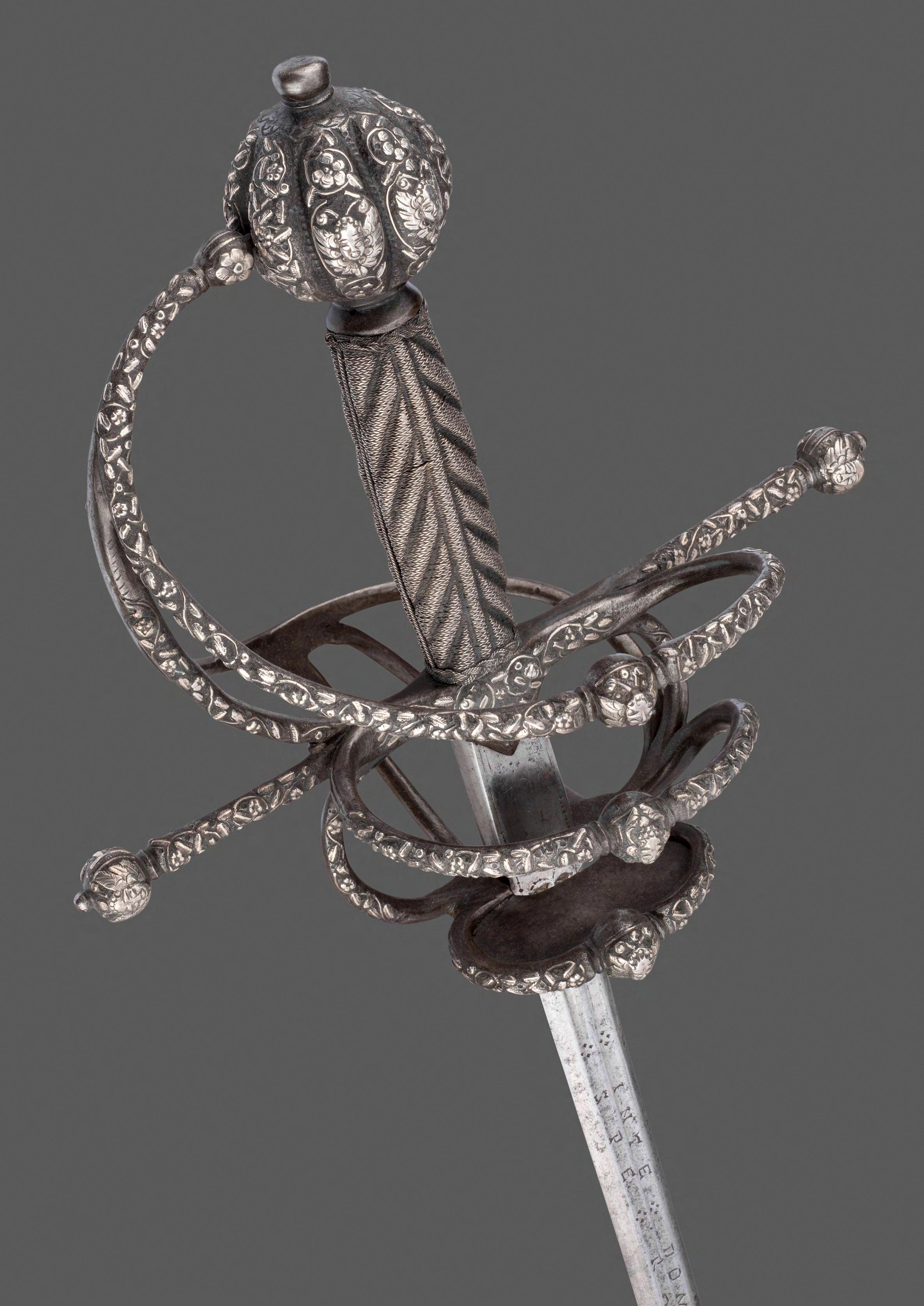
Such decoration was nevertheless popular throughout much of northern Europe. It is found for example on the hilt of a German rapier of about 1610 in the Royal Armouries Museum, Leeds (inv. No. ix. 877), as well as on another of the same date and origin in the Collezione Odescalchi, Rome (inv. No. 415). This latter, aside from the fact that it lacks outer loop guards, is constructionally similar to that of ours. It even has a large vertically grooved pommel. Two further silver-encrusted swords possessing pommels of this type can be seen in the Schweizerisches Landesmuseum, Zurich (inv. Nos LM 16736 and 16988). The first belonged to Hans Gugelberg von Moos (recorded 1562–1618), and the second to Rudolf von Schauenstein (recorded 1587–1626), whose name appears on its blade along with the date 1614. A third resembling them is in the Royal Armouries Museum, Leeds (inv. No. ix.1033). It seems probable from the foregoing that our rapier, like the pieces just discussed, was made in Germany.
That would almost certainly be true for its blade which bears the mark of an orb and cross, commonly found on the works of the sword cutlers of the north RhineWestphalian city of Solingen, then Europe’s leading producers of sword blades. Their Latin, however, seems not to have matched their metalworking skills. The inscriptions can be seen as an alternate phrasing of the last two lines of the Te Deum:
In te, Domine, speravi non confundar in aeternum (In you, Lord, I have hoped may I never be put to shame)
– sentiments to which the owner of any sword would have done well to subscribe.
With hilt of iron formed of a vertically grooved spherical pommel with waisted neck and small tang button, and guards of circular section comprising knuckle guard, long straight quillons supporting a pair of semicircular arms linked at their lower ends by an oval side ring enclosing a flat plate, two diagonal outer loop guards respectively linking the lower end of the knuckle guard to the root of the rear quillon and the root of the forward quillon to the lower end of the rear arm, and three inner loop guards diverging from the lower end of the knuckle guard to the lower ends of the arms, the quillons and the upper end of the knuckle guard each terminating in spherical finials, and the outer loop guards and side ring each interrupted at their centres by spherical mouldings between a pair of constricted mouldings, all except the inner loop guards and the inner faces of the arms richly decorated overall on a blued ground with silverencrusted foliate scrolls and flower-heads inhabited at points by winged cherubs’ heads, grip of wood carved with a repeated chevron-pattern and bound with fine twisted silver wire between Turks’ heads, and long slender blade of hexagonal section formed at each side of the ricasso with a single broad fuller, and at each side of the forte with a pair of narrow fullers respectively struck with the inscriptions INTE + DOMINE and SPE + RAVIT accompanied by an orb and cross on one side, and NONCONFODAT and INETERNVN on the other.
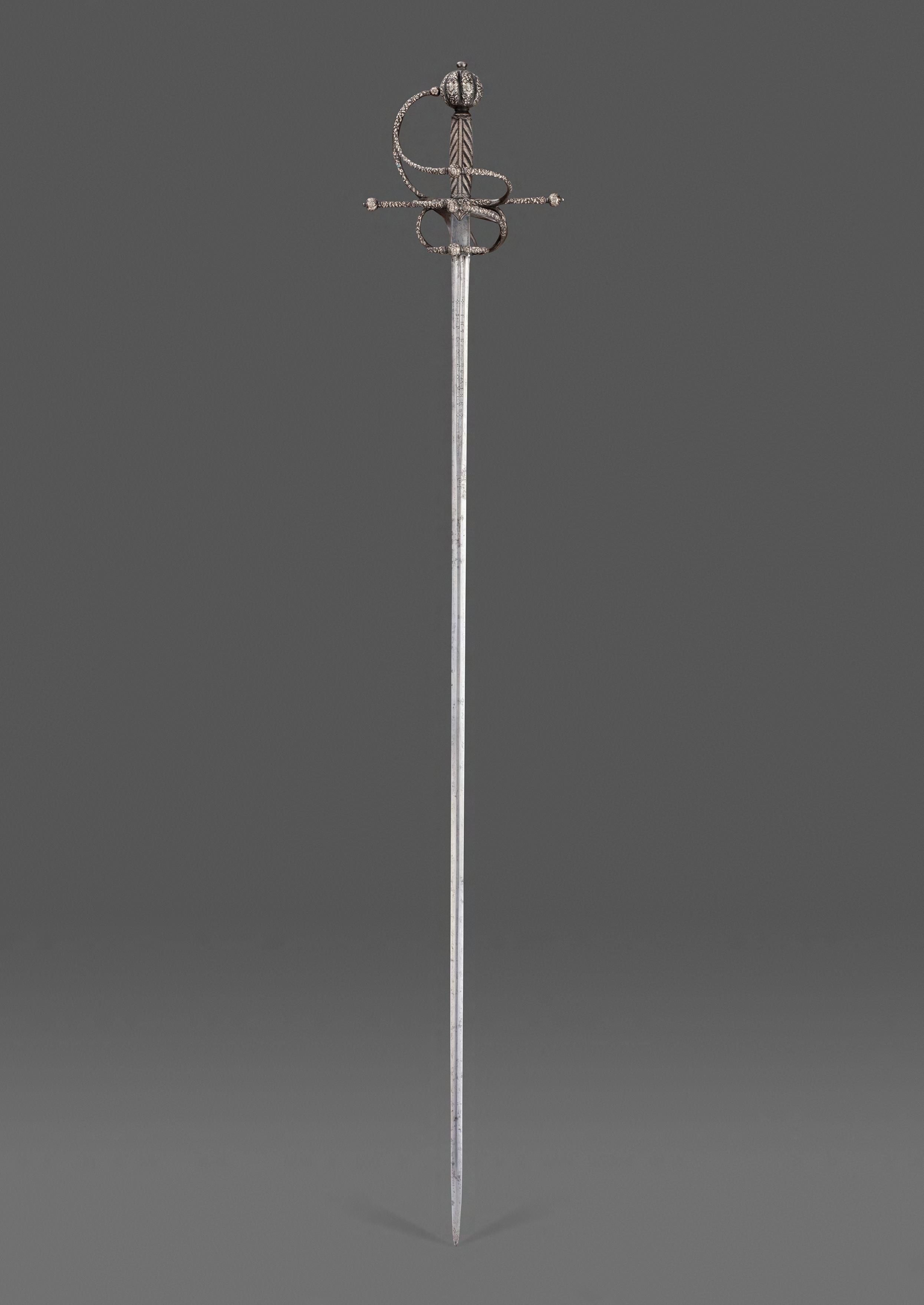
A Riding Sword with Silver-Encrusted Hilt
of Distinguished Quality
c. 1625 – 35
Germany. Steel, silver, wood
110 cm × 22 cm / 43.3 in × 8.6 in
PROVENANCE
Swedish ancestral collection
The exceptional quality of this hilt has the added dimension of historic interest arising from its ancestral Swedish ownership. The original owner would undoubtedly have been a member of the Swedish nobility. With that perhaps, it is reasonable to suppose he was engaged within the tumultuous period of Swedish military campaigning across northern and central Europe.
Both practical and supremely elegant, riding swords with rapier hilts sharing the constructional style of the present example would seem to have been popular among senior officers in the Swedish service during the Thirty Years War (1618-48). This vogue probably radiated from members of the royal circle of King Gustavus Adolphus (r. 1611-32), whose surviving personal weapons also reveal a preference for this style. The hilt of the king’s silver-encrusted rapier not only shares the typological characteristics of the present hilt, but ause of conspicuously naturalistic flowers, similar to those within the silver decoration of the present hilt; this rapier from the royal wardrobe is preserved in the Livrustkammaren, Stockholm (inv. 1845).
Another of the royal rapiers, the hilt being of the same constructional type as this but instead made of plain gilt-iron, is believed to have been carried by the king at the battle of Dirchau in 1627, where it was extensively damaged; this too is in the Livrustkammaren (inv. 1947).
Evidence of a further link between this present type of sword and the Swedish royal court is provided by the related hilt in a portrait, dated 1624, of Friedrich Kasmir, Pfalzgraf von Jülich, Cleve und Berg; the sitter was second cousin and brother-in-law to Princess Katarina of Sweden, mother of King Charles X. The portrait hangs in the Swedish royal residence of Gripsholm castle, Mariefred.
Further closely related hilts coupled with a historic Swedish provenance include the sword of Colonel Måns Silverjelm, of the Västgöta Regiment, killed in 1645 (Livrustkammaren inv. 4311), together with that of Governor Melchior Wernstedt, who also died in that year: his sword is preserved in Roslagsbro Church, Uppland. While yet another, a rapier ascribed to circa 1630, is in the Army Museum, Stockholm (inv. D 17532).
The constructional grouping of the hilts to which each of these and the present example belong is defined chiefly by the single large side-ring which is sharply up-turned towards the hand, its top supported by a loop-guard and filled with a pierced sprung-in plate. In historic portraiture, the earliest example of a hilt of this type dates from circa 1625, in a painting by Frans Hals, in the Alte Pinakothek, Munich (inv. 14101). Another example is in a painting by Cornelis de Vos dating from the 1630’s, which is in the National Museum, Stockholm (cat. no. 689).
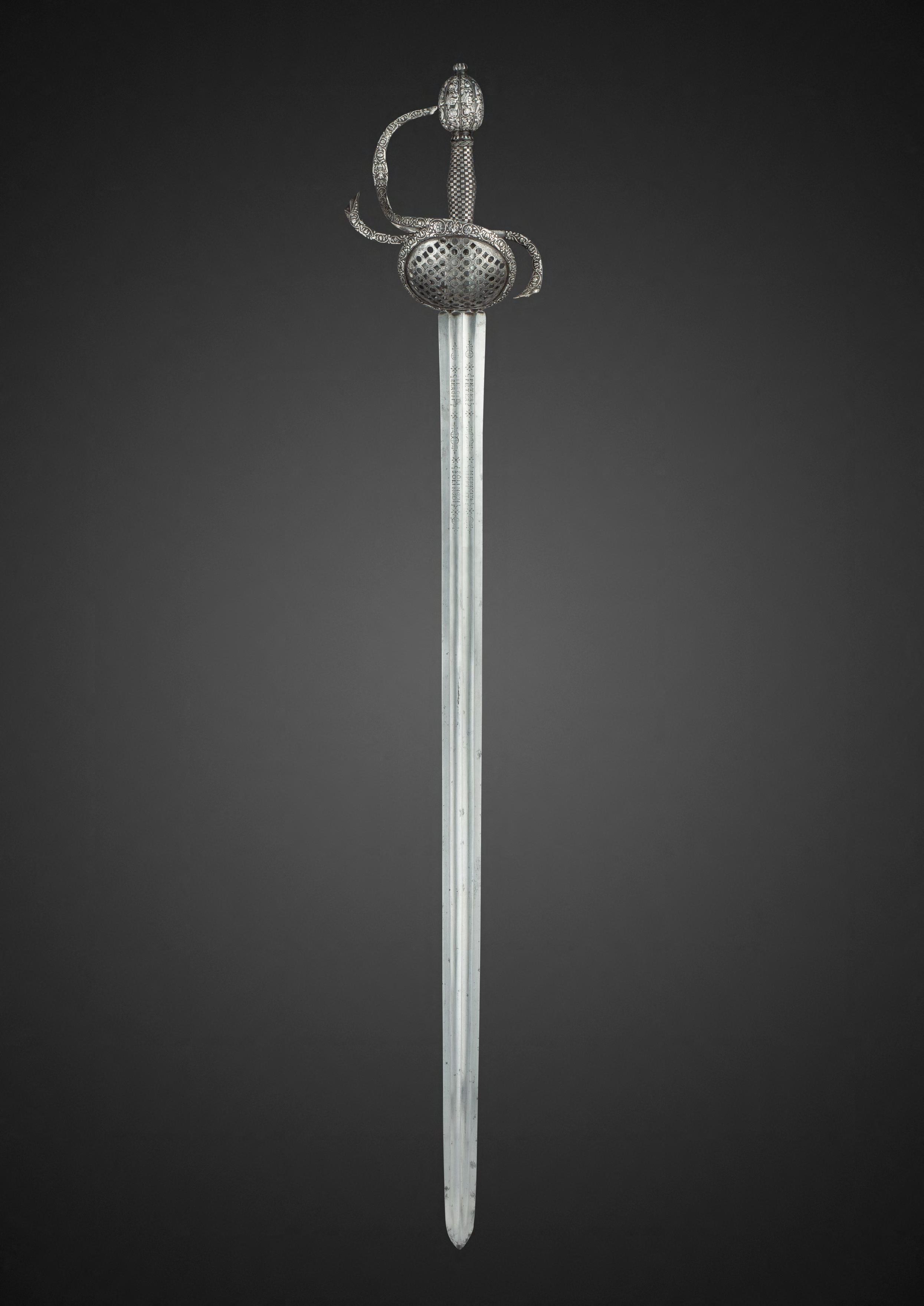
The configuration of the inner-guard of the present hilt again conforms to a recorded type, identified by the thumb-ring linking the quillon-block to the centre of an ogival ring-guard. Matching the outer-guard, this is up-turned and filled with a pierced plate. An example of this configuration exists in the rapier hilt in the Army Museum, Stockholm, referenced above.
The process of inlaying silver (or gold) decoration onto iron is in general referred to as damascening. In the present instance this inlay forms an attractive relief pattern rather than one which is conventionally flat. The relief work is referred to as ‘encrustation’, and the small silver motifs of the encrusted design are further enlivened by engraving these in minute detail. Regarding the present hilt once more, the untouched and high degree of preservation of the silver ornament is made apparent by the clarity of its engraved detail.
The exception (and observed widely among other examples) is the flat damascening applied over the pierced plates front and rear, and about the inner ring-guard also. Understandably this flat treatment was considered sufficient in providing a plain contrasting ground to the pierced design of the plates, also providing a balance with the complexity of the predominant patterns elsewhere. Also, in expectation of normal wear from the suspension of the hilt next to the body, the abandonment of relief ornament about the inner-guard is rightly excused. In place of this, the silver borders are deliberately finished flat and engraved with an imbricated pattern set within silver beaded lines.
Over the bars of the hilt the encrusted ornament takes on a complexity found among the higher quality hilts of the period.Taking advantage of the linear nature of these parts, the design is made up around an undulating pattern of slender tendrils interspersed with husks, ballflowers, conventional flowerheads, acorns and elongated leaves, which in part resemble ears of wheat, and all on a ground sown with minute silver pellets. At the centre of the ring-guard both ends of the tendril pattern loop about a pair of expanded large rosettes, framing between them a half-eagle, neo-armorial with wings displayed.
The elegantly tall pommel is cut with a bold gadroon pattern segmented by silver beaded lines and echoes the previous encrusted themes, making further use of large rosettes and to which are added running hounds and sphinx-like creatures alternating about the middle ground. The grip-binding of patterned silver wire is made luxurious by a chequered design of small silver rectangles and set between a pair of wire ‘Turk’s head’ knots over the ends.
Few 17th century silver-encrusted hilts remain in this little-used state, the present hilt comparing in this respect with the silver-encrusted hilts of five rapiers and two of the daggers in the James A. de Rothschild Collection at Waddesdon Manor.
Another silver-encrusted rapier with a pommel closely related to the present example was formerly in the collection of Lord Astor of Hever.
The blade of the present rapier is in a similarly fine state of preservation. Stylistically this blade conforms to the robust type frequently associated with riding swords, that is to say the type of combined cut and thrust sword intended for use from the saddle in the late 16th and 17th centuries. Typical of the period, this blade is double-edged, cut with a pair of broad fullers running over its entire length on both sides, and tapers evenly over is length to a point. This blade type, of greater practicality in warfare than the conventional slender rapier type, exists in conjunction with rapier hilts intended for campaign use.
The thumb-ring forming a part of the inner-guard on the present hilt is equally a typical element of the riding sword. A closely comparable blade can be seen on the silver-encrusted German riding sword formerly in the collections of the Barons Nathaniel and Albert von Rothschild, sold Christie’s London, 8 July 1999, lot 66.
The blade is signed by the cutler or bladesmith in a series of letters stamped within the parallel fullers on both sides: ‘ PETER BERG / ME FECIT SOLINGEN’ repeated in two tiered parts punctuated by a series of repeated decorative marks, and including the Reichsapfel mark arranged in pairs

(an orb of office involving the letter ‘S ’ repeated over respective sides of the cross: ref. Weyersberg, SolingerSchwertschmiede des 16. und 17. Jahrhunderts und ihreErzeugnisse, 1926, Pl. IV, fig. 201 D). The ricasso is additionally struck over sides with a mark in the Toledo fashion, repeated multiply, a marketing practice customary among 17th century German bladesmiths.
The relationship between the encrusted silver work seen on both English and German hilts dating from circa 1605-20 is without doubt a close one. Direct parallels exist in both the overall styling and in much of the detail found on hilts ascribed to each country. This closeness is such that (the specific work of identifiable English royal hilt-makers aside) the majority of those hilts wishfully attributed to an English origin are only safely identified as such by certain national characteristics in their constructional form, rather than by their encrusted decoration.
This cultural fusion is explained by the arrival in England of German hilt-makers and silver smallworkers within the reign of James I (r. in England 1603-25), fulfilling the fashion-driven demand for fine silver-encrusted hilts derived from their native working style. A good example of the very close similarities existing is found between the present German hilt and the surviving by-knife, pommel and crosspiece of the English cross-hilted sword made for the Earl of Kimberly after 1607 (Claude Blair, ‘An English Sword with an Ottoman Blade in the Swiss National Museum – The Hilt and Scabbard’, in Blankwaffen, ed. Karl Stüber and Hans Wetter, Zurich 1982.
In A.V.B. Norman’s detailed published survey of this present type of rapier hilt (type 84 and inner- guard type 39), he concludes that surviving examples of this type are rare. We are indebted to this author’s seminal study, The Rapier andSmall-Sword, 14601820, London 1981.
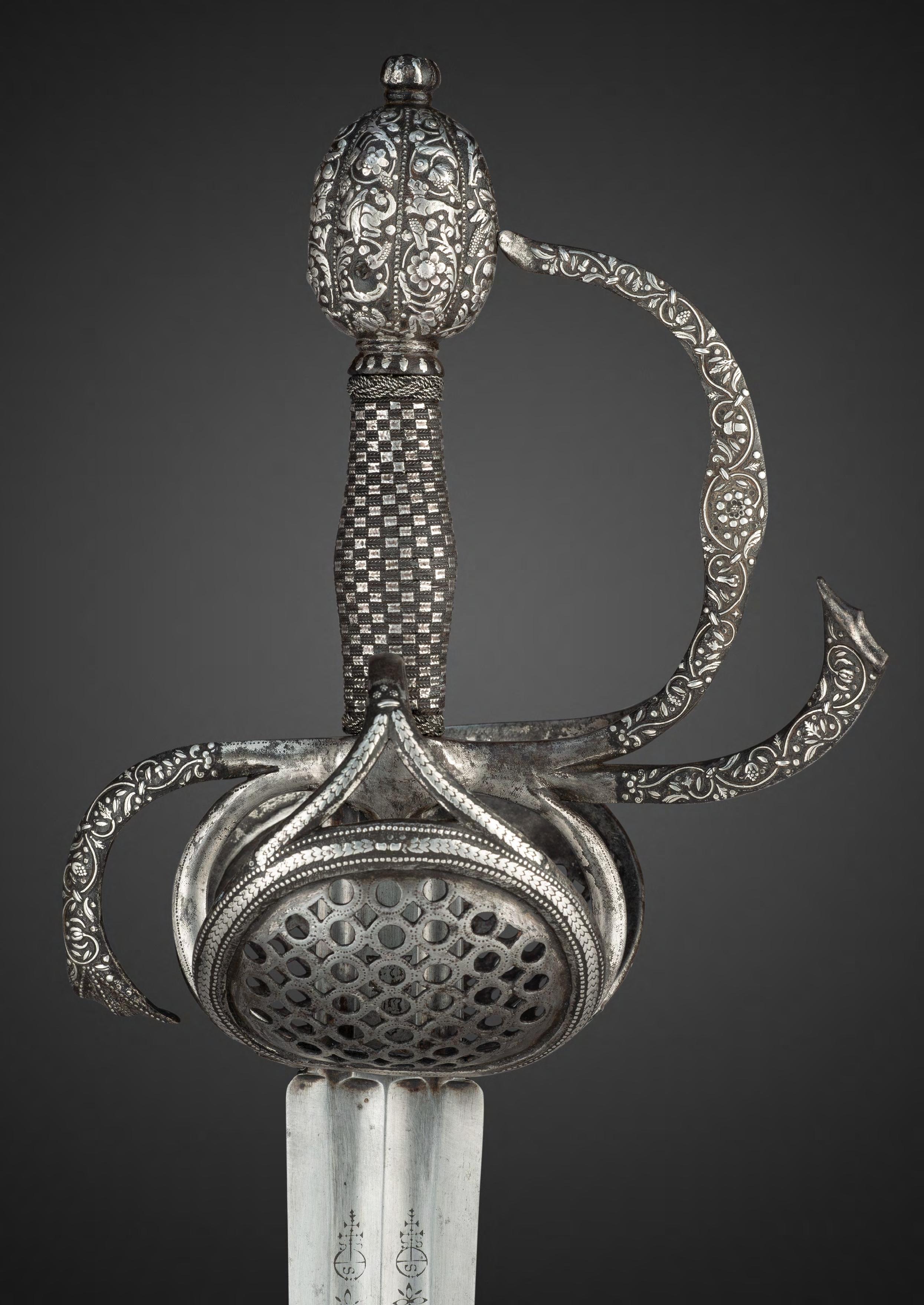
POLEARMS

16
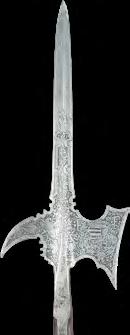

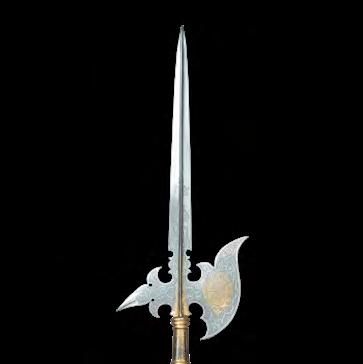
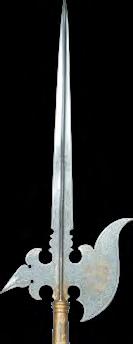
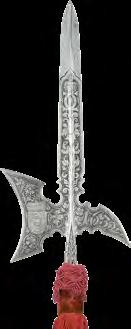

An Extremely Rare Habsburg State Halberd of the Trabantenleibgarde of Ferdinand I, Archduke of Austria c. 1545 – 55
17 A Fine Glaive Made for the Guard of the Holy Roman Emperor Maximilian II dated 1564
18 A State Parade Halberd of the Personal Bodyguard of Elector Christian II of Saxony c. 1600
19 A State Parade Halberd of the Personal Bodyguard of Elector Christian II of Saxony c. 1600
20 A Superb Etched State Halberd of the Trabantenleibgarde of Prince Karl Eusebius von Liechtenstein dated 1632
21 A State Glaive carried by the Personal Guard of The Emperor Leopold I dated 1666
An Extremely Rare Habsburg State Halberd of the Trabantenleibgarde of Ferdinand I, Archduke
of Austria c. 1545 – 55
Southern Germany (Augsburg or Nuremberg). Steel, wood 203.2 cm / 108 in (overall length)
PROVENANCE
Peter Finer, 1996
Private collection, United States
Ferdinand I (1503-64) was the younger brother of the Holy Roman Emperor Charles V. Born and highly educated in Spain, he was created Archduke of Austria in 1521; in 1531 Ferdinand was elected King of the Romans, the title confirming him the designated successor to Charles V as emperor.
In terms of its construction alone, the present halberd is for the most part closely related to the better-known series of Habsburg trabanten halberds dated 1558, carried by Ferdinand’s guard following his coronation as Holy Roman Emperor in that year.
The notable constructional difference between these and the present, perhaps uniquely surviving example, is the variation of the leading axe blade on the present halberd, the uppermost point of which is intentionally finished in a comparatively truncated shape.
As a possible sole surviving example of its type, this very obvious difference is an anomaly among all of the known Habsburg trabanten halberds, ranging from the reign of Ferdinand I as emperor, to that of Ferdinand III, Archduke of Austria from 1625.


The present etched decoration also belongs squarely within the middle decades of the 16th century rather than within the period of Ferdinand III, as was formerly the suggestion (the etched metalwork associated with the Saxon Electoral court being the isolated exception). Unlike the etched patterns which are seen in the successive Habsburg halberds and glaives, which display an increasingly open and refined style of scrolling foliage, the corresponding etching on the head of the present halberd is formed as a tightlypacked interlace of very slender spiralling tendrils, involving stylised diminutive leaves, and all of which contrasts against a blackened lightly granulated ground.
Suspended on one side within this pattern are a series of enigmatic etched motifs from the German renaissance palette, a monster abutting a trophy-ofarms, together with a squirrel and an ostrich; on the leading blade are the etched letters ‘E F’, abbreviating the inscription ‘Erzherzog Ferdinand’ (Archduke Ferdinand).
Dividing these letters are the arms of Ferdinand I as archduke, the quarterings being those of the House of Habsburg-Austria, comprising the arms of the Kingdoms of Hungary and Bohemia, Castile and Leon, those of Habsburg Old Burgundy, and together with an in-escutcheon charged with the arms of the Kingdom of Croatia. The shield of arms is surmounted by a Habsburg archducal coronet and enclosed by the Collar of the Order of the Golden Fleece.
On the opposite face of the leading blade, an owl is perched upon an arm of the armorial Ragged St. Andrew’s Cross and Fire-steels of the Duchy of Burgundy, a Habsburg Archducal coronet above; suspended over the rear fluke is a Triton and marine monster, together with a cornucopia and a flowering vase.
The quartering of Ferdinand’s archducal arms on this halberd attest to his claim to the Kingdoms of Bohemia and Hungary in 1526, following the death of his brother-in-law, King Louis II of Bohemia and Hungary.
The Burgundian ragged cross of St. Andrew, together with its armorial fire-steels, passed to the House of Habsburg Austria after the marriage in 1477 of Maria, daughter of Charles the Bold, Duke of Burgundy, to Maximilian I (later the Holy Roman Emperor Maximilian I).
In the service of Ferdinand both as Archduke of Austria and as Holy Roman Emperor his personal guard of elite troops was naturally charged with his protection on state occasions, but crucially also guarding him closely on diplomatic journeys and armed expeditions in the far from stable climate of the vast empire. This instability is highlighted for example by both the lengthy and acrimonious process of Ferdinand’s disputed succession to the Hungarian throne, and by the continuous threats posed by the Ottoman empire. In 1529 Ferdinand had defeated the Turkish incursion against Vienna, but the danger was renewed both in 1532 and 1541.
In 1527/8 Ferdinand’s archducal guard was formed of a Trabantenleibgarde of forty-three men armed with halberds, in conjunction with the ‘archer guard’ (Hartschierenleibgarde) forty strong, carrying etched spears or glaives.
While examples of these decorated arms carried by the guards of Ferdinand I as emperor are preserved in museum collections internationally, none other than the present halberd appear to have survived from the period of his archduchy. Examples from the imperial period not surprisingly exist in multiples in the historic Habsburg collections in the Leibrüstkammer of the Kunsthistorisches Museum, Vienna, and in the Vienna City Arsenal Museum.
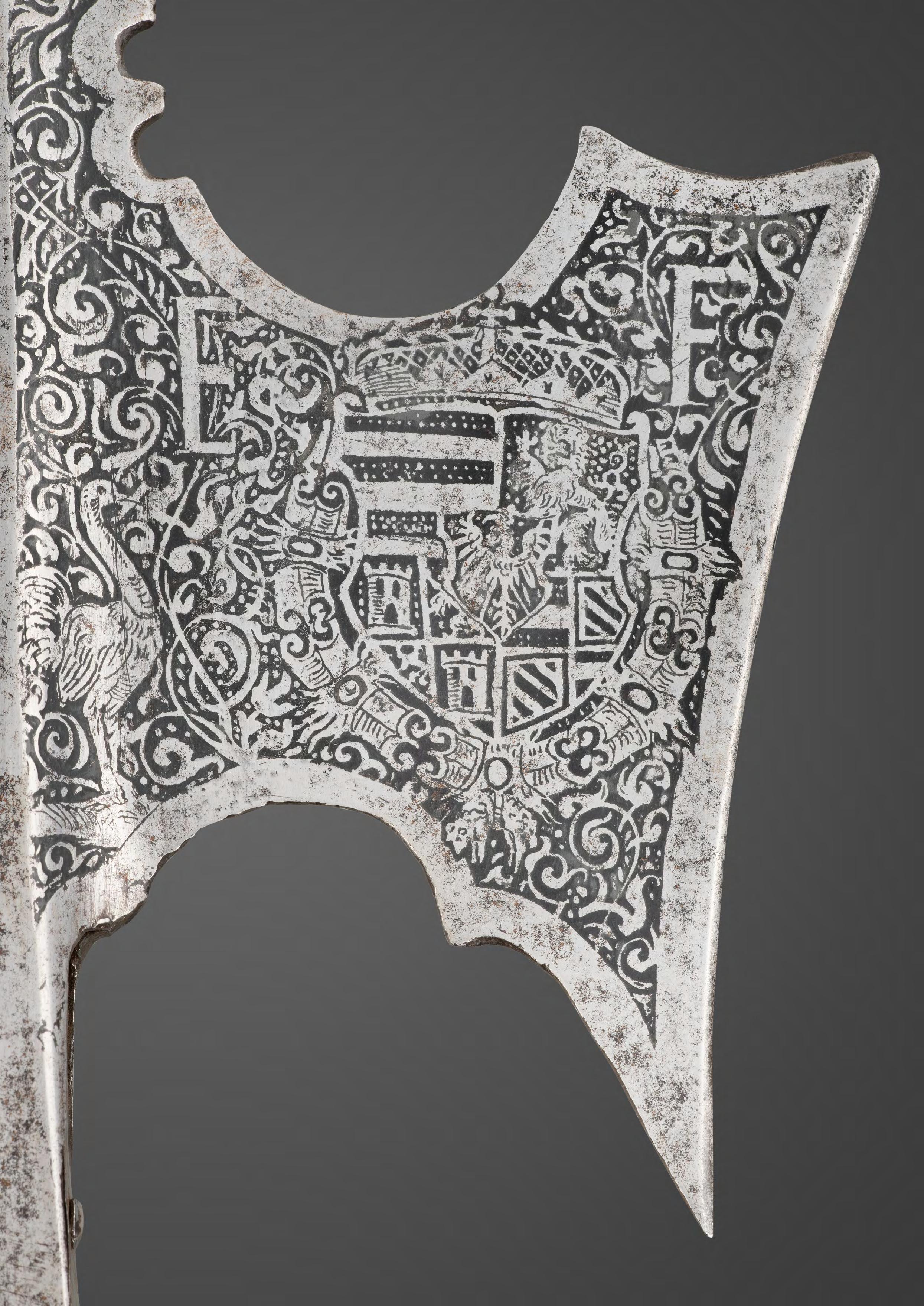
A series of five etched military spears dated 1558 and probably carried by the Hartschieren-Leibgarde element of Ferdinand’s personal troops, are preserved in the Leibrüstkammer, Vienna (A 715, A 720, A 724, A 969, A 973). In common with the present halberd, the etching on these spears includes ragged staves of St. Andrew crossed in saltire, together with fire-steels, displayed in affirmation of Ferdinand’s hereditary title of Duke of Burgundy.
Unlike the present halberd, the spears were adopted probably for the occasion of Ferdinand’s coronation as emperor, and are therefore etched with the eagle of the empire, together with Ferdinand’s cypher, now given as K F (for Kaiser Ferdinand) and together with the imperial crown of the Habsburg emperors.
Similarly, the two related series of etched state halberds in the Vienna City Arsenal, dated 1558 and 1563 respectively, bear the revised quartering of arms reflecting Ferdinand as emperor, contrasting with his arms as Archduke of Austria.
By 1550-55 Archduke Ferdinand had taken on the full mantle of Charles V’s imperial duties, having for more than three decades ably served and supported the emperor, both as a visionary statesman and strategic planner in the imperial Diet (parliament), and as president of the Reichsregiment (Imperial Governmental Council). With Charles’s abdication in the following year Ferdinand assumed his greater role, but was not crowned as Holy Roman Emperor until 1558.
Ferdinand’s achievements as archduke and emperor were of the highest significance in achieving lasting strength and security throughout the Austrian domains, and throughout the empire as a whole. In 1529 he had thwarted the Ottoman assault on Vienna, further engaging with the Turks militarily in 1532 and 1541, before settling the conflict with the peace of 1568.
As importantly, Ferdinand brought to an end the bloody religious conflict which had arisen throughout the German lands as a result of the Lutheran Reformation. He also subdued war in Hungary and unrest within the nobility of the Austrian Lands themselves, and established new governmental structures for a lasting good.
A Fine Glaive Made for the Guard of the Holy Roman Emperor Maximilian II dated 1564
Germany. Steel and wood 250 cm / 98.5 in (overall length)
PROVENANCE
The armouries of the guard of Emperor Maximilian II, the Hofburg,Vienna Private collection, America
Hafted weapons such as this glaive developed from the undecorated types used on medieval battlefields. With the heads formed as massive knifelike blades, these weapons and their likely effect leave little to the imagination. The glaive became the traditional arm carried by the personal guard of the ruling Habsburgs, a select body of troops equipped both practically and elegantly, their glaives etched with the personal insignia of the successive sixteenthcentury emperors with whose protection they were charged. The present glaive illustrates perfectly the high level of artistry and technical finesse achieved in the etching of its decoration and insignia.
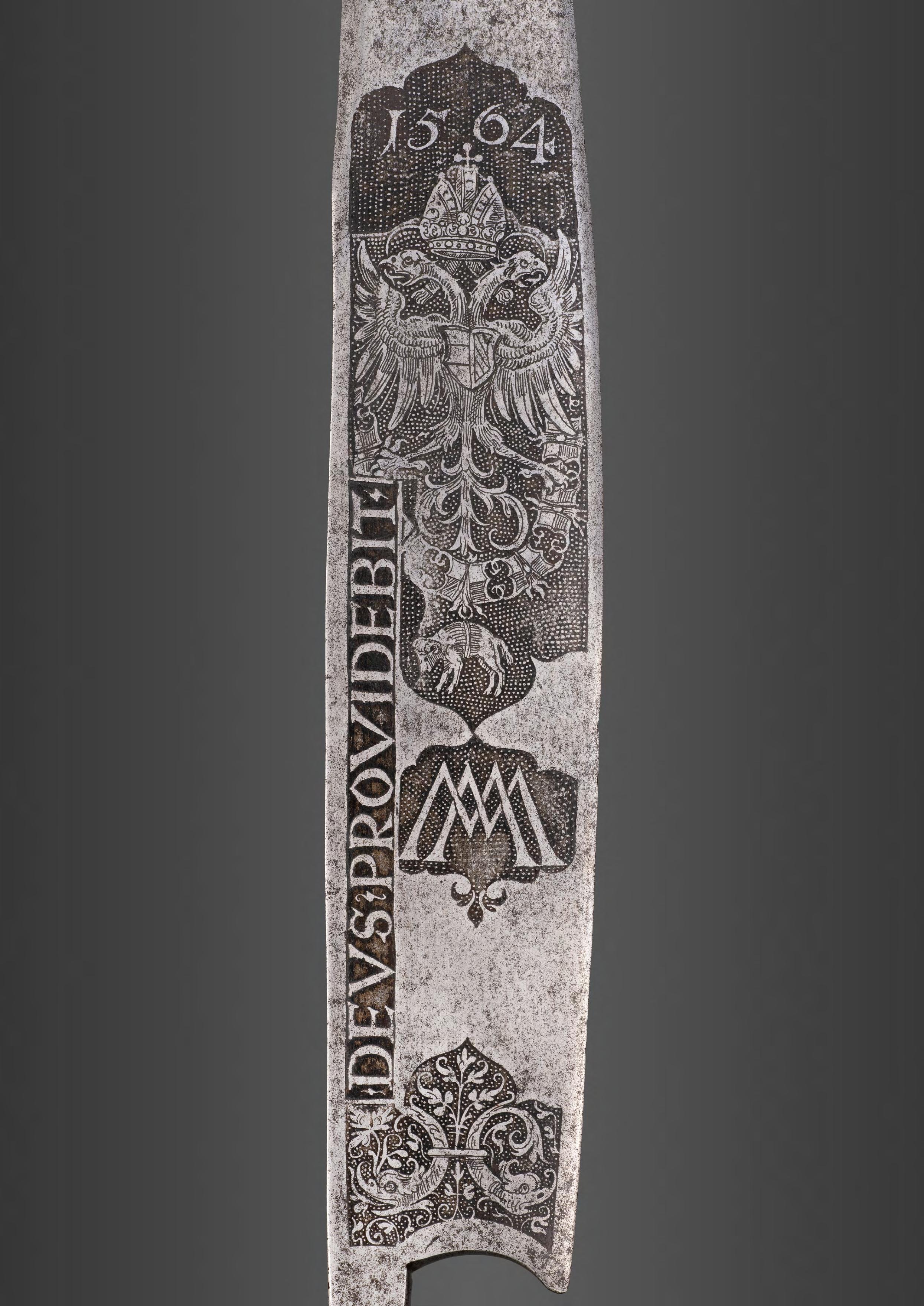
The Holy Roman Emperor Maximilian II of Austria (1527–76) was the son of Emperor Ferdinand I and the nephew of the Emperor Charles V. The archduke was crowned king of Bohemia in September 1562, king of Germany (king of the Romans) in November 1562 and king of Hungary and Croatia in 1563 before becoming emperor upon his father’s death in July, 1564. Maximilian married his cousin, the Archduchess Maria of Austria, Regent of Spain (1528–1603) and the marriage produced sixteen children.
The entwined monogram MM etched on the head of this glaive signifies the names Maximilian and Maria. The head is finely etched on both sides with a panel bearing this monogram. Above it on one side, the imperial double-eagle supports an escutcheon bearing the arms of Austria impaled with those of ancient Burgundy, surmounted by the crown of the Holy Roman Emperor (the armorial attributes of the Duchy of Burgundy passed to the archducal house of Austria following the marriage of Maria, the daughter of Charles the Bold, duke of Burgundy, to Maximilian I in 1477). The eagle’s talons clutch the collar of the Order of the Golden Fleece below. The opposite side shows the armorial badges of the Duchy of Burgundy, namely the ragged cross of St Andrew ensigned with three fire-steels and surmounted by an emperor’s crown. A slender vertical panel along the lower edge carries the motto of Maximilian II:
‘DEUS PROVIDEBIT’ ‘GOD WILL PROVIDE’
The base of the head decorated on each face with a small scrollwork panel, involving an addorsed pair of marine monsters on one face and a single monster supporting an oval shield on the other. The etching contrasting in the white against a blackened etched stippled ground throughout, the leading face of the socket struck boldly with a maker’s mark (apparently unidentified), and the entire head preserved in exceptionally fine untouched condition.
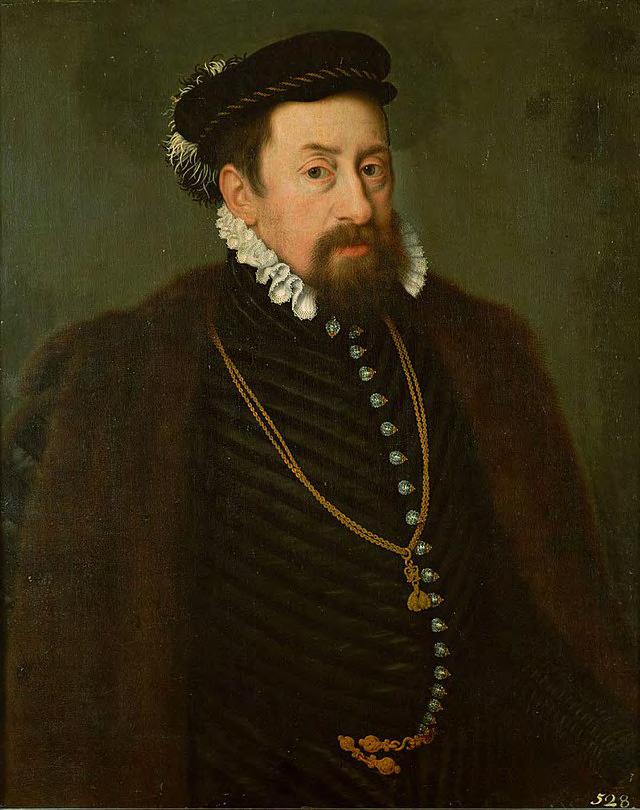
Emperor Maximilian II, about 1566.by Nicolas Neufchâtel (fl. 1539–1567)
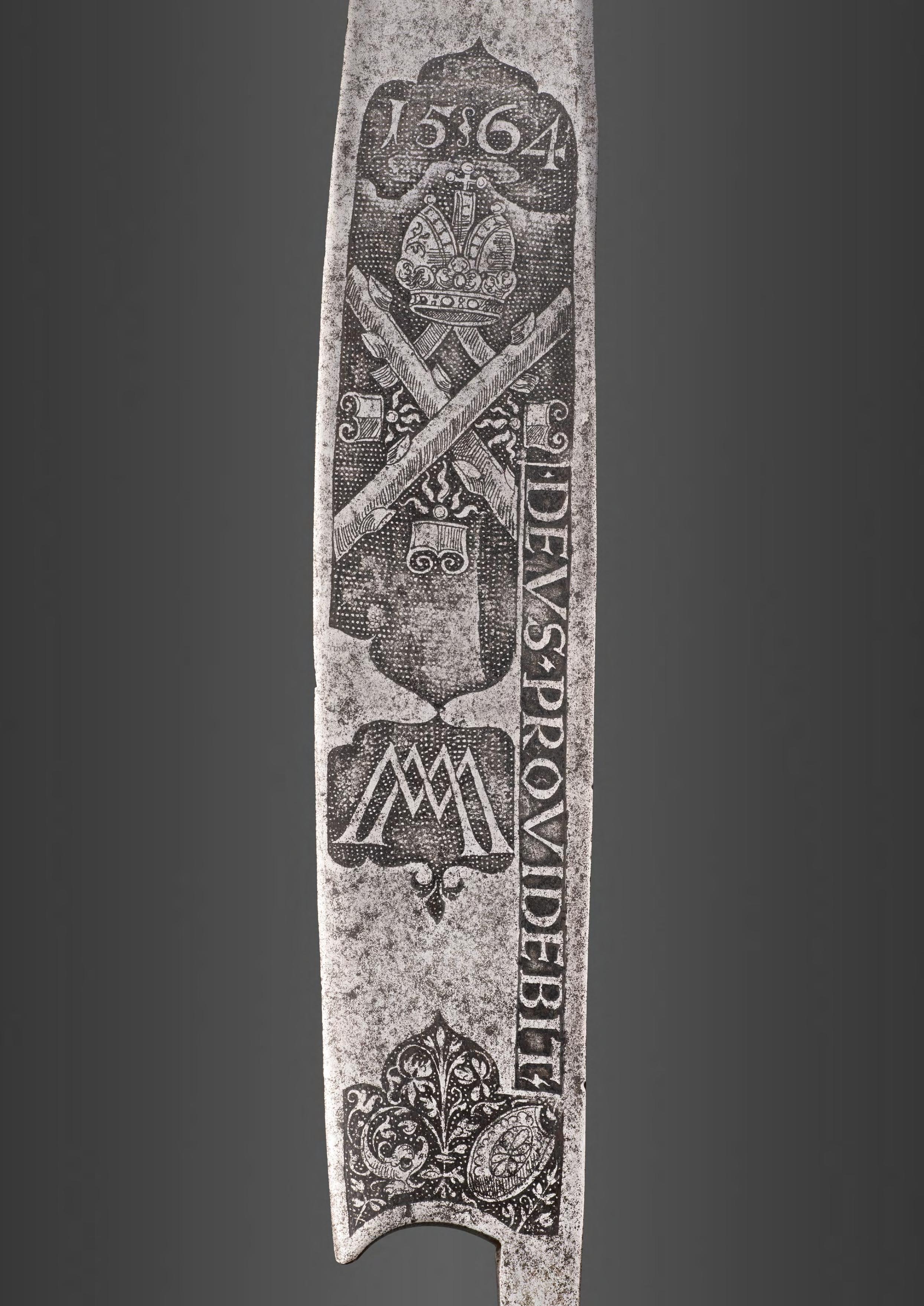
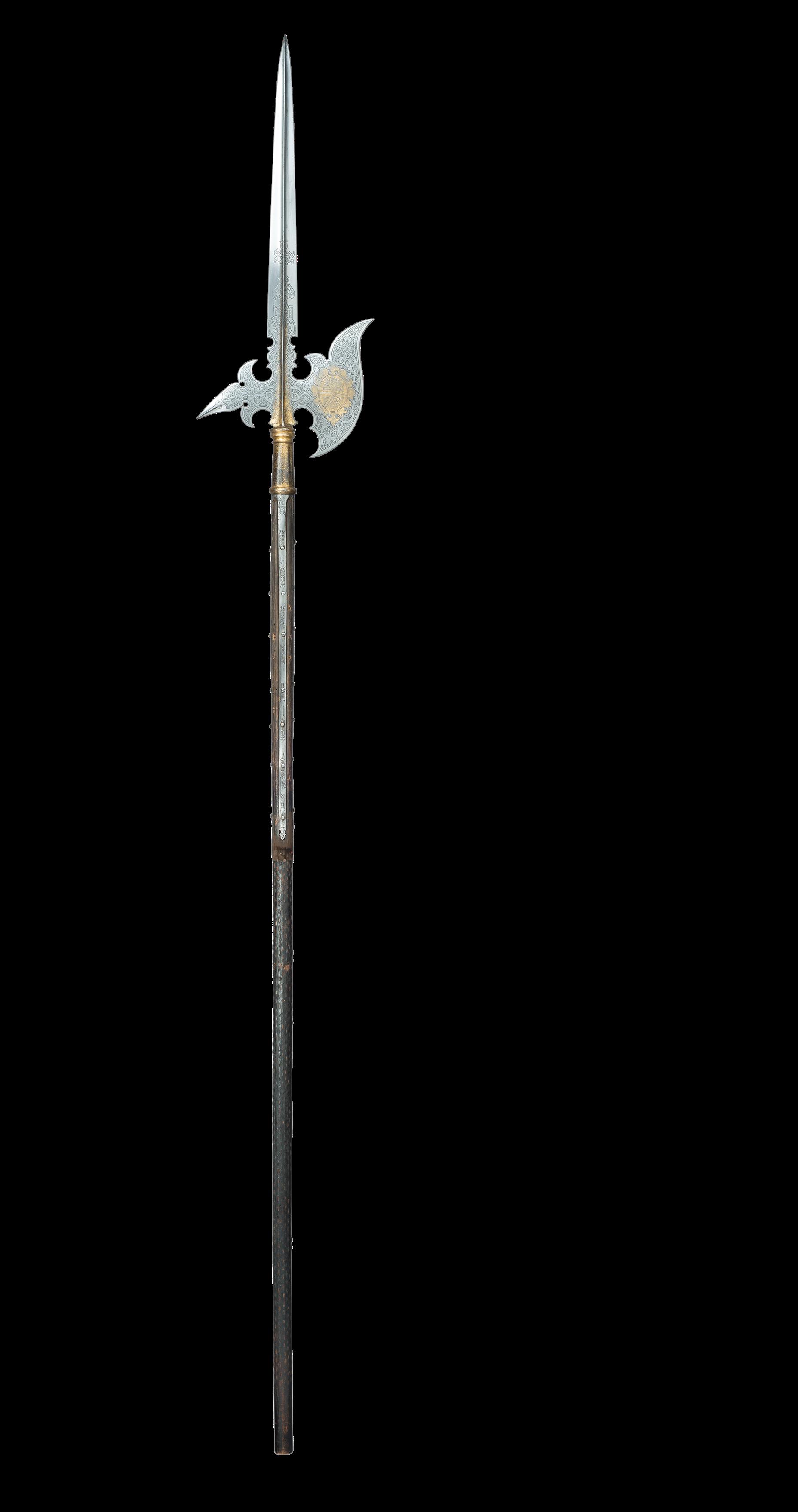
A State Parade Halberd of the Personal Bodyguard of Elector Christian II of Saxony c. 1600
Germany, Dresden. Steel, wood, silk 259 cm / 102 in (overall length)
PROVENANCE
The Saxon Electoral Armouries at Dresden Private collection, Europe Private collection, United States
Carried by the Trabantenleib Garde of the Saxon Elector Christian II (ruled 1601-1611). Christian II was just eight years old when he became Elector on the death of his father Christian I in 1591 but he did not actually rule until 1601. The oval cartouche depicts the Electoral Arms of Saxony on one side and the crossed swords of the Archmarshalship.

A State Parade Halberd of the Personal Bodyguard of Elector Christian II of Saxony c. 1600
Germany, Dresden. Steel, gold, wood 238 cm / 93.7 in (overall length)
PROVENANCE
The Saxon Electoral Armouries at Dresden Private collection, Europe Private collection, United States
Carried by the Trabantenleib Garde of the Saxon Elector Christian II (ruled 1601-1611). Christian II was just eight years old when he became Elector on the death of his father Christian I in 1591 but he did not actually rule until 1601. The oval cartouche depicts the Electoral Arms of Saxony on one side and the crossed swords of the Archmarshalship.
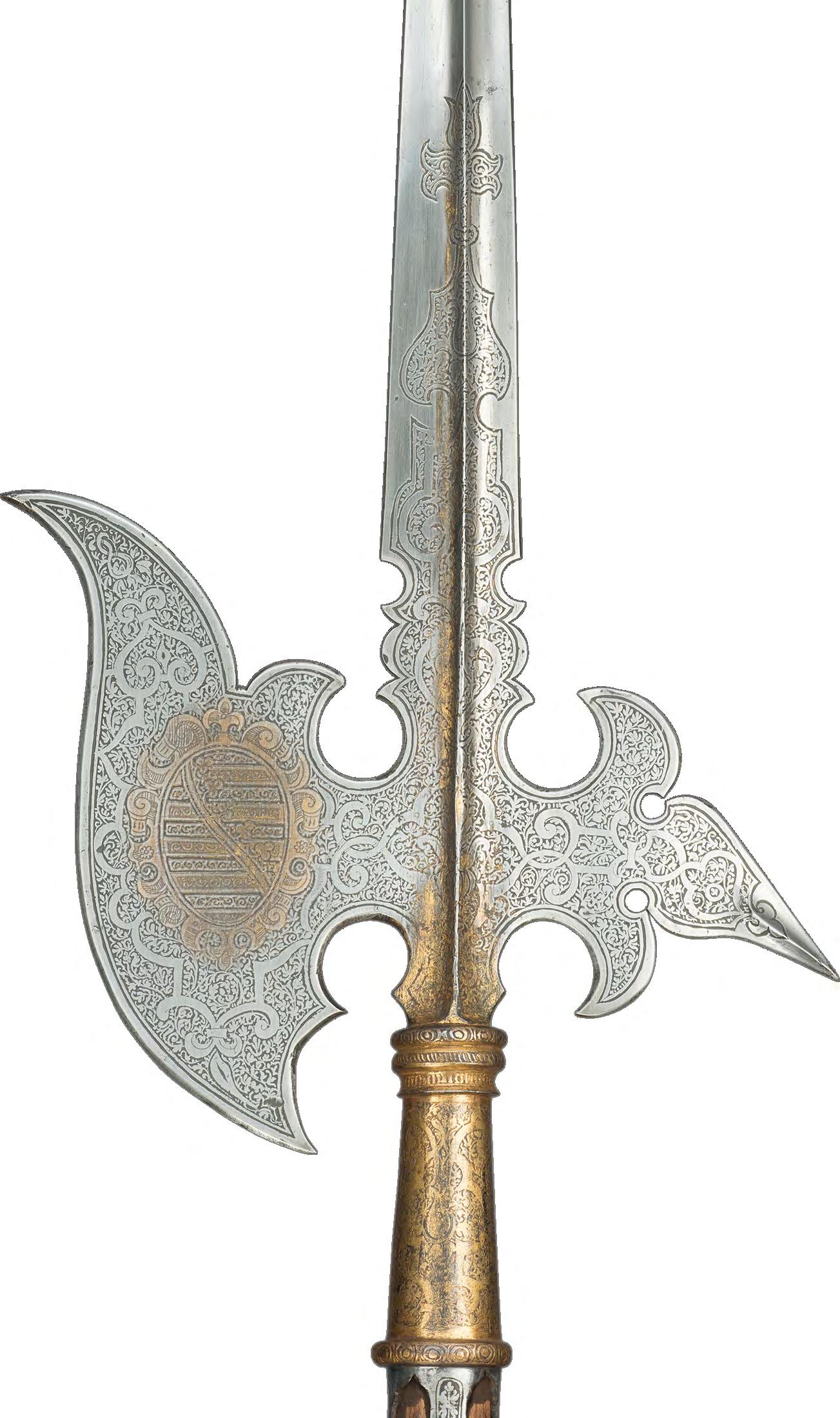

A
Superb Etched State Halberd of the Trabantenleibgarde of Prince Karl Eusebius von Liechtenstein dated 1632
Southern Germany, probably Augsburg Steel, gold, wood, textile 230 cm / 90.5 in (overall length)
PROVENANCE
The Princes von Liechtenstein, probably transferred in 1911 to the Princely Armoury, Schloss Vaduz
Four Liechtenstein state halberds of the series dated 1632 and carried by the guard of Fürst Karl Eusebius were sold in New York by the American Art Association, in the (then annonymous) Liechtenstein dispersal sales of November 1926 and November 1928. It is likely that the present halberd was sold either as lot 297 from the first catalogue, or as lot 236 in the latter auction.
Acquired by the collector Alfred Marsden Scott of New York, almost certainly purchased directly by him from the American Art Association. Subsequently included in the sale of a small group of antique arms from his estate, Sotheby’s, European Works of Art, Arms and Armour, Furniture and Tapestries, New York, January 9 and 10, 1990, lot 516 (the core of Scott’s collection of fine decorated staff weapons was sold by Parke-Bernet Galleries, November 1953).
Karl Eusebius von Liechtenstein (1611-84) succeeded as Hereditary Prince of the Holy Roman Empire (Fürst) in 1627, his father Prince Karl I having in 1608 been the first of the Liechtenstein line to have been raised to the Princely state. Prince Karl Eusebius was served by a household comprising a trabantenleibgarde (personal elite bodyguard) of fifty men, together with countless officials, servants, sons of the aristocracy, huntsmen and falconers.

In 1632 Karl Eusebius came of age, receiving the Duchies of Troppau and Jäjerndorf from his uncle, the regent Maximilian, together with the ‘Solemn Homage of the Liechtenstein Silesian estates’. A new series of guard halberds, of which the present example is one, was produced to mark the formal princely accession. The quartering of the coat-ofarms of Prince Karl Eusebius on the present halberd blade reflects his acquisition of these titles.
Enclosing the quartering of arms on the blade is the Collar of the Order of the Golden Fleece, one of the most prestigious of the chivalric orders, to which Karl I had been elected in 1622 and which passed to his son.
The new etched designs of 1632 and the refined quality of their finish display a marked level of improvement on the more traditional decoration of the previous series of Liechtenstein state halberds, which had been introduced for his father in about 1620.
It is most likely that this series of trabanten halberds were kept either at his baroque palace in Feldsberg, Lower Austria (now Czechia), or at his palace in Vienna. These, together with the vast firearms collection, fine decorated ordnance, ancestral armour and other weaponry were transferred to Schloss Vaduz in 1911.
Unlike his father, Karl Eusebius was not a dedicated servant of the emperor, holding the office of Royal Chief Governor of the Silesian Territories from 163941 only. He instead devoted his reign to the restoration of the Liechtenstein lands and possessions after the devastation of the Thirty Years War. In return for a significant war loan, the Emperor Leopold absolved Karl Eusebius of legal damages and debts totalling 1.7million guilders, incurred by his father, but this relief came only in 1665.
These financial burdens notwithstanding, Karl Eusebius pursued the acquisition of select paintings, bronzes, many other works of art, and added greatly to his father’s collection of luxurious firearms. In this manner, Prince Karl Eusabius was the founder of the magnificent Liechtenstein Princely Collections existing today. He was also applauded for his horse breeding and his published studies of architecture.
Noted for their quality, exceptional condition and provenance, the 1632 series of Liechtenstein halberds are considered by modern observers to be among the most desirable of all the 17th century hafted weapons intended for elite troops. A small number of retained examples line the walls of the principal state room at Schloss Vaduz. As a consequence of the 1920’s dispersal sales from the princely armouries, other examples are today held by the foremost museum collections, including The Metropolitan Museum of Art, New York (acc. no. 49.120.13), The Philadelphia Museum of Art (Kienbusch cat. no. 558), and The Art Institute of Chicago (acc. 1982.2351); almost none are in private ownership.
Schloss Vaduz, the modern seat of the Princely Liechtenstein family, had been acquired by them only in 1712. With the aim of securing a seat and vote at the Imperial assembly (Diet), Prince Johann Adam purchased the County of Vaduz and its castle from the Counts Hohenems-Vaduz for 290,000 guilders; that branch of the Hohenems line had never recovered from the economic damage of the Thirty Years War, but had instead acquired infamy for their illegal witch trials and executions in the county as a means of creating income.


A State Glaive carried by the Personal Guard of The Emperor Leopold I dated 1666
Southern Germany or Austria. Steel, gold, wood 260 cm / 102.3 in (overall length)
Provenance
Private collection, Europe
In 1518, the penultimate year of Maximilian I’s reign as Holy Roman Emperor, the Imperial Court Directory records two separate bodies of troops forming the emperor’s elite lifeguard, that part of the court establishment responsible for ensuring the security of the emperor’s person. The first of these, 77 strong, is referred to as “Ainspennige alt undjung”, and the other, formed of 57 men, the “Trabanten zu ross und fuess”. The former translates as “Mercenary soldiers appointed for life, old and young”, and it was this part of the imperial Leibgarden which subsequently came to be re-titled the Hof-Leibgarde-Arcièren, referred to in short as the Hartschieren-Leibgarde (Court Archer Lifeguard; ‘arciere’ being a Germanised word derived from the Italian for archer). A reasonable assumption is that the original mercenary contingent in the service of the Habsburg court was in fact a body of foreign archers.
The official transition of this guard from ‘ainspennige’ to ‘arcièren’ is found in the Court Directory of the Archduke Ferdinand of Austria for 1527-8 (successor in 1556 to his brother The Emperor Charles V), in which these troops are referred to as being one and the same. It was prior to Ferdinand’s reign as Holy Roman Emperor that the fearsomely commanding medieval glaive (or kuse in German) became the identifying weapon of the Hartschieren-Leibgarde, distinct from the halberds carried by the foot element of the Habsburg Trabantenleibgarde; an example dated 1551, carried by Ferdinand’s archducal Archer Guard, is in The Wallace Collection, London (A938).
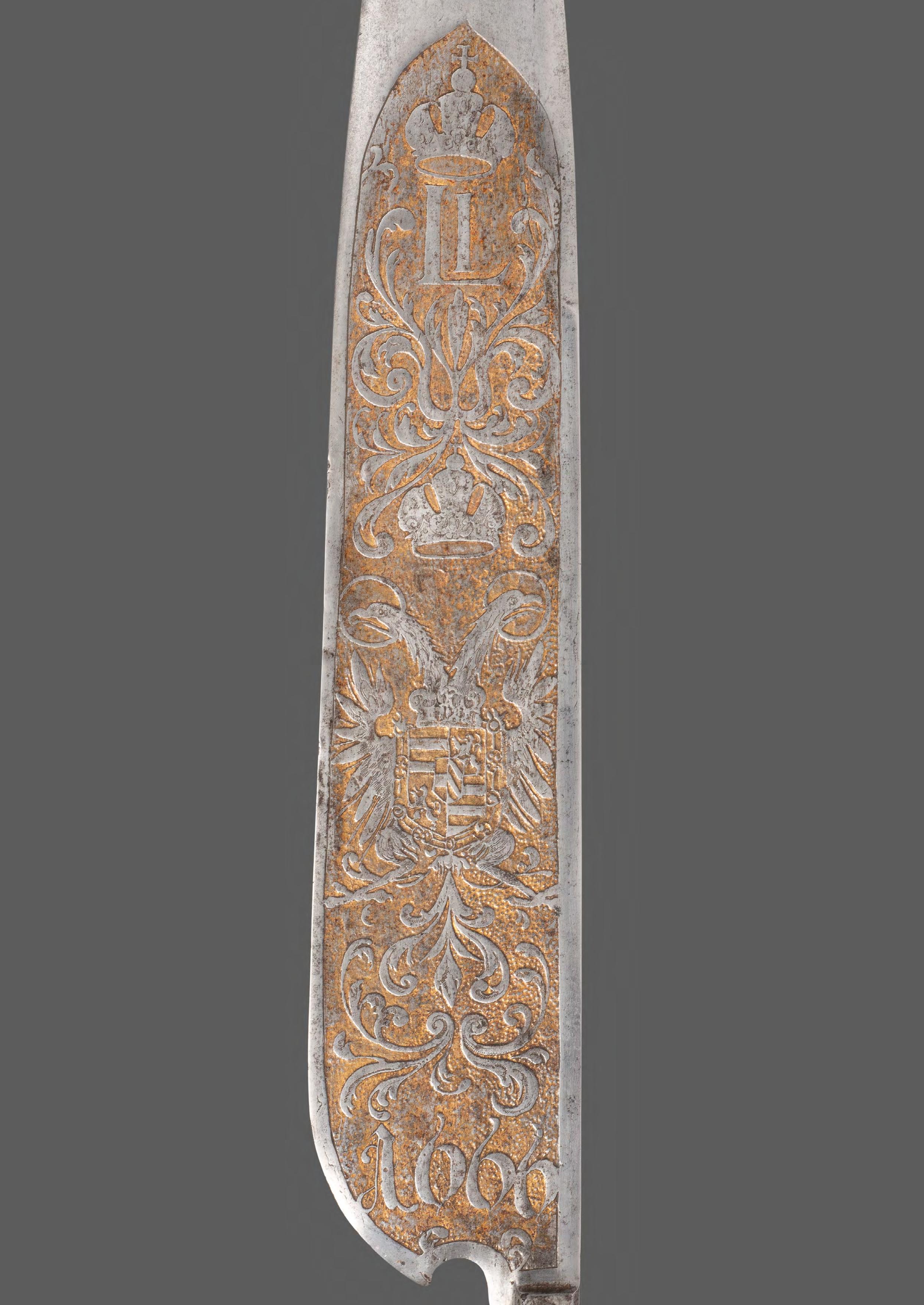
A further distinguishing feature separating the two units of the Habsburg Court Lifeguard was their recruitment. Whereas the Trabantenleibgarde was formed of soldiers of exemplary character and abilities, the Hartschieren were appointed exclusively from the ranks of the nobility throughout the empire.
Within Leopold’s reign (and prior to the introduction of a newly designed glaive in 1694) the Hartschieren-Leibgarde was commanded by a Hartschierenhauptmann, successively Leopold Wilhelm, Markgraf von Baden-Baden 1656-69; Franz August, Graf von Waldstein 1669-84; Franz Maximilian, Graf von Mansfeld 1684-90; and Ludwig, Graf von Colloredo-Waldsee 1690-94. In 1704, the final year of Leopold’s reign, the Archer Guard comprised 113 men.
A watercolour portrait entitled ‘Hartschier mit Kuse’ provides a fine vivid record of the sumptuous guard uniform in black, red and white, worn in 1578, following the accession of Ferdinand II as emperor. Painted by Lucas (I) van Valckenborch, this small-scale work is in the graphics collection of the Albertina Museum, Vienna (Inv. 13578). The work additionally records the Hartschier armed with both glaive (kuse) and rapier.
The date ‘1666’, included within the design etched on one side the present glaive, is the year in which Leopold I married the Infanta Margarita Teresa, his niece and the youngest daughter of King Philip IV of Spain. In keeping with his lifelong need to outdo his rival, Louis XIV of France, Leopold commanded that the court wedding ceremonial and its attendant festivities would have no parallel in their extravagance and expense; the re-arming of the Archer Guard to mark the occasion typified the increasingly elaborate nature of the Habsburg court under Leopold.
The broad knife-like head of the wedding glaive is decorated richly on both sides with an etched panel involving bold symmetrical designs of scrollwork against a gilt matted ground. The scrollwork is surmounted by the crowned cypher ‘L I’, for ‘Leopold Imperator’; on one side at the centre are the arms of Austria impaling Burgundy ancient, charged upon a crowned double-eagle and accompanied by the Collar of the Order of the Golden Fleece; the date ‘1666’ is etched prominently across the base. On the other side the Leopold cypher is repeated, beneath which a laurel oval frames the emperor’s personal device of the Eye of God-in-splendour, placed above an orb-like crowned sphere flanked by the Imperial Sword and Sceptre clasped in hands emerging from clouds.
Few Habsburg state glaives of this 1666 series have appeared on the art market. A significant number, however, are preserved in the historic Habsburg armoury, at Schloss Ambras, near Innsbruck, and in the former imperial collections in the Kunsthistorisches mueum, Vienna (Bruno Thomas, Jahrbuch der Kunsthistorischen Sammlungen in Wien, vol. LXV, p.63).
Another example from this series is in the Musée de l’Armée, Paris (K.136): see Mariaux, Le Musée de l’Armée, Armes & Armures Anciennes, vol.2, Paris 1927, pl. LXIII, fig. 3.
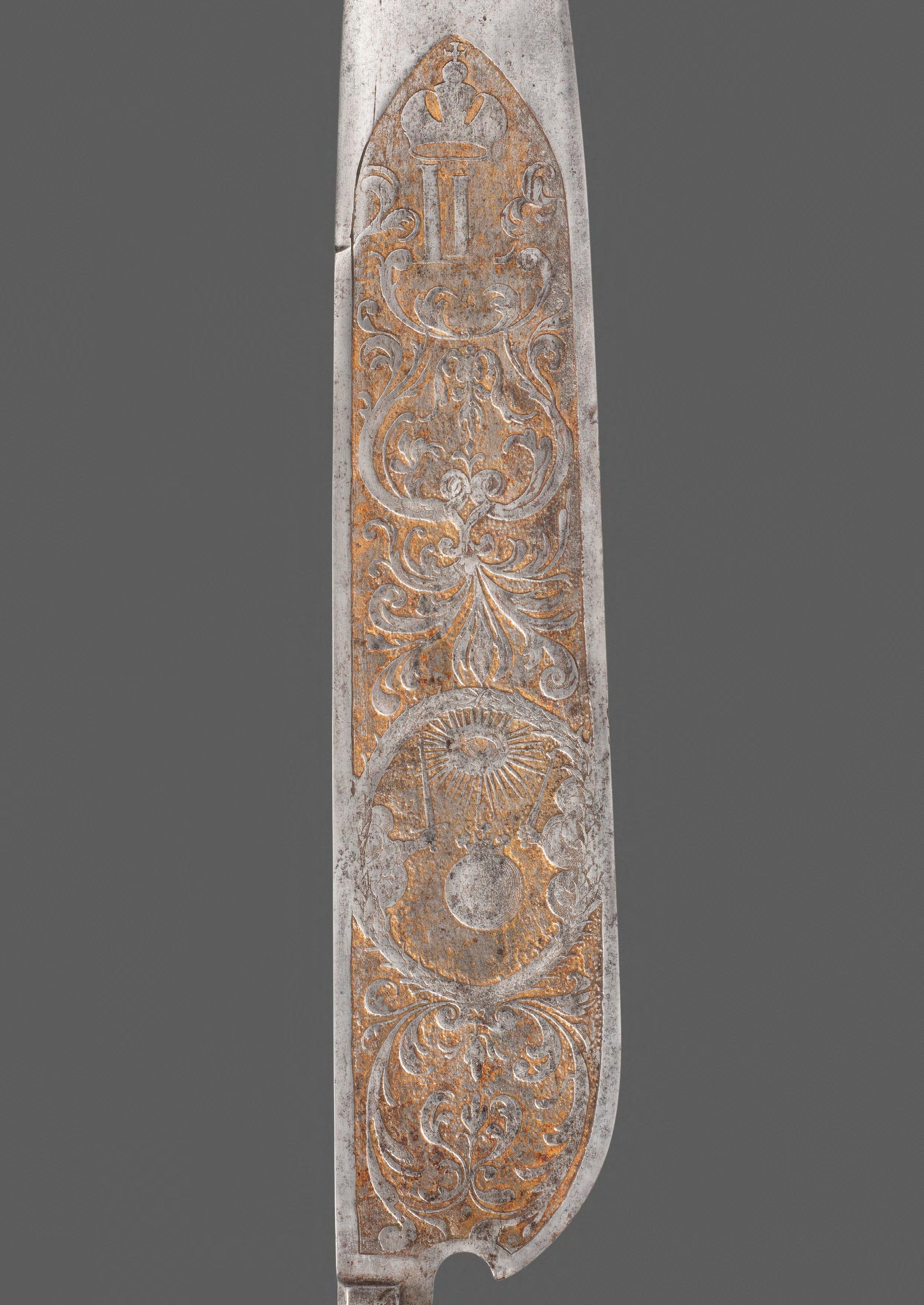
OTHER ITEMS

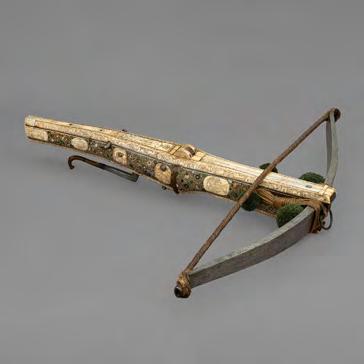

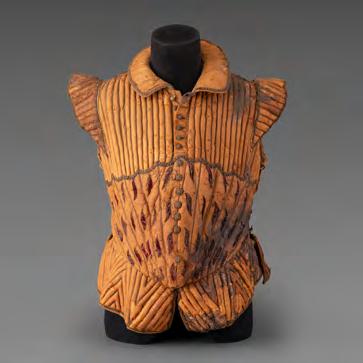

22 A Pair of Spanish Habsburg Knightly Stirrups 16th – 17th century
23 A Heavy Sporting Crossbow, or Ganze Rüstung late 16th century
24 Gerard Reynst (c. 1568 – 1615), 2nd Governor-General of the Dutch East Indies 1613
25 An Extremely Rare Peascod Doublet mid-late 16th Century
26 An Exceptionally Rare Pair of Buff Leather Gauntlets mid-17th century

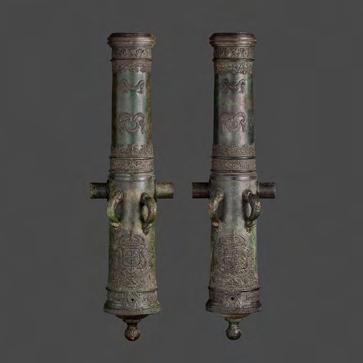
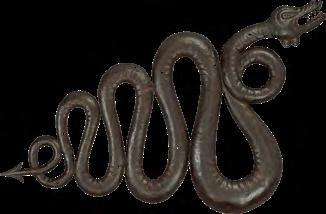


27 A Very Rare and Historic Bronze 6-Pdr ‘Drake’ Cast for the Rotterdam Admiralty by Cornelis Ouderogge, from the site of the Battle of Lowestoft fought on 13 th June 1665 dated 1658
28 An Historic Pair of Bronze Cannon Cast by the Spanish Gunfounder Mathias Solano, Dated 1747, In 1798 they were Given by King George III of England to Major General John Graves Simcoe
29 A Pair of Serpentine Appliques late 17th – 18 th century
30 A Magnificent and Rare Royal British or Hanoverian Huntsman’s Satchel c. 1714 – 27
31 A Large Masterpiece Chest or Door Lock c. 1720
A Pair of Spanish Habsburg Knightly Stirrups
16th – 17th century
Spain, probably Toledo. Steel
14 cm × 12 cm / 5.5 in × 4.7 in
PROVENANCE
Private collection, United Kingdom
Amasterpiece of Spanish ironwork, these stirrups have the notably wide side-panels and broad treads inherited from the stirrups of the early Spanish light cavalry, known as jinetes, who rode with very short leathers and bent knees, controlling their horses by the grip of their thighs on the saddle, in turn an inheritance from the Arab presence in Spain (jinetes, from the Berber tribal horsemen, zenata). The jinetes formed an essential fast skirmishing element of Spanish armies throughout the medieval Reconquista period. Their continued deployment in the 16th century Italian campaigns reinforced their traditions and prestige in Spanish society, with the consequence that by the early decades of the 17th century the uniquely agile riding style of the jinetes had expanded to include a variety of fast-paced equestrian sports and mock combats. Their martial riding exercises and related sports are well-illustrated in a series of engravings by María Eugenia de Beer, in Gregorio Tapia y Salcedo, Exercicios de la gineta, published by Diego Diaz, Madrid, 1643.
The elaborate character of this pair of stirrups compares very closely with another Spanish pair, albeit slightly less ornate, in The Metropolitan Museum of Art, New York (acc. 14.25.1757). The latter pair were formerly in the collection of the Zuloaga family, the foremost Spanish iron chisellers and damasceners of their age.

Of further interest within the MMA collection, a pair of 19th century Chilean bronze stirrups reveal a visible path in Spanish colonial culture leading directly from the style represented by these two earlier examples now under discussion (MMA, acc. 42.50.454/5).
In terms of their decorative characteristics, however, the present stirrups and those in the MMA first cited, each display a predominant and obvious evolution from Germanic cultural influence. This came about by political and trading contact with Spain under the rule of The Holy Roman Emperor, Charles V, who reigned additionally as King of Spain, 1516-56. The elegant fluting and fretwork of the side panels has its origin in the German ‘High Gothic’ fashion in plate armour, which achieved a striking peak at the Habsburg Court, circa 1480-90. The design of its corresponding equestrian equipment naturally took its direction from the armour with which it was used and from the mode of the imperial court.
This stylistic vogue was succeeded throughout the German sphere by the so-called ‘Maximilian’ period of 1500-1530. The development took its name (in modern studies) from the Holy Roman Emperor Maximilian I (d. 1519), under whose enthusiastic patronage fine and more rounded forms of armour relied on light shimmering on gracefully fluted surfaces. A Germanic progression away from fluted armour after about 1530-40 did not, however, bring blanket change to the established style of stirrup design for luxurious field use; a pair of German fluted stirrups of circa 1600-1630, in The Wallace Collection, London, exemplifies the point (A 436-7).
Charles V was succeeded on the Spanish throne by his son, who ruled the Spanish line of the Habsburg dynasty as Philip II of Spain until 1598. The prestigious knightly equestrian arts flourished within the financial, cultural and military ‘golden age’ enjoyed under Philip’s reign, to prosper further in its reputation into the 17th century and enduring to modern times.
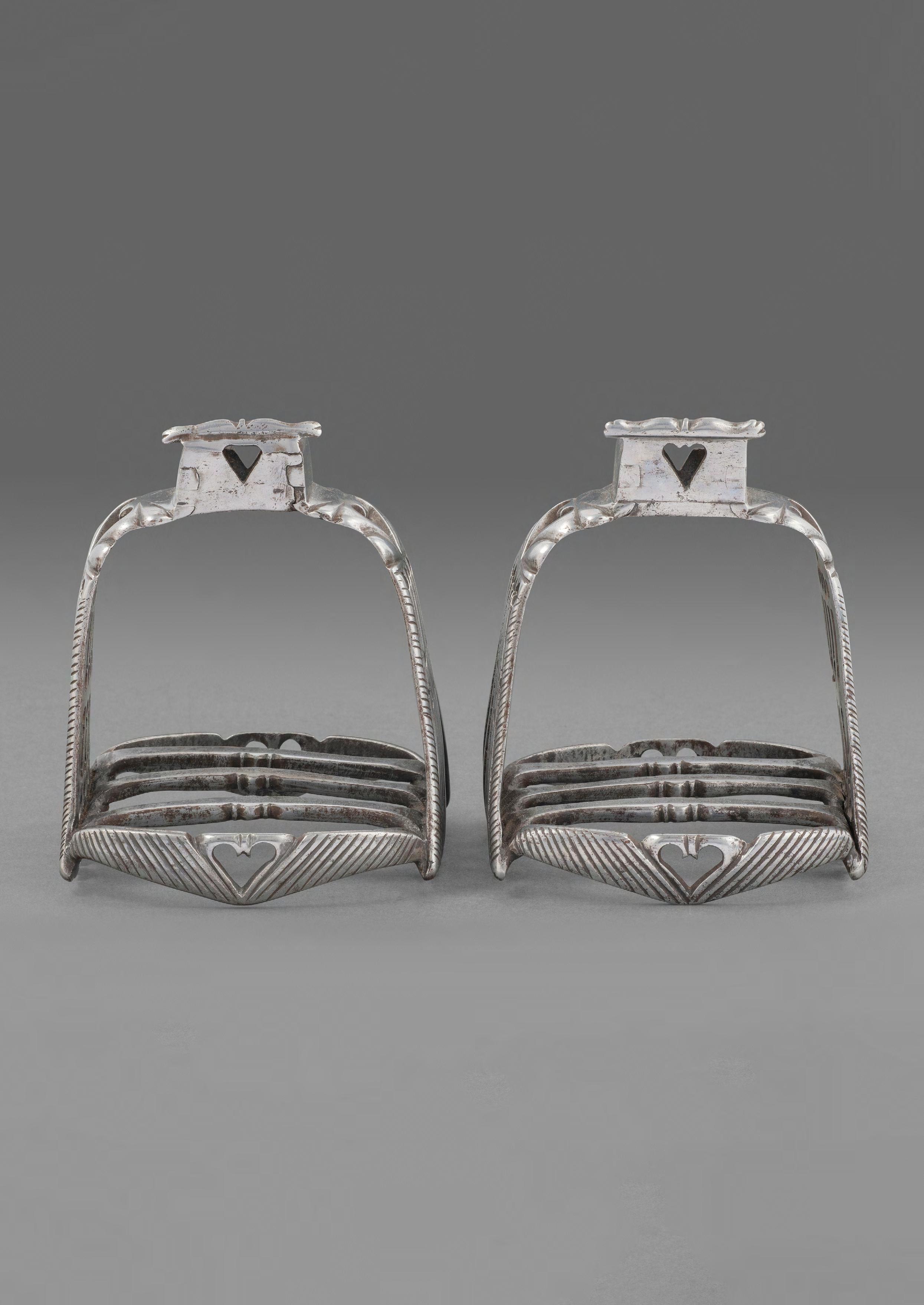
A Heavy Sporting Crossbow, or Ganze Rüstung late 16th century
Central Europe, probably the eastern German states of Saxony or Thuringia Steel. Wood, staghorn, bone, corded hemp, and wool.
75 cm × 84 cm / 29.5 in × 33 in
Provenance
Private collection, United Kingdom
The abounding imagery displayed in the decoration of this crossbow is that of romantic love, fertility and good fortune, the ingredients of a lasting marriage. Themes such as these naturally point to this bow having been made specifically as a prestigious wedding gift, the giving of luxurious weaponry to mark such a celebratory occasion not unusual in the 16th century among the landed classes within the German orbit. The marriage theme is furthered by the inclusion of two coats-of-arms, almost certainly those of the two families involved in the union, together with male and female bust portraits, the figures presented as though dressed for a wedding, very much in the finery of the period.
The decoration of the stock (or tiller) closely follows the elaborate style in which the stocks of pistols, long guns and their matching powder-flasks were fashionably decorated between circa 1580-1600, notably among the gunmakers of Saxony and Thuringia. The taste for this very close-set inlaid interlace of tightly spiralling ballflower tendrils spread eastwards also to neighbouring Bohemia and Silesia, where it remained an element of the stocking of crossbows and firearms as late as the early 18th century.
In the instance of the present crossbow, the field of horn ballflower spirals covers very nearly the entire surface of the wooden core over both sides. The pattern is enriched by the interspersal of greenstained larger ballflowers and set between cabled horn subsidiary borders.
The inlaid fields over the flanks additionally carry within them a series of finely engraved horn plaques. Among these on respective sides are the mantled and crested coats-of-arms of two families, male and female portrait busts, and on the right-hand side at the rear the female personification of Ceres, Roman Goddess of Fertility and Motherhood.
The upper surface of the stock and its corresponding underside are each veneered over their entire length in white staghorn. The central panels are framed over their length by engraved border panels of rollwerk scrolls, inhabited by grotesque male and female profile masks along the upper surface, and interspersed with leafy clusters of figs along the underside, again all typically found within the gunstocker’s repertoire of the period. The upper veneer is additionally decorated with an engraved inner border of running acanthus, framing behind the bowstring release an exotic male half-figure, perhaps as an allegory of Male Potency.
The underside is engraved with the female personification of Fortuna, Roman Goddess of Good Fortune. Towards the trigger-mechanism, an elaborate leafy arrangement of ripening figs is pierced at its centre by the aperture for the rod inserted to set the mechanism, while at the rear an amorous couple, less formally clothed, embrace above a heart-shaped emblem at their feet. The stock is capped by a staghorn terminal engraved with a further arrangement of figs. The abundant use of this fruit in the decoration of the stock serves as an appropriate background to the allusions to marriage which exist throughout. Figs are of course a
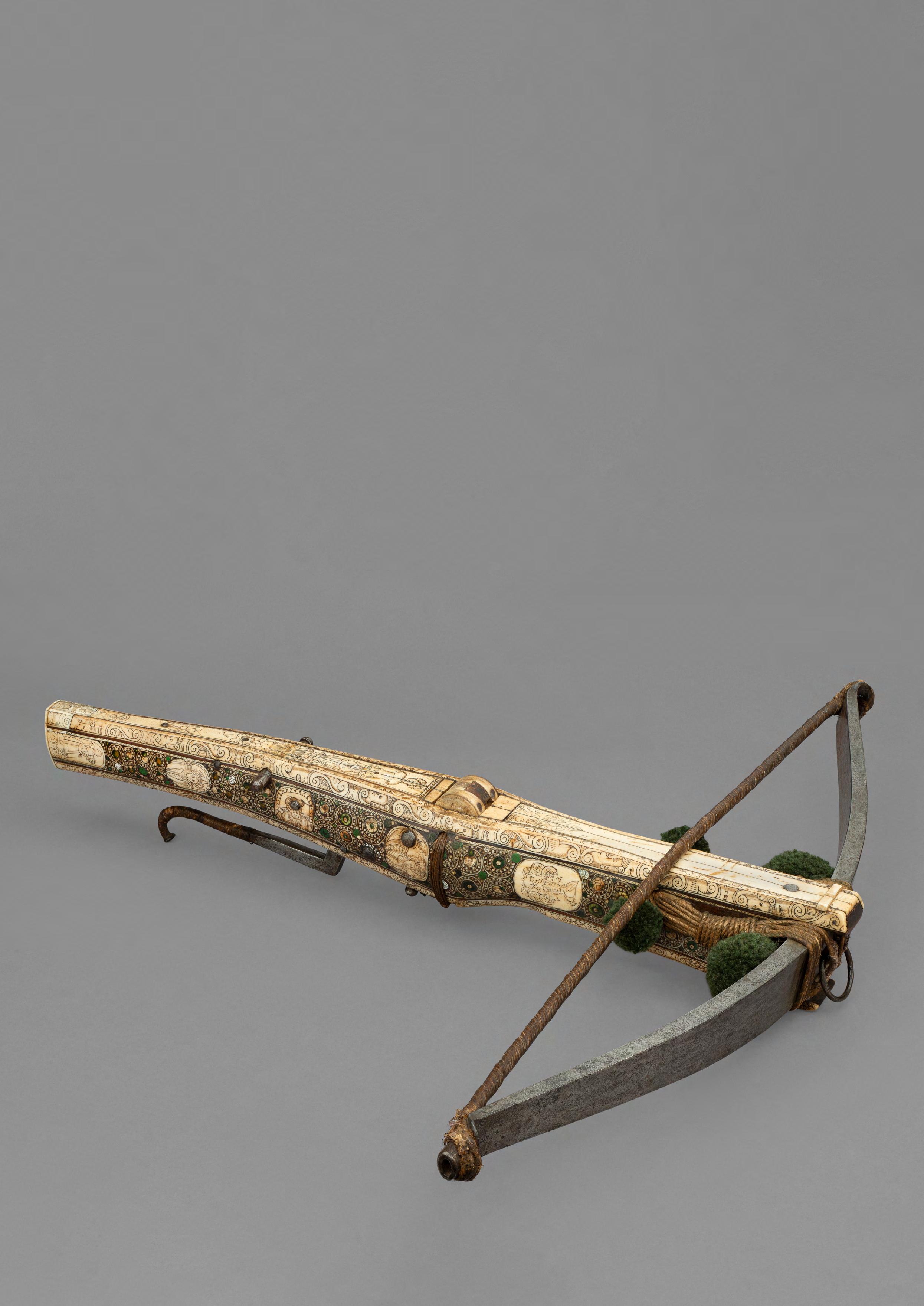
classical and renaissance symbol of Female Fertility, and are an attribute both of the Goddess Venus and of Bacchus, God of Wine, Merriment and Physical Excess.
The coats-of-arms have previously been ascribed to two families of the Bohemian minor nobility. Regrettably it would appear that the suggested identifications are incorrect. Nonetheless there is no doubt from their costume that the figures represented in the inlaid bust portraits are those of persons of Burgher or noble rank, most likely from the Bohemian or eastern German regions.
The large proportions of this crossbow categorise it under the German term Ganze Rüstung (‘full-size equipment’). These heavy bows had their origin in warfare. Their use in hunting in the late 16th century was restricted by their weight to the pursuit of boar and stags driven towards the sportsmen in prepared enclosures. By this period of crossbow development, the earlier long angular trigger had become merely

a guard for a small trigger, its mechanism set by the insertion of rods or prickers carried separately. In this instance, again characteristic of the period, the trigger folds to enable the cord loop of a spanning device, a cranequin, to fit over the rear half of the stock and engage with the pair of steel lugs projecting from the sides of the stock.
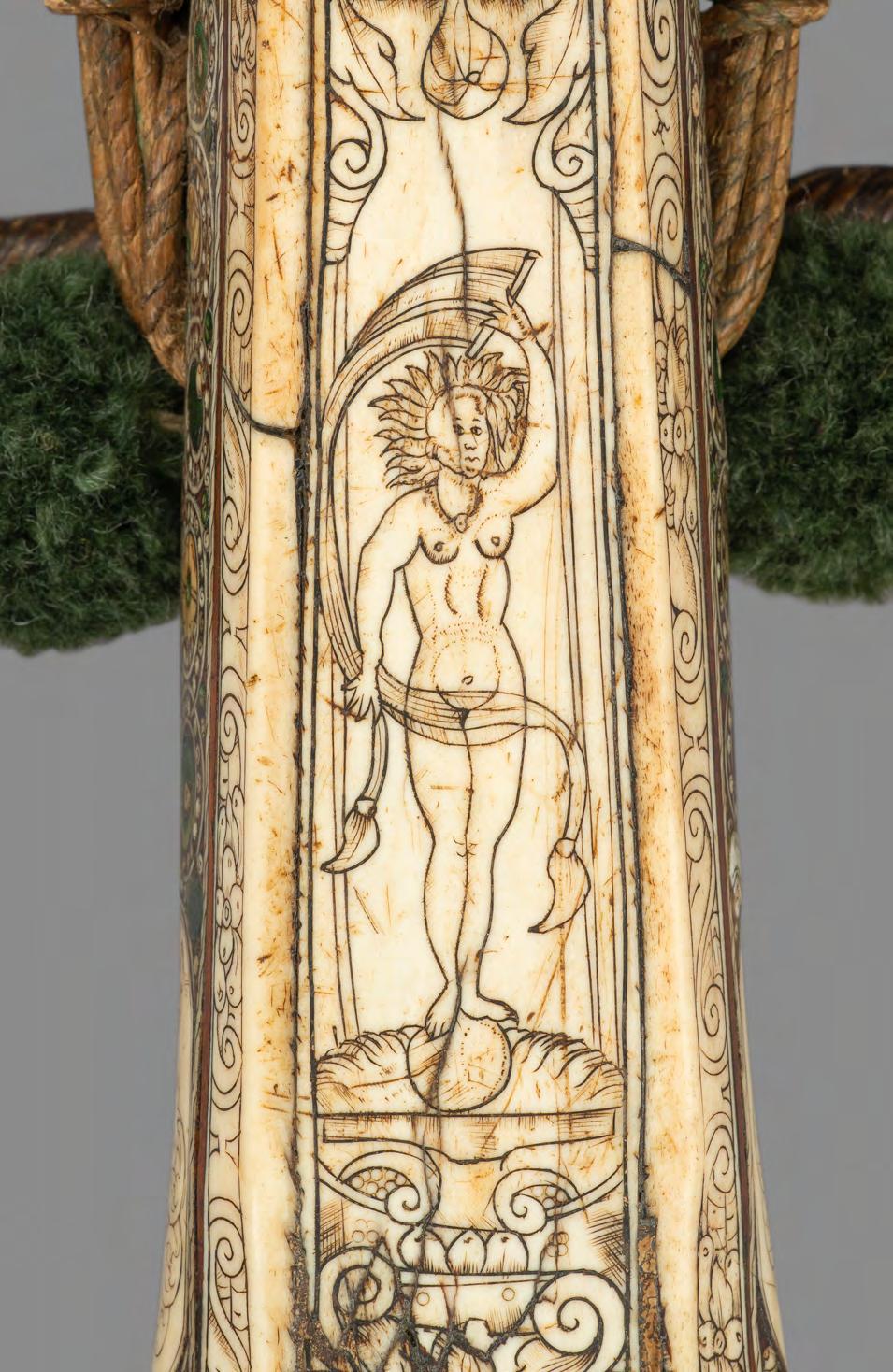
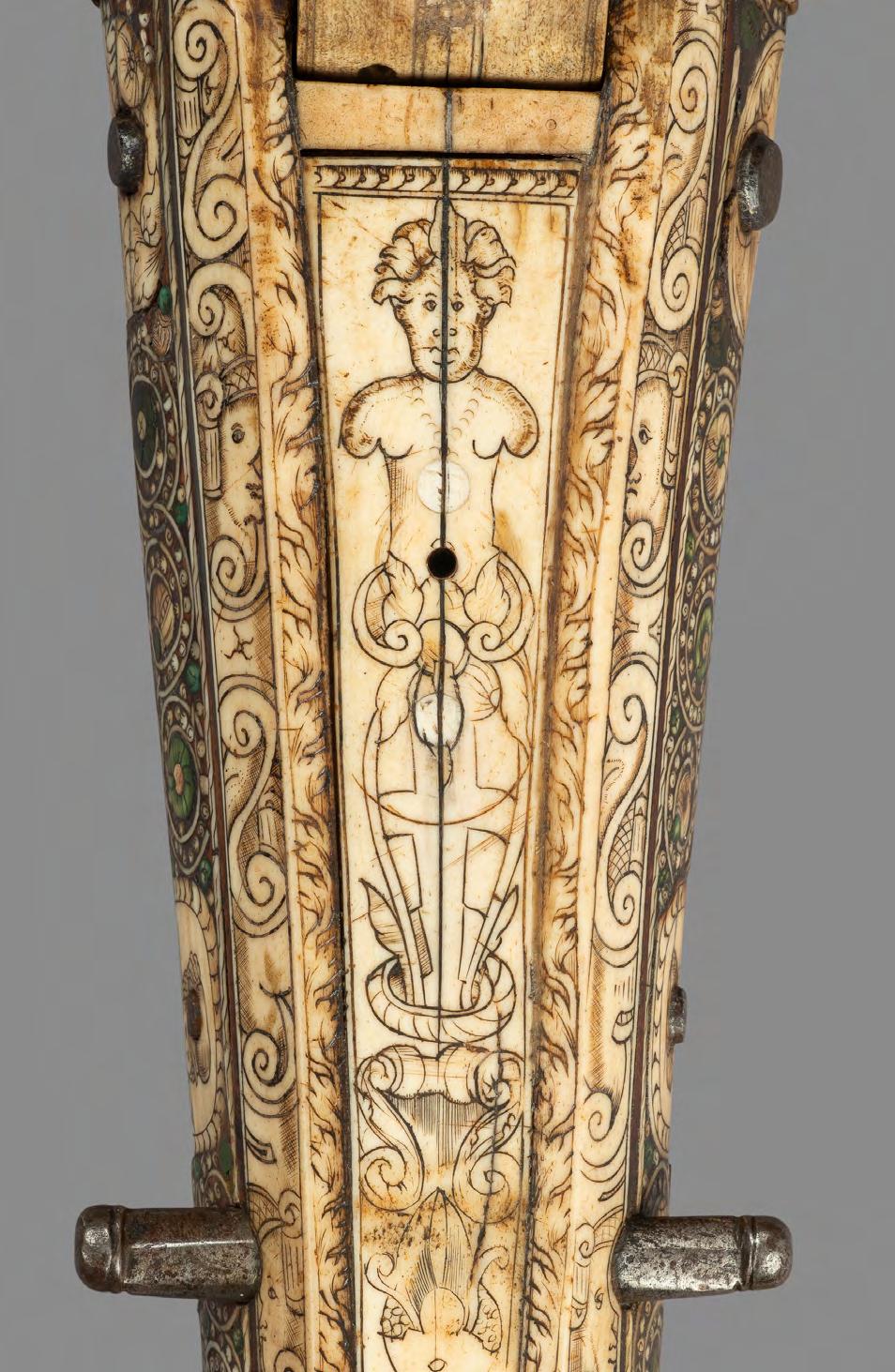
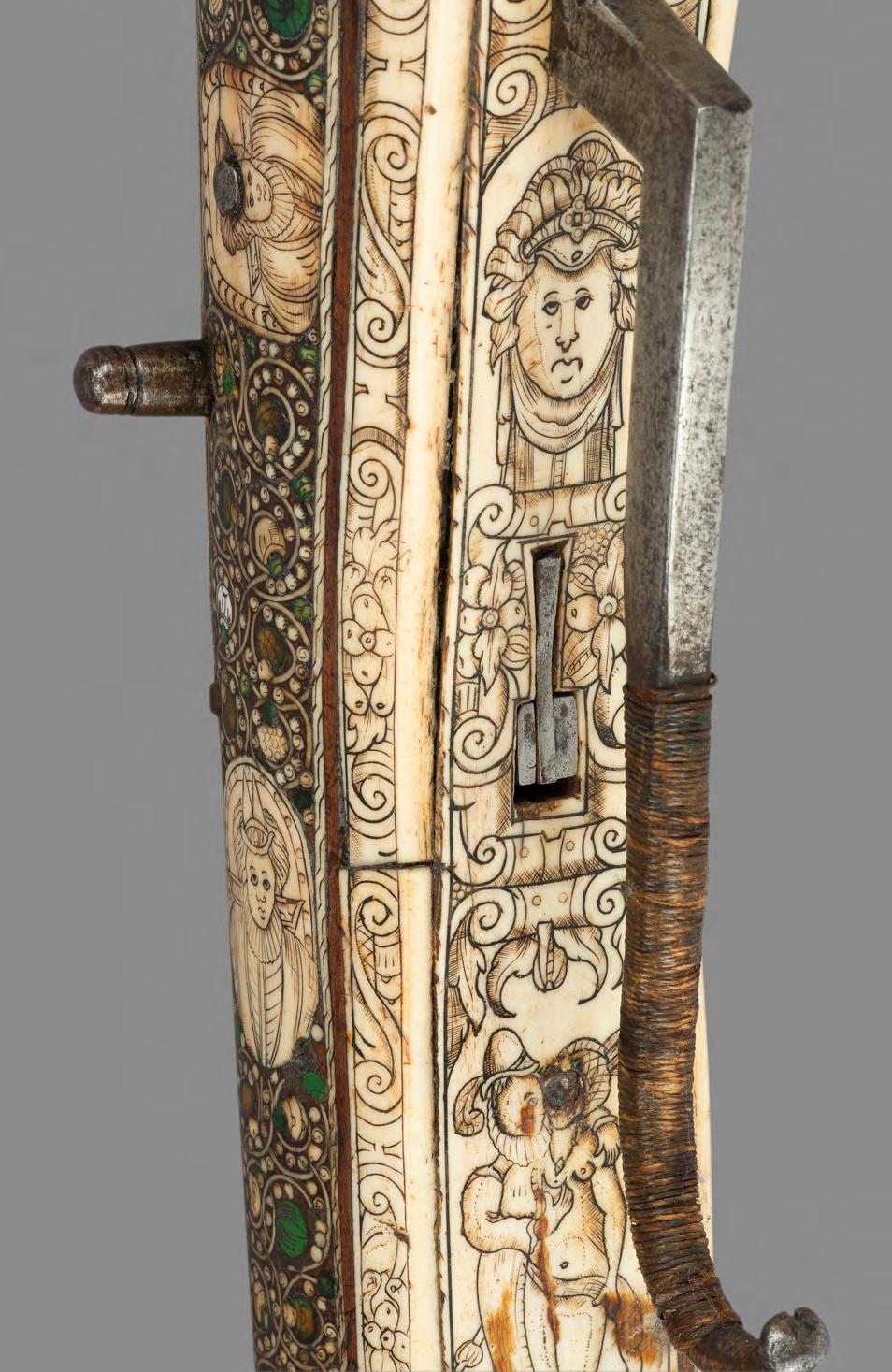

Gerard Reynst (c. 1568 – 1615), 2nd Governor-General of the Dutch East Indies 1613
Frans Badens (1571 – 1618), the Netherlands. Oil on canvas 194.5 cm × 119 cm / 76.5 in × 46.8 in
PROVENANCE
Presumably commissioned to commemorate the sitter’s appointment as Governor-General of the Dutch East Indies on 20 February 1613
Likely by descent to his daughter Wijntje Reynst (b.c.1600) and her husband Isaack Coymans (1581 – 1640), Amsterdam; transferred to his brother-in-law Samuel Bloemaert (1583 – 1651), Amsterdam; thence by descent to Joan Cornelis Reynst (c.1856 – 1942), The Hague; probably acquired by David Lindsay, 27th Earl of Crawford and 10th Earl of Balcarres (1871 – 1940), Balcarres House, Fife; to his son David Lindsay, 28th Earl of Crawford and 11th Earl of Balcarres, K.T., G.B.E. (1900 – 1975), Haigh Hall, Wigan; until his sale Christie’s London, 11 October 1946, lot 156 (as ‘Sustermans, Admiral Spinola’);
Captain A.C. Moller (of Furny’s, Antique Dealer), London; by whom sold at Christie’s London, 8 December 1961, lot 185 (as ‘Pourbus, Portrait of a Spanish Gentleman’); with Dent, London; Private collection, Verona.
Formerly in the prestigious collection of the Earls of Balcarres, where it was mistakenly identified as General Ambrogio Spinola by Justus Sustermans, this important and impressive full-length portrait, which has survived in an excellent state of preservation, is published here for the first time correctly identified and attributed. Our research has revealed that the sitter is actually Gerard Reynst (1568 – 1615), an influential and successful merchant from Amsterdam, who served as the second Governor-General of the Dutch East Indies, and that the artist is Frans Badens (1571 – 1618), arguably one of the most respected painters active in Amsterdam at the time, but now little-known.

The identification of the portrait, which was painted in 1613 in commemoration of the sitter’s appointment as Governor-General of the Dutch East Indies on 20 February of that year, is confirmed by an engraving and two poor quality bust-length copies, all three of which are today in the Rijksmuseum in Amsterdam (figs. 1 & 2). Though Reynst was from the merchant class, for this full-length Badens uses the international style of court portraiture previously created and developed in the 16th century for the portrayal of royalty and nobility by artists such as Anthonis Mor (c. 1516/21 – c.1576) and Frans Pourbus the Younger (1569 – 1622). Reynst is presented in a grand tiled marble hallway, beyond which is a large doorway leading into an airy room decorated with classically inspired renaissance pilasters, which may well represent the main chambers of East India House (‘Oost-Indisch Huis’) in Amsterdam. To the right of the sitter is a table covered with an elaborate Ispahan rug from the last quarter of the 16th century, on which sits an ornate helmet (cabasset) decorated with an engraved badge, likely depicting the mythological Roman soldier Marcus Curtius. Marcus Curtius was admired in the 17th century as the very model of a hero who dies for his fatherland. 3 Interestingly, there was a painting depicting Marcus Curtius by Frans Badens recorded in the collection of a Jean Rouyer of Amsterdam in 1702. A more ornate Italian cabasset, from c. 1575, depicting the same scene is in the Metropolitan Museum of Art in New York. Should the medallion indeed represent the heroic Curtius, one could parallel his sacrificial deed to the similarly courageous Reynst when he accepted the post of Governor-General of the Dutch East Indies in 1613; the very nature of the job, that of charting unknown, foreign lands and seas on the other side of the globe, exposed to bizarre and often fatal exotic diseases as well as indigenous peoples, was potentially a deathsentence to the post-holder. Indeed, Reynst’s term as Governor-General would be short-lived, for he died suddenly in Djakatra on 7 December 1615, after barely more than a year’s service. Another significant feature is the long gold chain worn by Reynst. To encourage Reynst to accept the position of GovernorGeneral of the Dutch East Indies, the Heren XVII (the seventeen delegates from the Seven Provinces who governed the VOC) – offered him the then substantial
monthly salary of 700 guilders and an annual sum of 1000 guilders ‘table money’. They also promised him the leadership of the Amsterdam Chamber on his return should he serve a full term of five years in the East Indies – which was not to include the time spent travelling. Upon his acceptance, the States of Holland presented him with a golden chain worth 1000 guilders and ‘a beautiful honorary medal of the same metal’. 4 The gold medallion is likely a remuneration medal, created by Coenraad Bloc in 1604, depicting the stadtholder Prince Maurice of Orange-Nassau, the figurehead of the United Provinces, and which would have been actively worn during diplomatic meetings with world leaders. Those in the Far East, like the Japanese Shogun, took hierarchy very seriously and would only deal with individuals who represented an appointed figurehead equal to them, which was normally the king in Western cultures. Although the VOC was inherently republican, they strategically misrepresented the stadtholder as the ‘king of Holland’ to enable an audience in Far Eastern courts.
Wearing this medal would have allowed Reynst to use Prince Maurice’s ‘distant presence to structure subsequent exchanges’. 5 Gerard Reynst (Gerrit Reijnst) was born c. 1568 to Pieter Reijnst (b.c.1510), a merchant in ashes for the soap industry. His father’s shop sign was illustrated with Drie Gieters (‘Three Watering Cans’), which would subsequently be incorporated into the Reynst family coat of arms. In 1588, he married in Haarlem Margaretha Nicquet (1566 – 1603). A decade later, by now a wealthy merchant and shipper who envisaged the great potential of global trade, Reynst co-founded the (New) Brabant Company, which grew into the United Company of Amsterdam (Vereenigde Compagnie van Amsterdam). In 1602, this company was consolidated with other city trade companies, forming the Dutch East India Company (Vereenigde Nederlandische Geotroyeerde Oostindische Compagnie), arguably the largest European trade conglomerate of its type at the time. In 1603, Margaretha died during childbirth, leaving Reynst to care for his nine children. He remained close to her brother Jacques (c.1571 –1642), for when Reynst left for the Far East in 1613, he gave him power of attorney over his estate, and
guardianship of his children. Two of Reynst’s sons, Gerard and Jan, went on to become passionate art collectors like their uncle. They famously built their own museum in Amsterdam composed of paintings imported from Venice in particular, where Jan Reynst and Jacques Nicquet were based as merchants. In 1660, Gerard Reynst II’s widow sold some of the best of the Italian paintings to the Dutch state, who then in turn gifted them to King Charles II to celebrate his restoration to the British throne.
Frans Badens was Flemish by birth, born in Antwerp in 1571 where he presumably served his apprenticeship. After a sojourn in Italy from c.1593 – 1596, he seems to have spent all his working life in Amsterdam where he died in 1618 aged only fortyseven years old. Amazingly, despite his apparent celebrity and success, Badens’ oeuvre is almost completely untraceable, with only a handful of works presently attributed to him. Our attribution is based on the evident stylistic match with his large group portrait depicting The Gunmen of the company of Captain Arent ten Grootenhuys and Lieutenant Jacob Floriszn Cloeck (Amsterdam Museum), from c. 1608 (fig.3). The luminescent colouring, glistening flesh tones and highly mannered pose of his sitters are the most noticeable original qualities shared by our portrait with the Amsterdam group. The most directly comparable figure to ours is the bearded figure to the extreme lower left of the group, with his right arm akimbo and hand propped on his hip. The way in which Badens has splayed the sitter’s fingers, with the thumb at a near right angle to the index finger and the middle fingers placed directly in parallel to one another, is exactly the same as our portrait. Furthermore, the hard shadowing pronouncing their facial features, the observed creasing of their wrinkles, the sharp edges of their lace ruffs and carefully drawn facial hairs all possess the same handling. Compositionally, both paintings have architectural elements within their backgrounds, each showing classicised buildings at sharp, perspectival angles.
Very possibly our portrait remained in the Reynst family until the early twentieth century, though there was an auction of some of the sitter’s goods, including fifteen paintings, sold to benefit his family
after his death. Frustratingly none of the lots possess descriptions be- yond the word schilderijtjes (‘paintings’), so it cannot be ascertained whether our portrait was sold at this time. However, on 8 July 1631, Isaac Coymans, one of Reynst’s son-in-laws, transferred most of his possessions to his brother-inlaw Samuel Blommaert for safe-keeping as he had been accused of embezzlement by the Church. One of the paintings listed was ‘t conterfeytsel van Gerard Reynst in zyn leven Generael in Oost Indyen in een vergulde lyst’ (‘The portrait of Gerard Reynst in his life[time] General in the East Indies in a gilded frame’). 8 Blommaert was also a son-in-law of Reynst, having married his daughter Catharina in 1612. He was a founding director of the Dutch West Indies Company in 1621, a company in which a Jacobus Reynst (1621 – 1667), a cousin of our line, served as an administrator. In 1905, the Dutch art historian Ernst Moes mentioned a portrait of Gerard Reynst that was in the collection of The Hague-based Reynsts, who were direct descendants of Jacobus Reynst.
An Extremely Rare Peascod Doublet
mid-late 16th Century
Probably France or England. Hide, probably doeskin, wool, velvet, silver-gilt thread
69 cm × 54 cm / 31.5 in × 20.8 in
PROVENANCE
Private collection, United Kingdom
Private collection, Verona.
EXHIBITED
Sotheby’s London, exhibition catalogue English Silver Treasures From The Kremlin, A Lone Exhibition, 1-28 January 1991, pp. 86-87, no. 57 (illustrated in colour)
Of fine hide, probably doeskin, padded with coarse sheep’s wool and intended to withstand light attack or to be worn with a peascod breast-plate, ribbed over the chest, shoulder-wings and collar, the back over the shoulders, the panel over the rear and the vented skirts all with chevroned ribbing, the central panels front and rear of converging ribs cut with slash-work lined in burgundy velvet, chainstitched overall in silver-gilt threads and edged with bullion gimp, fastening at the neck with six gilt filigree buttons (tarnished), and over the stomach with eight embroidered and bullion thread buttons (one missing), the sides with pairs of holes for later laces (old damage restored and conserved over time): on a modern torso covered in black fabric.
During previous conservation at the Royal School of Needlework, Hampton Court, the lining was analysed and found to be of coarse sheep’s wool in which many large dead fleas were discovered.
Cf. a related doublet with family provenance to the descendants of the Mutte de L’Espinette family, sold Thierry de Maigret, Drouot, Paris, 1 June 2018. See also another example formerly in the Bashford Dean Collection and now in the Metropolitan Museum of Art, New York, inv. no. 29.158.175

An Exceptionally Rare Pair of Buff Leather Gauntlets
mid-17th century
England. Leather
39 cm / 15.3 in (length of each glove)
PROVENANCE
Associated by tradition with Jacob Astley of Melton Constable, First Baron Astley of Reading, Sergeant Major General of the Foot for Charles I from Edgehill to Naseby (1579–1652)
The fashion for defences of buff leather has a relatively short vogue, in Britain and, to a lesser extent, in Europe in the middle decades of the seventeenth century (Dowen 2017). The most commonly encountered form of such defences is the buff coat, a doublet of buff leather often worn under a plate cuirass, mostly by cavalry. These harquebusier’s armours, for by this time almost all the cavalry in northwest Europe at least were using the short-barrelled carbine or harquebus as their principal weapon, were often accompanied by a single gauntlet for the left or bridle arm in addition to their open-faced helmet or pot. Most of the extant bridle gauntlets, which are themselves very poorly understood as they seldom if ever bear an identifying maker’s, guild or arsenal mark, are made of iron. However, a very few were made of buff leather, matching the buff coats.
The standard type of buff scaled gauntlet is for the left hand, the cuff extending over the elbow. This and a panel protecting the hand are covered with large buff leather scales. The type is typified by Royal Armouries no. III.4323, one donated to the Speed Art Museum, Louisville in 2004, both with gloves inside the square hand covering. One of these is from Barlborough Hall, associated with Sir Francis Rodes (c. 1598–1645, knighted 1641, Grose 1788, pl. 39 nos 5-6), subsequently in Bullock’s Liverpool
and London Museums (Bullock 1809, 75, 1812, 31) and the Meyrick Collection at Goodrich Court. A third example is in the Metropolitan Museum of Art, New York, no. 29.159.222, with a strap inside the palm and no glove, also from the Meyrick collection (Meyrick and Skelton II, pl. lxxix fig. 6, and this one seems to be illustrated in M. E. de Beaumont, ‘Armes méconnues’, Gazette de Beaux Arts, 1878, 9 alongside a redrawn version of the Barlborough Hall gauntlet after Grose but with the scales the wrong way round (p. 10). This one has. A fourth example is in the Royal Ontario Museum, Toronto, no. 923.40, presented by W. H. Fenton and formerly in the Meyrick and Captain Hutton collections. This has an internal glove, and its scales overlap away from the wrist.
Of a different, long-cuffed type of bridle gauntlet are two very similar scaled gauntlet cuffs similarly extending around the point of the elbow, but covered with strips of buff leather cut into very fine scales. One, the buff gauntlet of Major Thomas Sanders, a Parliamentarian officer of Sir John Gell’s Regiment of Horse, wore this guard during the First Civil War (1642–6), is in the National Army Museum, NAM 1972-09-49-2. The other is Royal Armouries no. III.821, transferred from the Rotunda Museum of Artillery, Woolwich, 1861, see Hewitt 1862. Neither retains its glove or hand defence, so the original form of these is unknown.

Much more commonly depicted in contemporary portraits are pairs of conventional gauntlets of buff leather with plain leather cuffs, lacking the thick buff scales of the bridle defences, of which the pair associated with the buff coat and harquebusier’s armour of Colonel Alexander Popham from Littlecote House may serve as an example (Royal Armouries III.1956, Richardson & Rimer 2012, 136).
The pair of buff gauntlets presented here are a rare transitional form between the buff bridle gauntlets and the conventional gauntlets of the Littlecote type. Like the first their cuffs are protected by strips of thick buff leather cut to form scales and linked around the edges, and like the second their gloves are unprotected. The cuffs open at the underside, where they are fastened by four buff leather loops and buttons. At the wrist and edeges of the cuff are strips of buff leather cut into small scales and sewn onto the cuffs as reinforcement. They are associated by tradition with Jacob Astley of Melton Constable, First Baron Astley of Reading, Sergeant Major General of the Foot for Charles I from Edgehill to Naseby (1579–1652), source of the famous prayer before battle ‘Oh Lord, Thou knowest how busy I must be this day. If I forget Thee, do not thou forget me’. Astley’s buff coat also survives, preserved in the collection of the National Trust at Seaton Delavel House, Northumberland https://www.nationaltrustcollections.org.uk/ object/1276655 (Richardson & Rimer 2012, 134). They are accompanied by a card recording that they were preserved by his grandchild, Elizabeth Astley wife of the Rev. Andrew Borradale, vicar of Market Deeping, Lincolnshire (1675–1749, alumnus of Charterhouse School and Jesus College, Cambridge, said to have married Francis (an error for Elizabeth) Astley in 1704 see Marsh & Crisp 1913, 60, and a noted antiquary, in 1714 owner of a letter from John Donne to Isaac Walton, Peck 1789, 218). After this the gauntlets appear to have been in 1980 in the museum of one of the Loreto Convent schools until 1987, when they were sold at auction (Phillips 1987, lot 182).
An almost identical pair of scaled buff leather gauntlets is preserved in the collection of the Fashion Museum, Bath. These together with a pair once photographed at the Tower Armouries with III.822 are distinguished by having the narrow scaled edges to the strip of large scales at the wrist, rather than the separate strips found on our gauntlets. Also close to these is the buff gauntlet Royal Armouries no. III.822, from the Bryn-y-pys Collection in 1853, presented to the Armouries by John Hewitt in 1862. This one is for the right hand, and was probably one of a pair. It has a glove of fine leather stitched with a canvas over glove covered with small overlapping scales of buff leather, with a tuft of thread at the centre of each scale. The cuff is fastened around the wrist and forearm by five short laces on the outer edge (Hewitt, 1851, 300–1, (ill.), 1862: 94 (same ill.)).
Scalloped edges, matching the scale effect of our gauntlets, are found on the over sleeves of the buff coat of Major Thomas Saunders, National Army Museum 1972-09-49-1 (Dowen 2017, fig. 6), and on the buff coat worn by Nathaniel Fiennes in his portrait by Mierevelt at Broughton Castle. George Monck, Duke of Albemarle, (1671, 24, 27), wrote that that the defensive arms of a horseman should comprise ‘An Head-piece with three small iron Bars to defend the Face, Back, and Breast; all three Pistol-proof: a Gauntlet for his left hand, or a good long Buff Glove’, while those of the pikeman should include ‘A good long buff glove for the left hand’. Perhaps we should see pairs of these defences as gauntlets for infantry officers, and the long elbow type as for cavalry. As such Astley as the king’s Major General of Foot would seem a prime candidate for the ownership of such fine defences. However, a troop of horse raised by Captain John Bird in Watford in 1642 was issued with 53 buff coats and 52 pairs of gloves (Turton1995, 9, Dowen, 2017, 124), so maybe they were worn with buff coats by wealthy or well-provided harquebusiers.
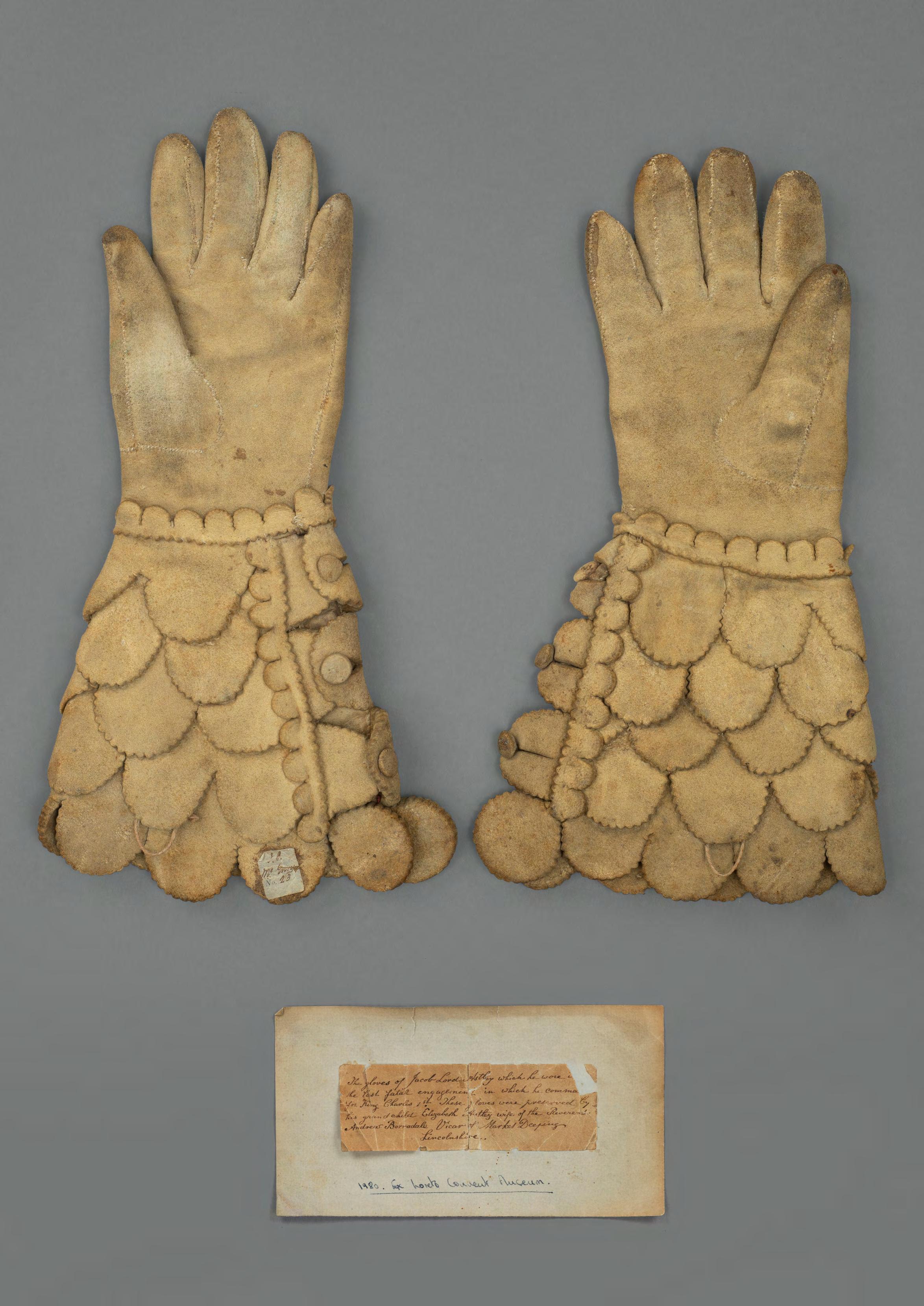
A Very Rare and Historic Bronze 6-Pdr ‘Drake’ Cast for the Rotterdam Admiralty by Cornelis Ouderogge, from the site of the Battle of Lowestoft fought on 13 th June 1665 dated 1658
The Netherlands, Rotterdam. Bronze 202 cm / 79.5 in (barrel length)
PROVENANCE
Recovered from the wreck of ‘De Eendracht’ (73 guns), the flagship of Lieutenant-Admiral van Wassenaer, Lord Obdam, which exploded in action against ‘The Royal Charles’ during the Battle of Lowestoft, a decisive naval action of the Second Anglo-Dutch War. The wreck site is protected by law and is under the management of the Cultural Heritage Agency of the Netherlands.
Private collection, The Netherlands

The Battle of Lowestoft, 1665, etching by Thomas Doesburgh, 1690-92. In the foreground the powder magazine of the Dutch Flagship Eendracht explodes. Rijksmuseum, Amsterdam.

This finely preserved gun was cast for the Admiralty of Rotterdam, known also as the Admiralty of de Maze, and the arms of the admiralty are cast in relief over the first reinforce section of the barrel. On a ribbon scroll immediately below is the dated inscription ’16 D. ADMIRALITEYT TOT. ROTTERDAM 58’.
The remainder of the barrel is further cast in relief, with astragal mouldings at either end of the chase section, each of these in turn backed by bands of tulip ornament (the forward bands lightly corroded), a broader band of scrolling foliage forms a border for the ogee at the head of the reinforce, the foliage framing at its centre the symbolic device of the Union of the Seven Provinces of the Republic, two hands meeting to clasp a sheaf of seven arrows.
With continued decorative mouldings forming borders at both ends of the reinforce and about the vent-field, raised moulded base-ring cast with the founder’s signature ‘CORNELIS . OVEROGGE . FECIT . ROTTERDAM’, and with the unit weight ’74.6’ below. With a prominent cascable button cast in the form of a nodular and leafy pod, its base projecting from the cascable formed as an acanthus calyx against a stippled ground.
Complete with a pair of trunnions and a pair of lifting handles, the latter in the form of marine monsters finely cast in the round. The gun is preserved in professionally conserved condition, with a natural green patina throughout. The ornamental bands immediately to the rear of the muzzle show light seabed corrosion.


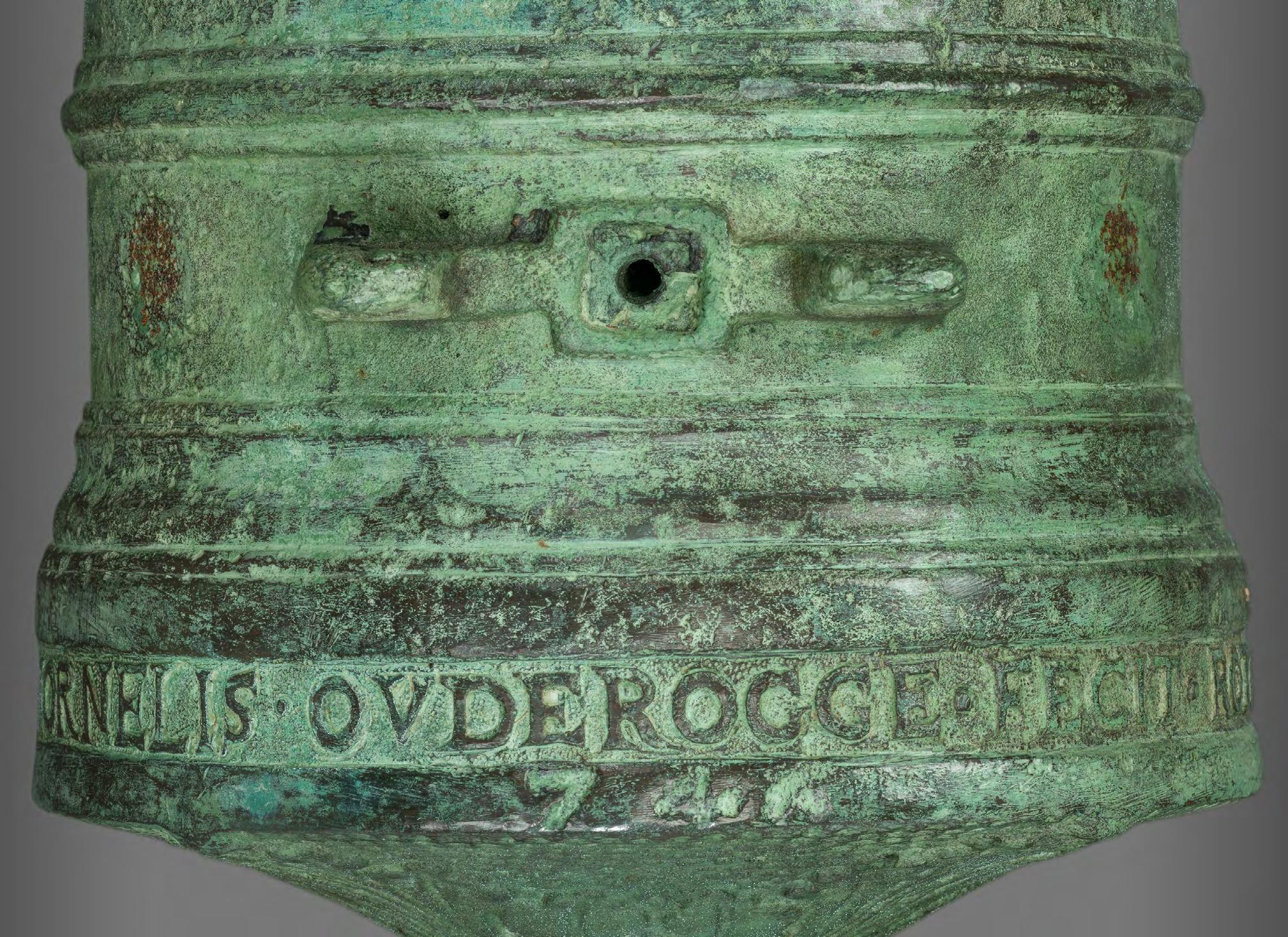
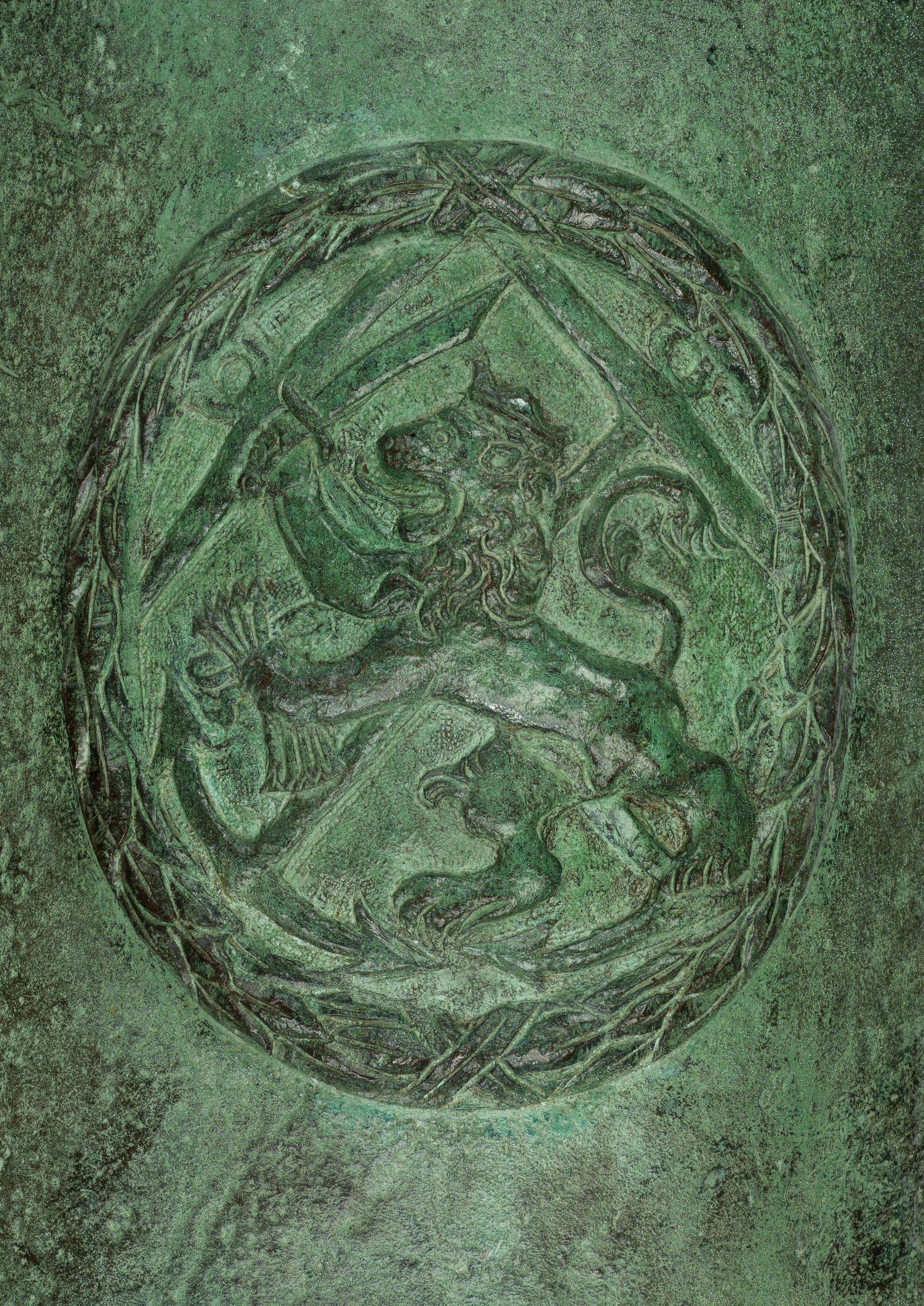
The proportions and design of this gun anticipate many of the features belonging to the Dutch Seven Provinces pattern for ships’ ordnance formally adopted in 1666, although in this respect this gun is not unique, with the comparable example of a 24-pdr from the same foundry, and again from the Eendracht wreck, being dated as early as 1631.
The shape of the muzzle section conforms to that laid down for gun barrels of 6, 12 and 18-pdr calibre. Cornelis Jansz Ouderogge (1599/1600-1672) was the son of the bell and gun founder Jan Cornelis Ouderogge of Amsterdam and Rotterdam. He ran the Rotterdam gun foundry from about 1642, jointly with his brother Dirk who died in 1649, after which Cornelis continued the business until his death.
Two 6-pdr Drakes cast by Cornelis Ouderogge in 1662 and 1666 respectively, each for the Admiralty of Rotterdam, are now in the Rotterdam Maritime Museum. Another Drake dating from about 1650 was recovered near Rotterdam at the archaeological site ‘Eurogeul 12’.
A further example of a 6-pdr by Ouderogge was formerly in the important collection of antique Netherlands ordnance of H.L. Visser, Wassenaar (HVC89). This example is dated 1667 and was also made for the Rotterdam Admiralty. Notably, the casting is less ornate than on the present example, the arrows device of the Union of Provinces is not included and the arms of the Rotterdam Admiralty are crowned.
The Eendracht went down with the loss of 404 lives out of a ships’ complement of 409. Admiral Jacob van Wassenaer, the commander of the Dutch Fleet had himself been killed by a cannon ball shortly before the magazine explosion. The Eendracht had been completed in 1654 and had taken part in a number of engagements under van Wassenaer’s
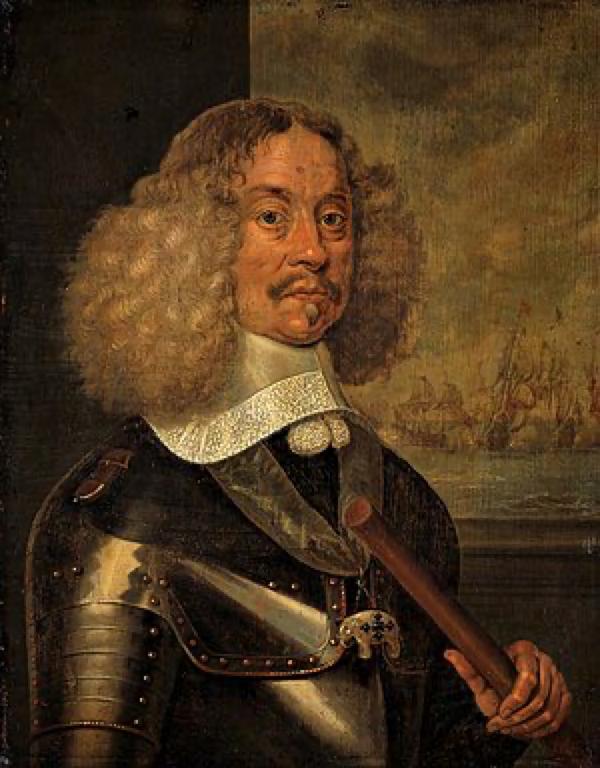
command. The present gun, cast in 1658, may have fired in anger during the Eendracht’s fight against the Swedes in the Battle of the Sound, on 8th November of that year. It will certainly have done so in its heated fight with The Royal Charles under Sir William Penn.
In 1987 in the course of their survey of the North Sea the Dutch Ministry of Infrastructure and the Environment discovered at a depth of 38m an area full of bronze cannon, at Nieuwe Ankerplaats. Fragments of wooden ship construction and rope were present also. Similar finds, though in smaller numbers, were found in the vicinity of the site, corresponding with the explosive destruction of the Eendracht
Portrait of Jacob, Baron van Wassenaer, Lord of Obdam, Lieutenant Admiral of Holland and West Friesland. Killed at the Battle of Lowestoft, shortly before the destruction of his Flagship, the Eendracht.
An Historic Pair of Bronze Cannon Cast by the Spanish Gunfounder Mathias
Solano,
Dated
1747, In 1798 they were Given by King George III of England to Major General John Graves Simcoe
Spain, The Royal Gun foundry, Seville. Bronze.
104 cm × 28.5 cm / 41 in × 11 in Length including stand: 186 cm / 73 in
PROVENANCE
Removed in 1798 from among the captured rebel ordnance in San Domingo
Shipped from Port au Prince to Jamaica, thence in October 1799 dispatched to London, with onward shipping to Plymouth; Received at the Devon port of Kingsbridge in December 1803 Installed at Walford Lodge, General Simcoe’s family seat in Honiton, Devon; Passed down through the Simcoe family, the cannon remaining at Wolford Lodge until their sale in 1923 to Herbert K. Reeves, Esq., of Porlock, Somerset
Presented by Reeves in June 1940 to Leatherhead Urban District Council (now the Mole Valley District Council) and for many years displayed outside the council chambers in Leatherhead; sold Christie’s, 2 November 2005, lot 129
Correspondence of February and March 1798 between Major General Simcoe and Prince Frederick, Duke of York, on behalf of his father King George III, brought about the royal presentation of this pair of very finely cast historic bronze cannon. Simcoe was undeniably deserving, having endured the miserable tropical climate and the constant danger of fatal disease when serving as commandant of the colony of San Domingo, recently captured from the large Haitian revolutionary force of rebel slaves and French republicans.
Unfortunately for the long-suffering Simcoe, the much anticipated royal gift, having at last arrived from Jamaica, was now subject to customs duty as foreign-made goods. Prior to onward shipping to Plymouth, a customs officer’s letter dated 28 April 28 1800 recorded the terse demand.

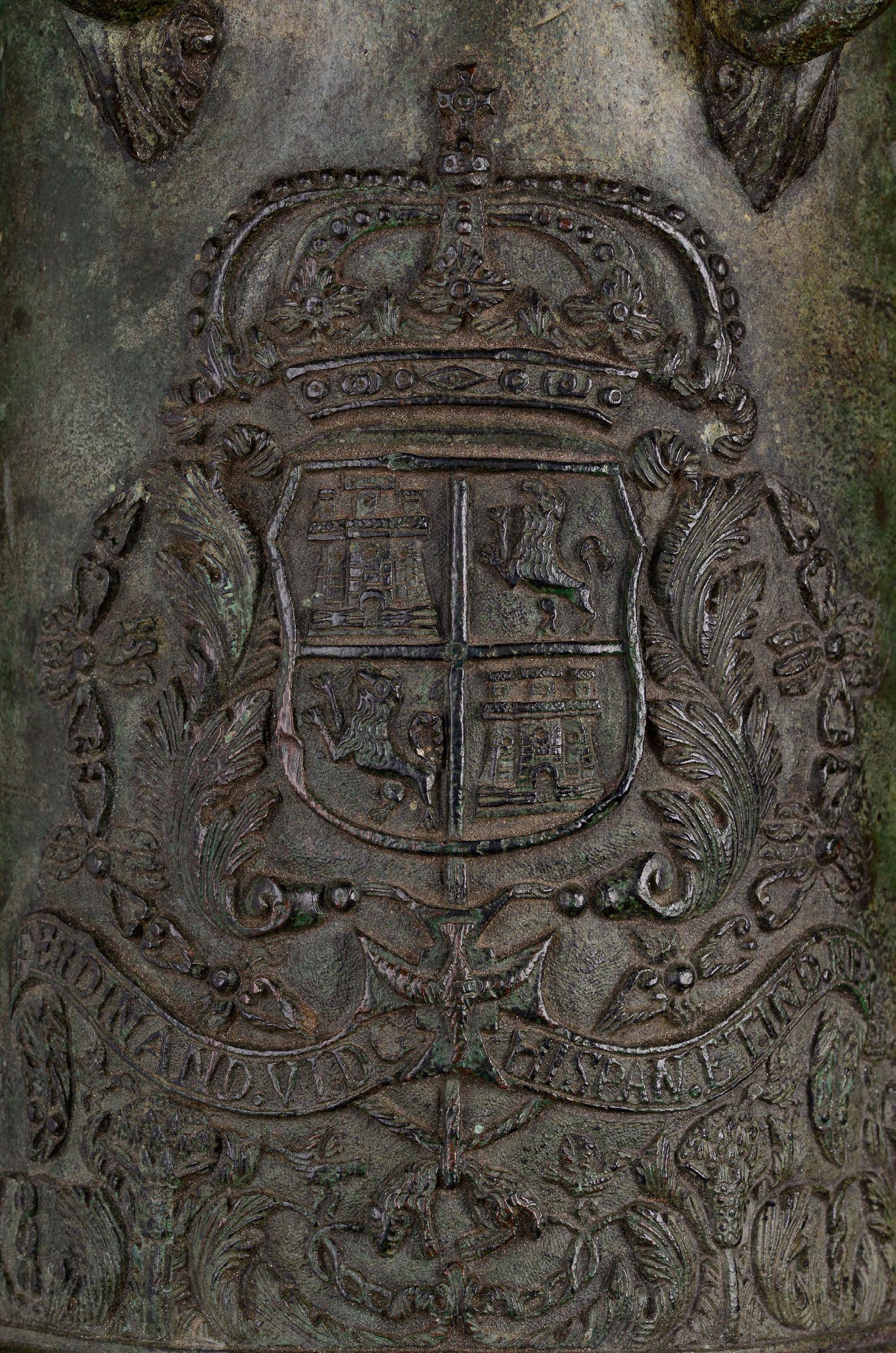
John Graves Simcoe (1752–1806) achieved fame and a deservedly lauded reputation as the first lieutenant governor of Upper Canada: a lake, a town and a county in Ontario are all named after him. Eton and Merton College, Oxford, were followed in 1771 by entry into the 35th Regiment of Foot as ensign. On the outbreak of the American Revolutionary War Simcoe served in New England as adjutant of his regiment. In 1775 he obtained a captaincy in the 40th Regiment of Foot and was severely wounded at the battle of Brandywine River. His bravery and unusual abilities in the field brought about Simcoe’s promotion in October 1777 to the local rank of major commanding the irregular green-clad Queen’s Rangers. Simcoe trained these troops in field operations unconventional within the British army of the period, going on to conduct skirmishing and scouting operations with tactical stealth, frequently infiltrating behind enemy lines in New Jersey, Pennsylvania and Virginia. Simcoe was captured near Hillsborough, New Jersey, in 1779, barely with his life, and was released under exchange at the end of that year. He was also among the troops surrendered by Cornwallis at Gloucester Point in 1781. Simcoe was invalided home in early December 1781 and appointed colonel.
Then in 1791, upon the division of the two Canadas, Simcoe was appointed the first lieutenant governor of Upper Canada under Lord Dorchester, the governorin-chief. He initially selected Newark (now Niagara) as his capital, in 1793 moving the seat of government to Toronto. Under his tenure the province flourished in almost all respects, other than in its relations with the United States, this bias being attributed to Simcoe’s war experiences. Simcoe was appointed major general in October 1794, and shortly thereafter dispatched to San Domingo as commandant of the British garrison established there to put down the Haitian revolution. He returned to Britain in July 1797, was promoted lieutenant general the next year and appointed colonel of the 22nd Regiment of Foot, with command of the defence of the West Country against the threat of Napoleonic invasion.
In 1806 Simcoe was appointed commander-in-chief in India, but was first ordered in August to accompany Admiral Lord St Vincent to Lisbon, to observe and report on the impending threat of the Napoleonic invasion of Portugal. Simcoe became mortally ill on the voyage; he was returned to England but died on 26 October 1806.
Mathias Solano, the founder who cast this fine pair of cannon, belonged to a family of Spanish gun founders who were working over two or possibly three generations. He was director of the royal gun foundry at Seville from about 1703 to 1755. In earlier years he had also cast guns in Valencia and Pamplona. The present pair of guns is recorded in Gunfounding & Gunfounders, by A. N. Kennard, together with a record of other examples cast by Mathias in Seville, namely three in the Museo del Ejercito, Madrid and another in the Musee de la Marine, Paris.
This pair of cannon is of four-pounder calibre, conforming to the Spanish ordnance regulations of 1743 for cannon easily mobile for field use. The present guns in fact conform exactly in all respects to the designs and specifications for Spanish bronze artillery of this period. The state coat of arms cast in relief over the reinforce sections of the barrels is that of the Spanish Bourbon King Ferdinand VI (1713–1759). The Order of the Golden Fleece and the Order of the Holy Spirit encircle the arms and surmount a scroll cast with the Spanish royal title FERDINAND. VI DG HISPAN. ET IND. REX (Ferdinand VI by the grace of God King of Spain and the Indies). Additional scroll-work is held by an encircling band of foliage and expanded flower heads, the base ring signed by the founder SOLANO FECIT. HISPALI. ANNO 1747 (Solano made this, at Seville in the year 1747). The cascabel is drawn out to a globular button emerging from a leafy calyx.
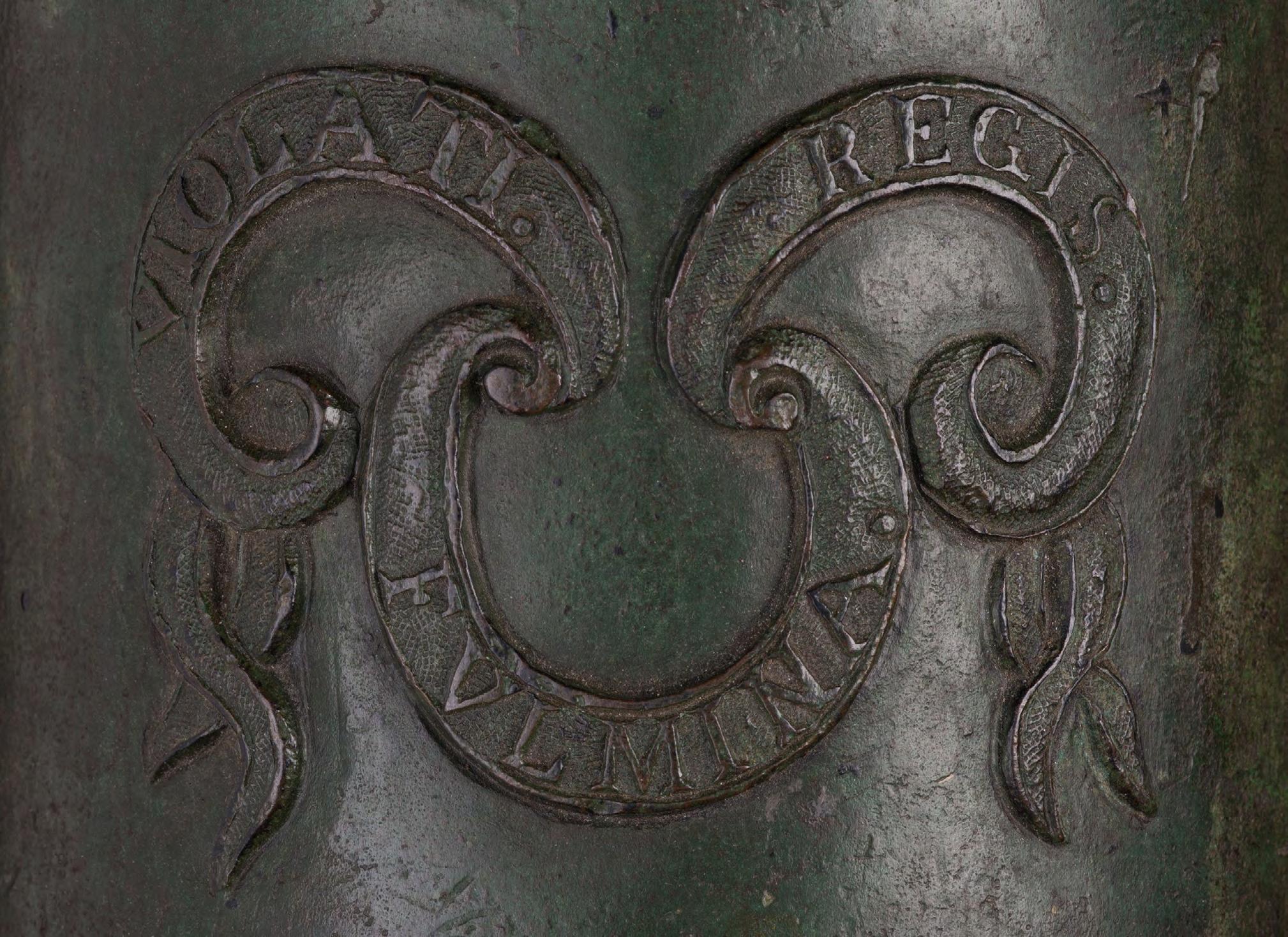
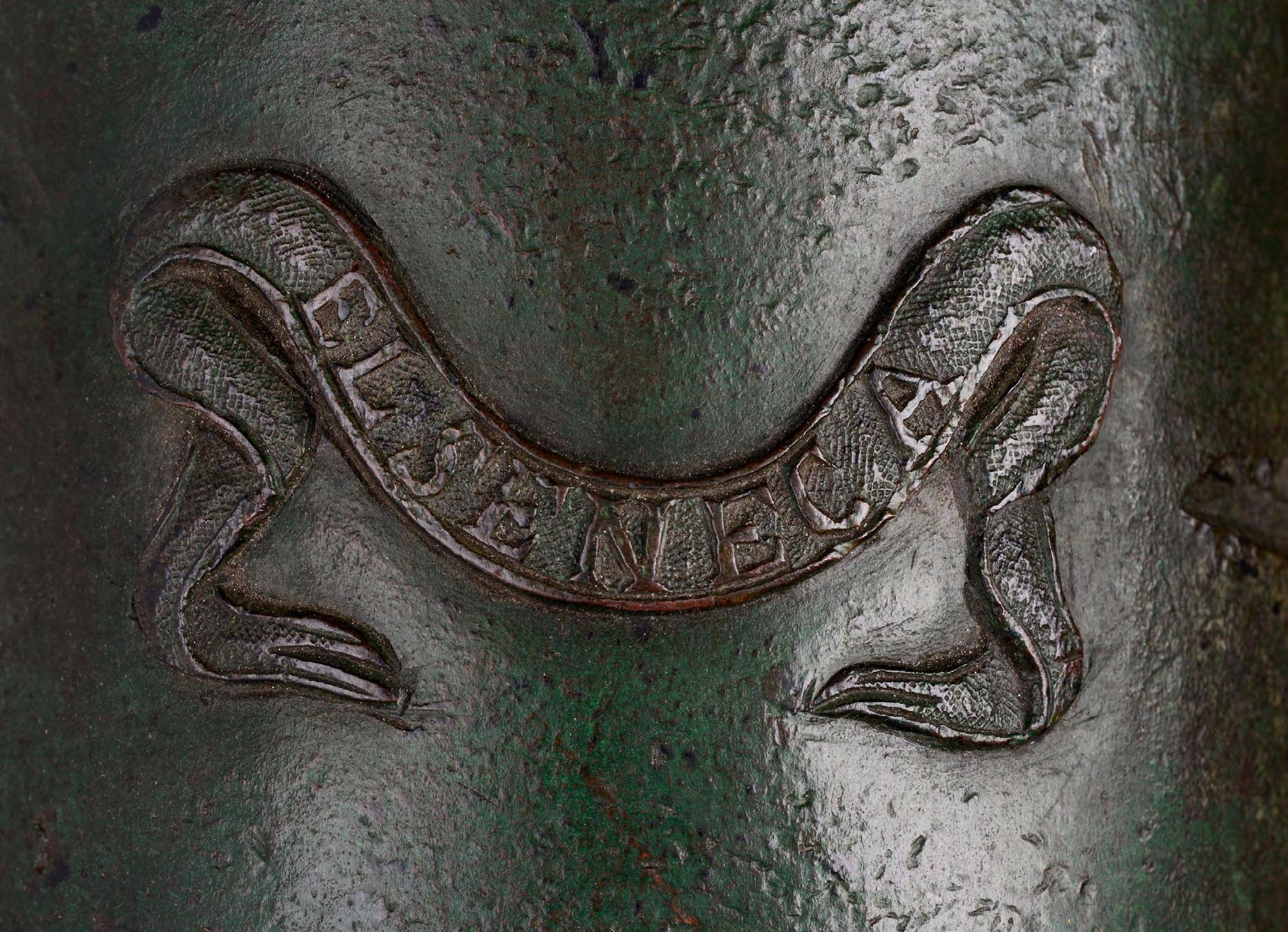
Within the mouldings and bands of ornamental foliage so beautifully cast in low relief, the motto VIOLATI FULMINA REGIS (‘THUNDERBOLTS OF AN OUTRAGED KING’) is prominent on a scroll, as is the name of each gun, one being EL MARTE (Mars, the Roman god of war), the other EL SENECA (after Seneca the Younger). The naming of one of these guns after the roman god of war is obviously appropriate to its purpose; the naming of the other, ‘El Seneca’, was a Spanish celebration of the figure from classical Roman history, Lucius Annaeus Seneca (the Younger, about 4 BC–AD 65), who was subsequently claimed as the heroic son of the southern RomanoIberian capital of Cordoba, his birthplace in Andalusia. Seneca was a Stoic philosopher, essayist, dramatist and statesman of Rome. He was also tutor then advisor to the Emperor Nero, until being compelled by the emperor to commit suicide for alleged complicity in a plot to assassinate him. Seneca was upheld as a paragon by the early Christian church, and his life and works widely celebrated in the culture of the medieval period and throughout the modern period.
REFERENCES
February 1798-September 1806: unpublished transcriptions of contemporary correspondence containing direct references to the lengthy and complex acquisition and transport of these guns. These include letters from Major-General Simcoe, and one in reply from H.R.H. Frederick, Duke of York on behalf of the king. Together with copies of modern correspondence, including letters from the former owner Herbert K. Reeves, Esq., and others also in direct reference to the provenance and to the study of these guns.
A Pair of Serpentine Appliques
late 17th – 18 th century
PROVENANCE
Eric Vaule collection, United States
Formed as an opposing pair of serpents tightly looped and coiled in representation of ‘concertina’ movement, and each constructed almost entirely from a single piece of very light-gauge iron hammered to hollow-convex section. Each fitted with a separate barbed finial at the distal end, finished ‘black from the hammer’ and pierced with holes for attachment nails or rivets.
The symbolic menace inherent in the monstrous heads of these creatures is accentuated over the length of their bodies by naturalistic creases and undulations, this embossing giving chilling emphasis to their replicated movement. The realistic multidimensional rendition of iron grotesques such as this immediately recalls the earlier use of appliques in the graphic decoration of the finest German horse armour within the ‘High Gothic’ period of the late 15th century.
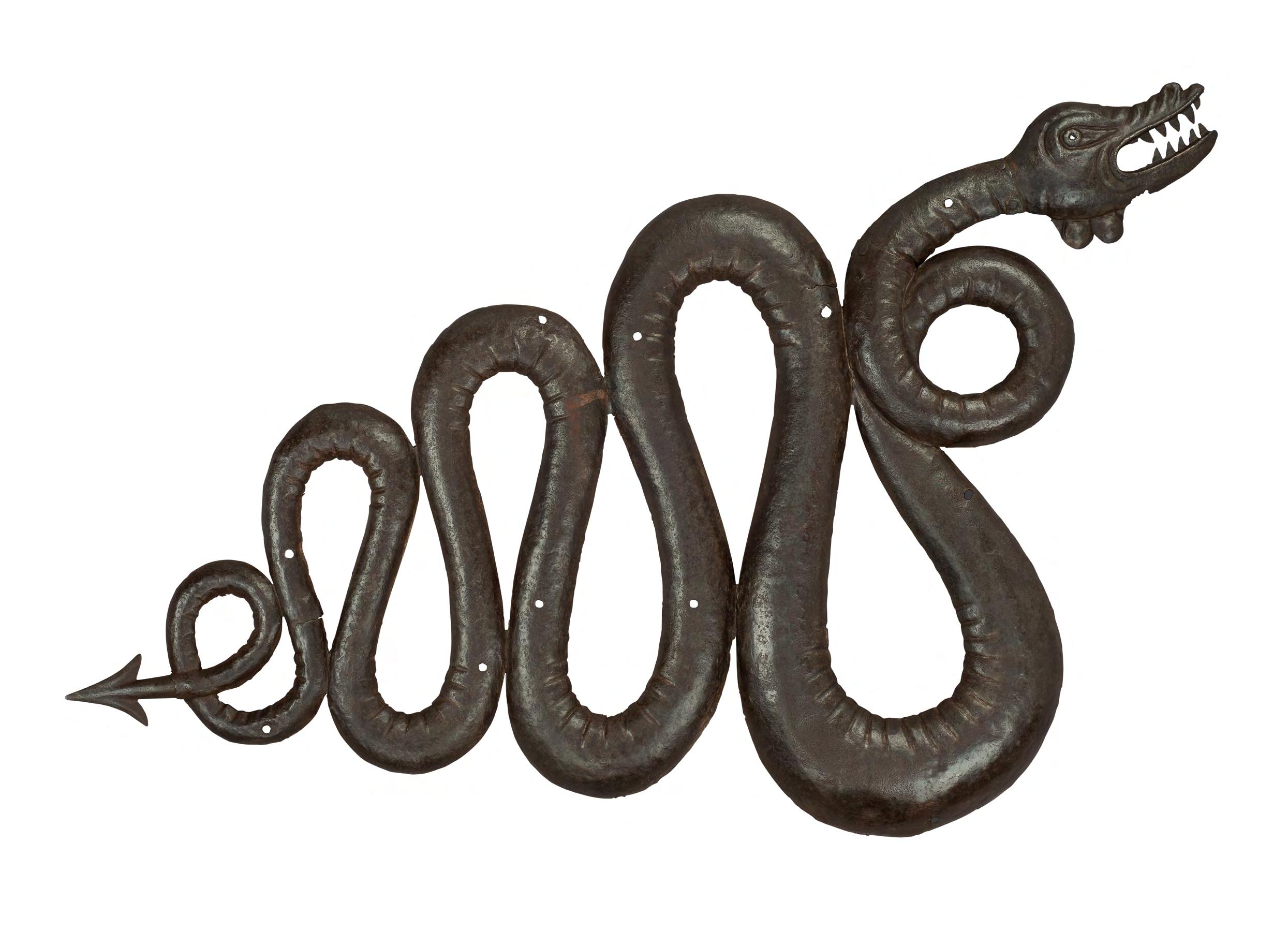
Probably the best surviving example of this use of embossed iron exists in the applied large dragon which extends over the rear portion (the crupper) of the horse armour made for the Emperor Friedrich III in 1477; the dragon’s head which provides an elaborate opening to the tailpiece and the rows of triangular teeth exposed in its gaping maw closely resemble those of the present serpents (Kunsthistorisches Museum, Vienna, A 69). Another applique, again comparable, is the monster which similarly forms an extended tailpiece on the crupper of the Gothic horse armour made for a member of the Ducal AnhaltZerbst family (Royal Armouries, Leeds, VI. 379).
With the end of this fashion in equestrian armour the wider use of decorative applied light ironwork continued little-changed in technique throughout central and eastern Europe, well into the 18th century. By extension of this tradition iron grotesque punishment masks or ‘Branks’ gave free-reign to the imagination, as did ornamental monstrous grotesques across many secular and ecclesiastical settings. Typically doors and shutters might be embellished in this style, these being the likely placement of the present pair of serpents.
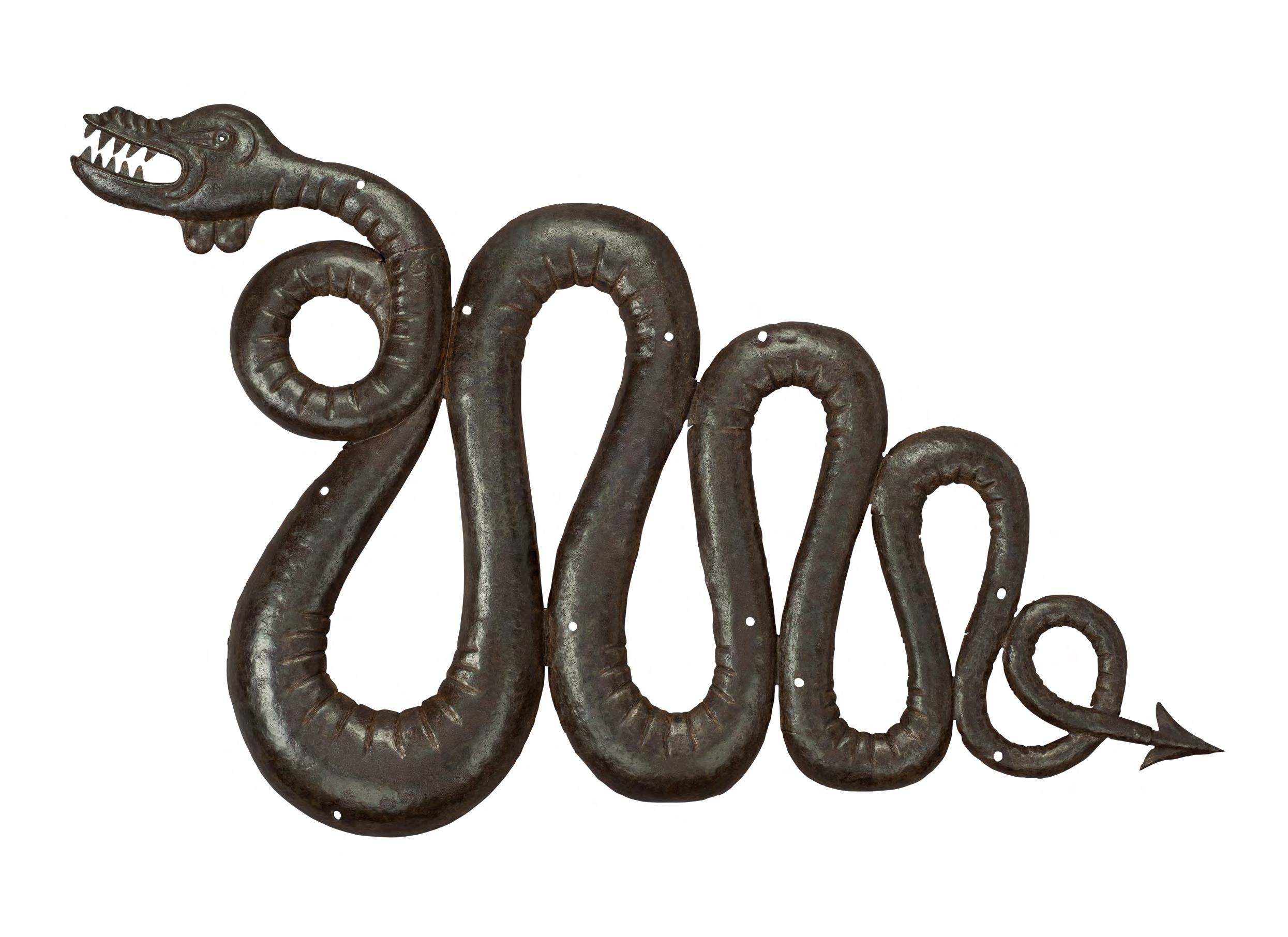
A Magnificent and Rare Royal British or Hanoverian Huntsman’s Satchel
c. 1714 – 27
Germany. Silk, leather, cotton, steel 35 cm / 13.78 in (diameter)
Provenance
The armoury of the Dukes of Brunswick-Wolfenbuttel and their successors, the Kings and Princes of Hanover, successively housed in the Wolfenbuttel Zeughaus, Schloss Blankenburg and Schloss Marienburg, Lower Saxony.


A Large Masterpiece Chest or Door Lock
c. 1720
Germany, Munich. Brass, steel PROVENANCE
From the collection of The Lord Astor of Hever, sold The Hever Castle Collection, Sotheby Parke Bernet & Co., Friday 6 th May 1983, sold as lot 217 for £6,820
With brass front-plate, pierced and engraved with interlacing foliate straps and trellis work, shooting four bolts and one catch, and retaining its original key with complex cut wards, working within an octagonal tower cupola. The steel back-plate pierced with scrolling foliage and shell-work, the angle plate and bolts struck with a mark, the figure of a monk, for the City of Munich.
